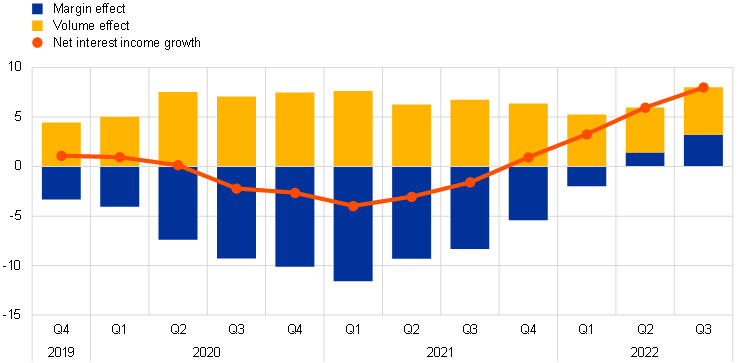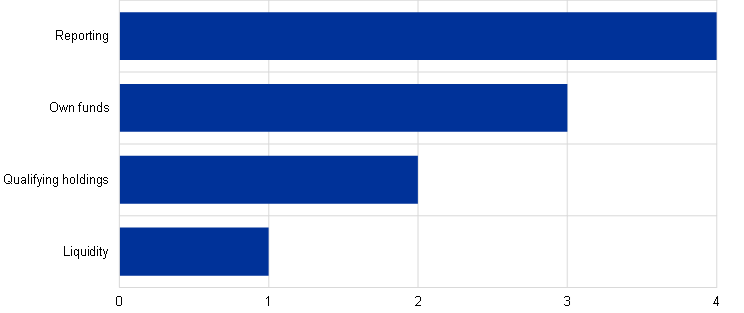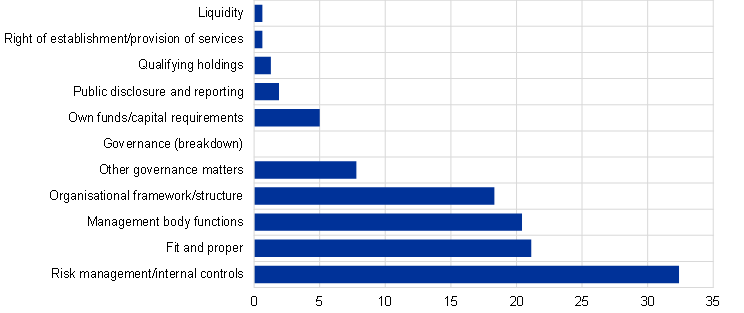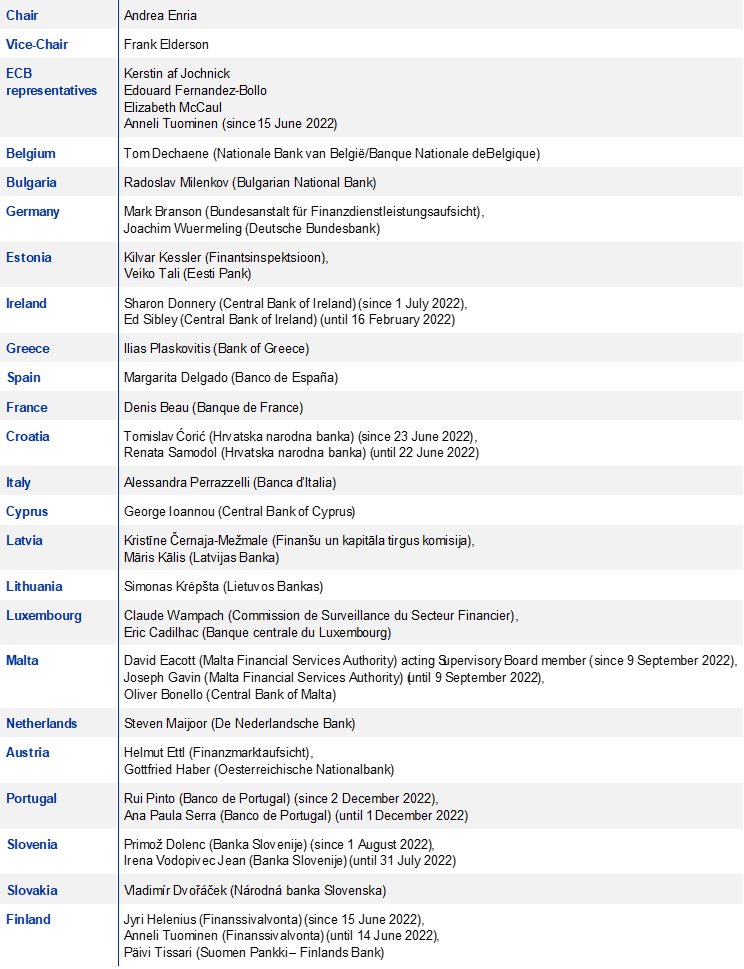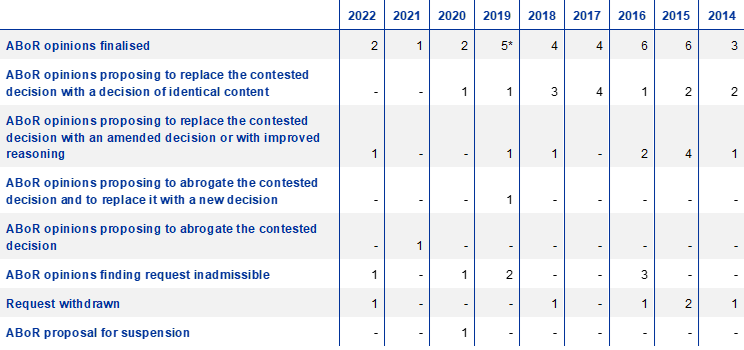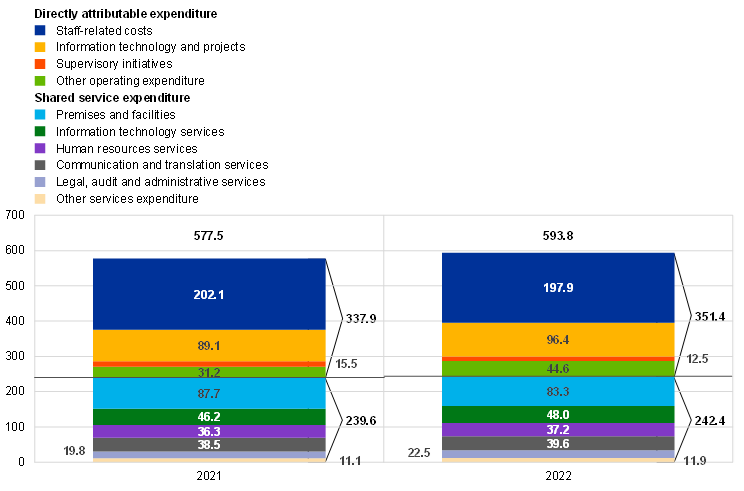Foreword by Christine Lagarde, President of the ECB
The cut-off date for the foreword by the President and the interview with the Chair of the Supervisory Board was 28 February 2023.

2022 was a challenging year for people in the euro area. The economy was well on the way to recovering from the pandemic but was negatively affected by Russia’s unjustified invasion of Ukraine. While the immediate impact of the war on banks was limited, as few of them had significant exposures to the afflicted regions, banks faced an environment marked by profound economic uncertainty and historically high inflation.
The war-induced energy crisis, combined with supply chain bottlenecks and pent-up demand from the pandemic, led to strong inflationary pressures. In such a setting, it is the task of monetary policymakers to ensure that inflation does not become entrenched and that it returns to target in a timely manner. The ECB acted accordingly and embarked on monetary policy normalisation by ending net asset purchases and then raising interest rates.
Rising interest rates affected the performance of supervised banks in 2022. Profitability, which serves as banks’ first line of defence against shocks, was supported by net interest income, which increased for the first time in several years. This, together with the continued improvement in asset quality, with non-performing loans having fallen to their lowest level since 2015 when banking union data measurements began, ensures that our monetary policy impulses are transmitted smoothly by banks to the euro area economy.
However, in an environment where funding conditions are tightening, banks must continue to tackle concerns about their governance and their internal risk control frameworks. European banking supervision is therefore keeping a close eye on the build-up of risks.
Meanwhile, even before 2022, banks needed to adapt their business models to the structural challenges posed by digitalisation and climate change, which have been exacerbated by Russia’s unjustified war in Ukraine. The war has further heightened the risk of cyberattacks, and as Europe weans itself off Russian oil and gas, transition risks are accelerating. These, and increasing physical risks, require a proactive and comprehensive approach from banks to become more resilient to climate and transition shocks.
The ECB has already undertaken a number of significant steps to make sure banks are up to the challenge. We will not relent in our efforts and will keep on playing our part in ensuring that Europeans continue to rely on a robust banking sector.
Introductory interview with Andrea Enria, Chair of the Supervisory Board
The cut-off date for the foreword by the President and the interview with the Chair of the Supervisory Board was 28 February 2023.

A lot happened in 2022. How was it for ECB Banking Supervision?
In one sense, 2022 was a year in which we went from one crisis to another. At the beginning of the year, all signs pointed to a steady recovery from a pandemic that had turned our lives and economies upside down. I vividly remember that, for the first time in a long while, banks and analysts were looking to the near future with some optimism, which was just when Russia unjustifiably invaded Ukraine. First and foremost, Russia’s war has put Ukrainians through untold suffering. It has also brought economic and financial turmoil to Europe and right across the globe, gradually turning into a fully fledged macroeconomic shock.
We had to react quickly and be agile in our supervision in order to address the fast-changing economic circumstances and the resulting challenges for the banking sector. A handful of banks were affected directly by the war and sanctions, owing to their direct exposures to or interlinkages with Russia. But all banks alike were prone to being adversely affected by the energy and commodity shock, as well as by the environment of persistently high inflation coupled with the fast-paced normalisation of monetary policy.
Yet, in another sense, it was a year of development for ECB Banking Supervision. Our staff went back to working in the office more regularly, and it has been a real pleasure to see our offices buzz with activity once again. I have enjoyed chairing more in-person Supervisory Board meetings and I was very happy to be able to visit several national competent authorities in person.
We also made some good progress towards greater integration between the ECB and the national competent authorities that participate in the Single Supervisory Mechanism (SSM). We are further fostering a common SSM culture and integrated career paths, creating opportunities for supervisors to work more closely throughout the supervisory cycle, pursuing more coordinated planning and budgeting, further developing SSM tools for collaboration and introducing common technologies for both supervision and training.
How have banks fared following the Russian war in Ukraine?
We should make a distinction here between banks with direct interlinkages to Russia and all other banks.
A handful of banks were directly affected by the geopolitical events, mostly on account of the sanctions framework. Sberbank Europe AG, a banking group headquartered in Austria with Russian ownership, was, together with its subsidiaries in Croatia and Slovenia, hit by the reputational impact, and experienced significant deposit outflows. The bank was ultimately declared failing or likely to fail and exited the market. Another example of this kind was RCB Bank LTD, a Cypriot bank in which the Russia-based bank VTB was a significant shareholder. Following the imposition of sanctions and the changed geopolitical situation, the bank opted for a voluntary wind-down of its banking business, which led to the withdrawal of its banking licence.
Euro area banking groups with a direct presence in Russia are also prone to incurring losses should they wish and manage to exit that market. For some, this risk has already crystallised, but with a contained and manageable impact.
So far, the banking sector as a whole has proven very resilient to the war-induced macroeconomic shock, even more so than we had expected based on the vulnerability analysis we published in May 2022. The aggregate Common Equity Tier 1 ratio stood at 14.7% at the end of the third quarter of 2022, only slightly below the level seen at the end of 2019. Asset quality continued to improve, with the volume of non-performing exposures held by significant banks dropping to €349 billion at the end of September 2022, the lowest level since supervisory data on significant banks were first published in 2015. Profitability was also the strongest on record, with banks’ average return on equity reaching 7.6% in the third quarter of 2022.
On the back of this positive performance, banks have planned distributions for 2023 which are pretty much in line with the catch-up in dividends and buybacks they made in 2022, coming out of the pandemic-related restrictions. We have not objected to any bank-specific plans, but we have engaged in a bilateral supervisory dialogue with all of the banks as part of our business-as-usual assessment of capital trajectories.
Towards the end of 2022, the macroeconomic outlook started to improve again. But this does not mean that the macroeconomic shock is over. If inflationary pressures should persist, the necessary fast-paced monetary policy normalisation process could in turn affect specific banks’ portfolios and business lines, bringing a wide range of challenges and creating potential winners and losers.
Speaking of challenges, which are the key challenges facing European banks in your opinion?
The first set of challenges is conjunctural.
If the energy crisis is not remedied, credit risk may increase in those corporate lending portfolios where economic activity is most dependent on energy. More generally, the slowdown in our economy towards the end of last year was accompanied by a resurgence in corporate defaults, which calls for heightened vigilance regarding asset quality.
The fast-paced normalisation of monetary policy – and particularly the increasing interest rates – was an important driver of the recovery in profitability. However, this may also lead to a deterioration in asset quality, with borrowers struggling to repay their debt, across a set of loan portfolios that are particularly sensitive to interest rates.
This shift in the interest rate environment could also cause disorderly adjustments in some segments of the financial market and in non-bank financial institutions, increasing counterparty credit risk among banks that have concentrated exposures towards those particular markets and market players.
Beyond the conjuncture, the normalisation of interest rates and the quantitative tightening may force some banks to revise their medium-term funding strategies and place greater focus on liquidity and funding risks.
The 2022 Supervisory Review and Evaluation Process (SREP) shed new light on a set of persistent weaknesses. Risk control deficiencies are still affecting credit risk scores, and there were a number of findings on the effectiveness of management bodies, risk management, compliance and internal audit functions. Our concerns about banks’ risk controls and governance are exacerbated by the uncertain external environment, as backward-looking indicators of risk levels can provide an inaccurate picture when forecasting future trends and risks.
The digital transformation, as well as climate-related and environmental risks, are also key medium-term challenges for our banks and require immediate and focused attention.
You mentioned monetary policy normalisation. How are European banks positioned for the changing interest rate environment?
Interest rates going up is usually a good news story for banks. It means they can earn more from the interest rate margin – the difference between the interest rate that they charge for loans and the interest rate that they pay on deposits. The normalisation of interest rates and the boost that this long-awaited shift provided to net interest income is at the core of banks’ positive performance in 2022. For the first time in several years, net interest income increased not only because of expanding lending volumes, but also because of expanding net interest margins.
Banks and analysts alike expect the profitability outlook to remain similarly positive this year. According to our data, if the macroeconomy develops as currently expected, further orderly increases in interest rates will likely support the sector’s average earnings.
However, if we depart from the baseline scenario and consider more adverse developments, things may go differently. For specific portfolios and business lines, the costs associated with a deterioration in asset quality may outweigh the income benefits as interest rates increase, particularly if economic growth slows down. Borrowers may struggle to repay their debt across portfolios that are traditionally very sensitive to the cost of credit. Consumer lending, real estate lending and leveraged finance are notable examples of areas of supervisory focus.
As I mentioned, financial markets can turn disorderly during the interest rate adjustment process. The prolonged period of low interest rates favoured an unprecedented increase in debt levels, with some less or non-regulated entities taking highly leveraged and often very concentrated positions, which can quickly unravel if the economic outlook or the interest rate environment changes unexpectedly. The failure of Archegos in 2021 and the liability-driven investments turmoil in the United Kingdom in 2022 show how, in the absence of policy interventions, such episodes can easily spill over to the banking sector.
Increasing interest rates and quantitative tightening require banks to sharpen their focus on liquidity and funding risks. If banks do not swiftly adapt their risk management and strategic steering capabilities, a more challenging funding environment may call into question overly simplistic and clearly obsolete asset and liability management strategies, such as the carry trade practices adopted by some banks to benefit from the extraordinary monetary policy support. There is a risk that banks might be caught off guard.
Banks’ risk controls and internal governance were a focus area in 2022. How much further improvement do you expect to see from banks in this area?
To be honest, it’s an area where we are not seeing enough progress.
First, in 2022 there continued to be shortcomings in data aggregation and reporting owing to deficiencies in the effectiveness of data governance and data quality management procedures, fragmented IT landscapes, and the limited scope and ambitions of banks’ remediation projects. This makes it difficult for their management bodies to have the information they need to be able to manage risks and steer the strategy of their organisation.
Second, several banks still needed to further improve their internal control functions, particularly to address insufficient staffing, the low stature of the function and deficiencies in processes, such as compliance monitoring programmes and the definition of banks’ risk appetite. The targeted reviews we carried out during 2022 looked at banks’ risk management practices in relation to areas linked to the pandemic crisis and the normalisation of interest rates, notably commercial and residential real estate lending, interest rate and credit spread risks in the banking book, and counterparty credit risk.
To facilitate tangible progress where it is most needed, we are determined to make full use of all the supervisory tools and powers available to us under EU and national law. Where qualitative measures have not been effective enough in ensuring banks follow up and remediate identified weaknesses in a timely manner, we may use targeted Pillar 2 capital requirements, enforcement measures or sanctions to ensure that appropriate progress is made. To make our supervision even more effective, where banks’ progress is too slow and their results are persistently unsatisfactory, the ECB will reconsider how it escalates supervisory measures within a clearly defined time frame.
Some people say that European banking supervision is too intrusive, too burdensome, and imposes higher requirements which are harmful to the competitiveness of EU banks. How would you respond?
First of all, it is simply not true to say that regulatory and supervisory capital requirements are higher in the EU than in other jurisdictions such as the United States or the United Kingdom. We frequently meet with our colleagues from the US and the UK authorities and compare the requirements that we place on our banks, and I must say that we are in the same ballpark as our peers. If anything, the capital requirements for the largest systemically important European banks – which are the ones that truly compete across global markets – are a little bit lighter.
That being said, we are always willing to listen to criticism. In fact, we are currently making changes to our supervisory processes that should help to address some of the industry’s concerns.
We are introducing a risk tolerance framework, which will allow supervisors to intensify their efforts where they are most needed, facilitating the transformation of strategic SSM-wide supervisory priorities into supervisory planning for each specific bank. The risk tolerance framework does not relax supervisory standards or the intensity of our supervision of any given bank. Instead, it increases our focus on risk-based supervision. This also means banks should expect less tick-the-box supervision, potentially fewer requests and a reduced reporting burden, as we will not apply the full, comprehensive supervisory manual to each bank. We will instead be guided by bank-specific priorities. This is an important step towards making our supervisory processes more agile, adaptive, proportionate and risk based.
Through the new multi-year SREP, our supervision will also become less burdensome, as we will spread our supervisory interactions with the banks on different risk areas across multiple years rather than trying to cover everything each year. This will also help us to be more risk focused by prioritising the most important risk areas in any given year. We are also awaiting feedback from an independent panel of experts that is evaluating our SREP process and we will consider further increasing transparency over our methodologies. All of these initiatives are geared towards making our supervisory processes as attuned as possible to the risks that supervised banks may have to contend with in the future.
1 Banking Supervision in 2022
1.1 Banks under European banking supervision in 2022: performance and main risks
1.1.1 Resilience of banks under European banking supervision
Following the disruption of the Russian war in Ukraine, capital ratios remain sound at pre-pandemic levels
Significant institutions (SIs) had entered 2022 firmly on the path to recovery from the coronavirus (COVID-19) pandemic and with solid capital positions. The initial impact of the Russian war against Ukraine was contained, affecting only a very limited number of banks with direct exposures to the areas involved in the war. However, this rapidly evolved into an energy crisis and a wider macroeconomic shock characterised by persistent inflationary pressures and the fast-paced normalisation of monetary policy. Despite a decline in the first half of 2022, the euro area banking sector remained resilient, with the aggregated Common Equity Tier 1 (CET1) ratio standing at 14.7% at the end of the third quarter of 2022 (Chart 1), only slightly below the level seen at the end of 2019. With the banking sector reporting record levels of profitability during 2022, the decrease in the aggregate CET1 ratio was mostly driven by asset growth.
Less significant institutions (LSIs) saw their capital positions deteriorate, albeit remaining strong, as the average CET1 ratio declined by 54 basis points year on year to 17.0% in the third quarter of 2022 on the back of growth in lending and weaknesses in overall profitability. Risk exposure amounts increased by €112 billion or 4.8%, while eligible CET1 rose by just 1.5%.
Chart 1
Capital ratios of significant institutions (transitional definition)
(left-hand scale: EUR billions; right-hand scale: percentages)
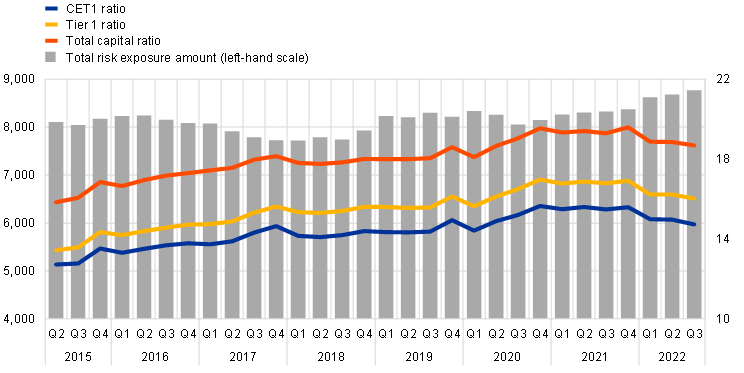
Source: ECB supervisory statistics.
Note: The sample includes all SIs at the highest level of consolidation within the SSM (varying sample).
The aggregate leverage ratio for SIs stood at 5.2% in the third quarter of 2022 (Chart 2), among the lowest levels seen since the start of European banking supervision but still well above regulatory requirements and buffers. The drop (-90 basis points) experienced in the first three quarters of 2022 was largely driven by the increase in exposures, which reflected asset growth in the banking sector, but also, albeit to a lesser extent, by the expiry at the end of March 2022 of the exemption from including central bank exposures in the calculation of the leverage ratio. The aggregate leverage ratio for LSIs stood at 8.6% in the third quarter of 2022, which was lower as compared with the third quarter of 2021.
Chart 2
Leverage ratio of significant institutions
(percentages)
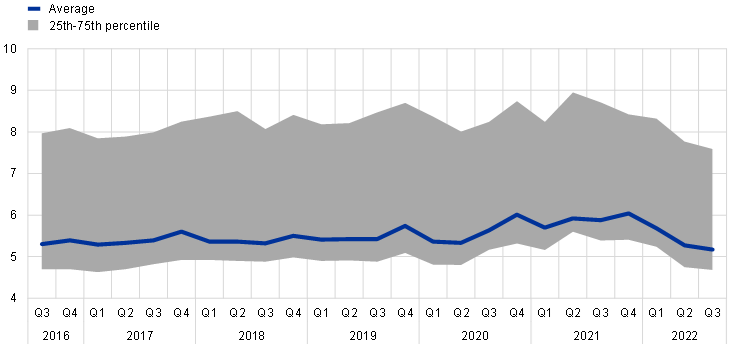
Source: ECB supervisory statistics.
Note: The sample includes all SIs at the highest level of consolidation within the SSM (varying sample).
Box 1
Vulnerability analysis of banks’ resilience: war in Europe
Assessing second and third-round effects of the Russian war in Ukraine on significant institutions
Following the abrupt change in the geopolitical environment as a result of the Russian war in Ukraine, the ECB conducted a vulnerability analysis of banks’ resilience in the first half of 2022. This ad hoc assessment enhanced supervisors’ understanding of banks’ overall resilience.
The vulnerability analysis assessed the resilience and solvency of significant institutions under different adverse scenarios which reflected the high degree of uncertainty at the beginning of the war. Results confirmed the overall resilience of banks under European banking supervision, even when considering second and third-round effects stemming from the Russian war in Ukraine. The aggregate CET1 ratio (in fully loaded terms) was estimated to be 11.6% under a severely adverse scenario, with capital depletion amounting to 3.6 percentage points. It reached 13.1% under the adverse scenario, with capital depletion amounting to around 2.1 percentage points.
Chart A
Waterfall chart of aggregate results under adverse and severely adverse scenarios by risk type
(percentage points of CET1 ratio, fully loaded (FL))
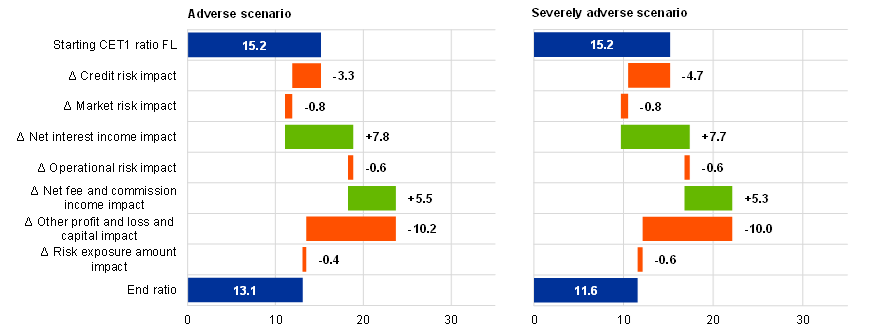
Source: ECB calculations.
Notes: Market risk shocks and resulting impacts, as well as operational risk impacts, were the same under both scenarios. Impacts from net fee and commission income differ only slightly on account of similar financial shocks under both scenarios. For other profit and loss and capital, the impact stems from cost items whose contributions were left constant over the projection horizon.
This in-house exercise combined existing supervisory data with data from the 2021 European Banking Authority (EBA) EU-wide and ECB SREP stress tests, where appropriate. The methodology employed broadly followed the EBA 2021 EU-Wide Stress Test Methodological Note. ECB top-down models were used to assess banks’ credit and market risks, as well as risks to their profitability. New modules examined banks’ exposures to vulnerable sectors, existing stocks of non-performing loans (NPLs), targeted longer-term refinancing operation repayment effects and possible effects from a total loss arising from exposures to Belarus, Russia and Ukraine (“walk-away” effect).
Chart B
Banks that fall below capital requirements in selected stress test exercises
(percentages of total risk exposure amount in the respective sample of significant institutions)
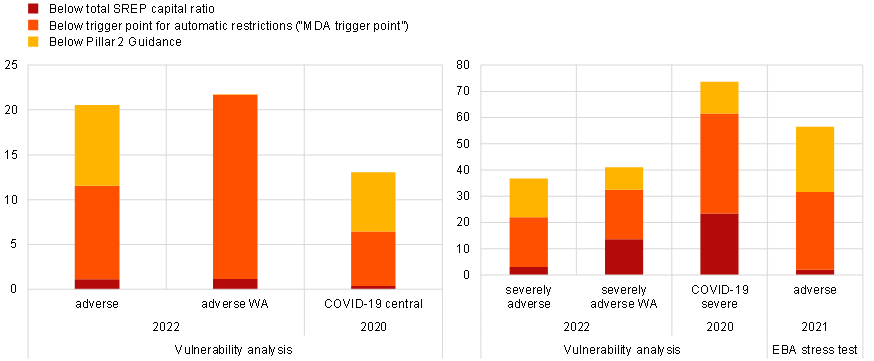
Source: ECB calculations.
Notes: The left panel shows mid-scenarios; the right panel shows severe scenarios under selected stress test exercises, i.e. the 2022 vulnerability analysis (also including “walk-away” (WA) effects), the 2020 COVID-19 vulnerability analysis and the 2021 EBA EU-wide stress test. CET1 ratios under transitional arrangements were compared with the individual total SREP capital ratio, the trigger point at which the maximum distributable amount (MDA) applies and Pillar 2 guidance by bank.
The three scenarios (baseline, adverse and severely adverse) considered were rooted in the March 2022 ECB staff macroeconomic projections for the euro area and are described in detail in the May 2022 Financial Stability Review.
The results of the vulnerability analysis served as input for direct supervisors to challenge their supervised banks, in particular those identified as most vulnerable to the current conditions. Aspects discussed included the severity of scenarios in bank-internal stress tests, stress-testing methodologies, sectoral concentrations, adequacy of provisioning and the challenges to profitability posed by a rising interest rate environment. This type of top-down exercise cannot yet fully replace bank-led, bottom-up stress tests. However, being able to quantify stress impacts centrally proved indispensable for supervisors to quickly assess the possible effects of the Russian war in Ukraine.
Asset quality continued to improve in 2022, keeping the cost of risk under control, but exposures to vulnerable sectors continue to be closely monitored
Asset quality continued to improve over the course of 2022. With no signs of material levels of crystallised credit risk and in the light of the sizeable amount of overlays of provisions built up during the pandemic, after a slight uptick at the start of the Russian war in Ukraine, the average cost of risk reverted to a downward trend over the second and third quarters of 2022, generally returning to pre-pandemic levels. In addition, NPL volumes decreased across virtually all portfolios in the first half of 2022, with some minor increases in consumer and small and medium-sized enterprise (SME) portfolios in the third quarter. Similarly, while there were some increases in underperforming loans, or stage 2 loans in accounting terms, a stable trend was observed by the end of the third quarter, albeit remaining above the peak of the pandemic. Notwithstanding this positive development, the path ahead remains uncertain, with some indications of increased risk, namely in the context of minor pockets of early arrears beginning to develop in some countries in the third quarter of 2022. This could indicate the build-up of heightened credit risk and a potential increase in NPL volumes in the near term. In this regard, there will be continued supervisory monitoring of developments in stage 2 loans, particularly in relation to banks exposed to sectors vulnerable to gas and energy price increases but also for portfolios, such as leveraged finance, consumer lending and real estate lending, which are sensitive to the fast-paced normalisation of interest rates. In this context, the energy price shock caused by the Russian war in Ukraine typically affected economic sectors involved in the production or processing of raw materials, energy suppliers and energy-intensive sectors. For some industries, the energy price shock could exacerbate pre-existing supply chain disruptions arising from COVID-19 restrictions in China and general microchip shortages. High input prices also weighed on construction and could additionally affect large-scale consumers of gas, such as producers of metals, chemicals, food and beverages. Supervisory activities focused on assessing banks’ actions to manage potentially vulnerable portfolios will continue.
Chart 3
Vulnerable sectors
a) Loans to vulnerable sectors
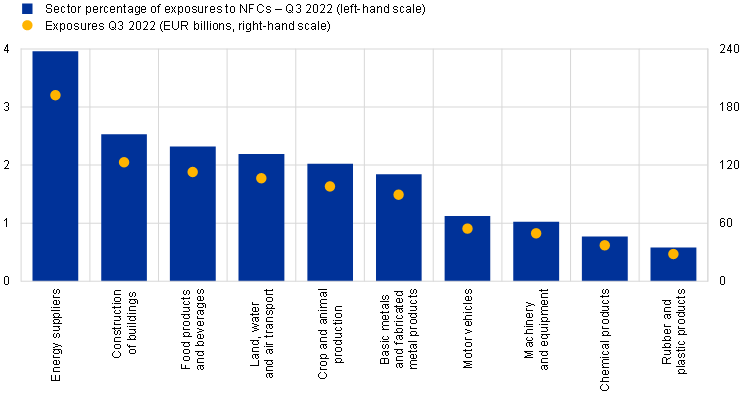
b) Stage 2 loan developments in vulnerable sectors
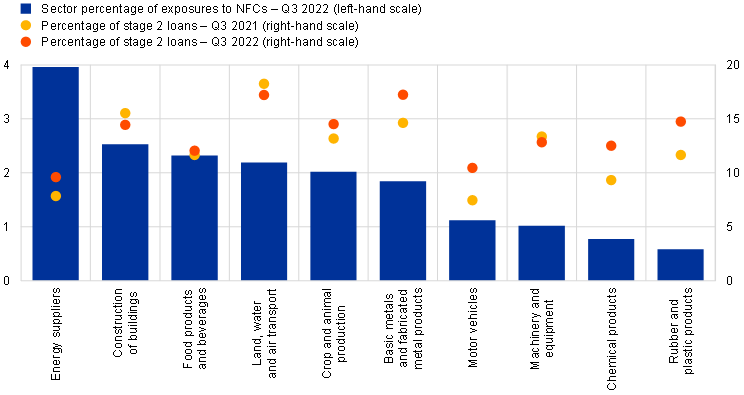
Source: ECB and ECB calculations.
Notes: Loans to vulnerable economic sectors as reported under AnaCredit. NFC stands for non-financial corporation as defined in paragraphs 2.45 to 2.50 of Annex A to Regulation (EU) No 549/2013.
Net interest income and trading income benefited from higher rates and volatility in a context of geopolitical tensions on energy and commodity markets
The acute geopolitical tensions observed in 2022 resulted in persistent inflationary pressures and volatility in energy and commodity prices. This had an impact on an already high inflation level, at a time when central banks were starting to normalise monetary policies, and contributed to the correction in equity markets. The subsequent fast-paced normalisation of interest rates provided a major boost to banks’ net interest income, which increased not only owing to expanding lending volumes, but also to increasing interest rate margins. Trading income, particularly for global systemically important banks (G-SIBs), generally profited from higher rates and higher volatility (Chart 4 and Chart 5).
Chart 5
Trading and investment income flows by selected business model
(quarterly flows in EUR billions)
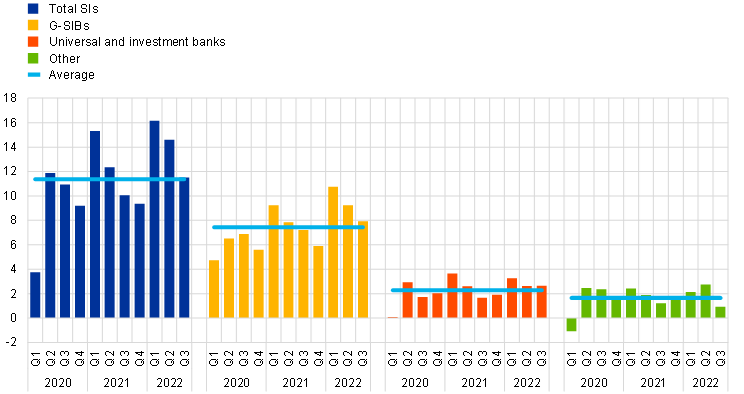
Source: ECB.
Note: The sample for “average” includes all SIs at the highest level of consolidation within the SSM (varying sample); the “G-SIBs”, “Universal and investment banks” and “Other” samples denote the sub-samples within the respective business models.
Banks’ liquidity and funding positions remained sound in 2022, although monetary policy normalisation could be challenging
Liquidity and funding conditions for SIs continued to benefit from the monetary policy measures adopted in 2020 and 2021. As at 30 September 2022, the liquidity coverage ratio (LCR) stood at 162%, below the level observed at the end of 2021 but well above pre-pandemic levels and minimum regulatory requirements (Chart 6).
Chart 6
Developments in liquidity coverage ratio, liquidity buffer and net liquidity outflow
(left-hand scale: EUR billions; right-hand scale: percentages)
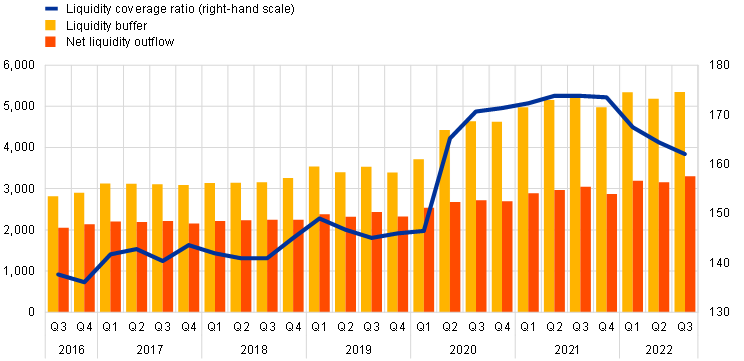
Source: ECB supervisory statistics.
Note: The sample includes all SIs at the highest level of consolidation within the SSM (varying sample).
On the same date, the net stable funding ratio stood at 127.1%, broadly in line with the values observed in 2021, comfortably above pre-pandemic levels and minimum requirements (Chart 7).
Chart 7
Developments in net stable funding ratio, available stable funding and required stable funding
(left-hand scale: EUR billions; right-hand scale: percentages)
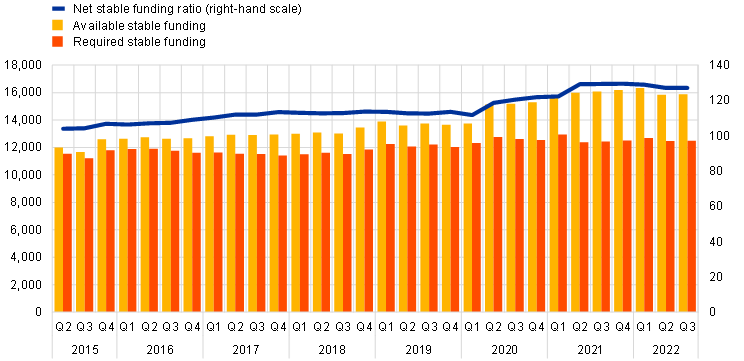
Source: ECB supervisory statistics.
Note: The sample includes all SIs at the highest level of consolidation within the SSM (varying sample).
As for LSIs, the respective supervisory metrics stood at 188.4% for the LCR and 130.2% for the net stable funding ratio, both slightly lower compared with the third quarter of 2021, but still significantly above regulatory thresholds.
In the last quarter of 2022, the ECB continued raising interest rates, changed the terms and conditions of the third series of targeted longer-term refinancing operations (TLTRO III) and offered banks additional voluntary early repayment dates starting from 23 November 2022. The normalisation of monetary policy will create a more challenging environment for bank funding and downward pressure on banks’ liquidity ratios.
As a result, 2022 was marked by the resilience of capital and liquidity ratios, along with improved asset quality and enhanced profitability. ECB Banking Supervision keeps a close eye on the distributional effects of these trends by continuing to monitor banks’ specific vulnerabilities. At the same time, it remains alert to potential uncertainties stemming from volatile markets or unexpected developments in the macroeconomic environment, such as a potential downturn, steeper interest rate increases or reinforced inflationary pressures.
Despite further business continuity challenges, the impact on operational risk has continued to be limited up until now
Over the course of 2022, the challenges linked to the pandemic and new hybrid working models being rolled out became less relevant. By contrast, the uncertainties stemming from the Russian war in Ukraine and the increasing geopolitical tensions meant that the environment for supervised banks continued to be challenging from an operational resilience point of view.
Banks with critical operations in countries directly affected by the Russian war in Ukraine implemented business continuity plans that proved to be robust during a fast-changing environment in the first phase of the war. These SIs were able to ensure protection, and where necessary the transfer of key staff, while at the same time continuing their operations. In some cases, critical operations were transferred to teams working in other locations, including in EU entities. The lessons learned during the COVID-19 pandemic played a key role in the efforts of institutions to quickly adapt.
As in previous years, in 2022 banks also showed the same trend towards digital transformation, which meant greater reliance on IT infrastructures and use of third parties, including cloud services for the delivery of critical services. While this trend certainly brings certain benefits for banks, it also comes with additional risks and challenges from an operational perspective, such as managing the increasing number and sophistication of cyberattacks and the potential concentration on a small number of critical third-party providers. For that reason, cyber risks and third-party dependencies remained a priority for ECB Banking Supervision (see Section 1.2.3.1 for more on emerging risks in IT and outsourcing) and continued work is required by banks to ensure they are resilient to potential operational disruptions from all hazards, including severe but plausible cybersecurity incidents, which could pose risks to the wider financial system[1].
The COVID-19 pandemic and the Russian war in Ukraine once again showed the importance of having sound governance arrangements in place, as well as internal control functions and data aggregation capabilities
As for supervised banks’ governance structures, the ECB emphasised the need for continued improvement in their governance frameworks. The COVID-19 pandemic and the Russian war in Ukraine showed once again the importance of having sound governance arrangements in place, as well as internal control functions and data aggregation capabilities.
More specifically, and with regard to the Russian war in Ukraine, ECB Banking Supervision identified a number of areas requiring particular attention: first, the capability of management bodies, as well as legal and compliance departments, to exercise strong oversight over the impact of sanction schemes; second, proper approval processes for client transactions, including proper risk data aggregation capabilities to identify critical exposures; and finally, some banks’ internal audit activities might need to be adapted to capture all relevant risks stemming from the changes in the current external environment.
The COVID-19 pandemic and the Russian war in Ukraine also amplified pre-existing weaknesses in a number of general governance and risk management arrangements. First, there continued to be shortcomings in data aggregation and reporting due to deficiencies in the effectiveness of data governance (e.g. insufficient independent validation of data quality) and data quality management procedures, fragmented IT landscapes, and the limited scope and ambitions of banks’ remediation projects. These setbacks can hinder banks’ decision-making processes. Second, several banks still needed to further improve their internal control functions, particularly to address insufficient staffing, the low stature of the function and deficiencies in processes (such as compliance monitoring programmes and the definition of banks’ risk appetite).
Moving the focus beyond crisis aspects, some banks continued to make progress following targeted measures by ECB Banking Supervision. This included specific areas such as collective suitability, the number of independent directors, committee structures, diversity policies and the level of involvement of non-executive directors. Nevertheless, some weaknesses remain in the majority of banks, namely: (i) the low level of involvement of the management body in its supervisory function and its ability to challenge strategic decisions in the areas most affected by the current crises; (ii) insufficient expertise in banking and risk management of non-executive directors in a few banks; (iii) insufficient promotion of diversity in some banks; (iv) low proportion of independent board members in some banks, which further hinders the ability of the management body in its supervisory function to constructively challenge executive directors. Increased supervisory scrutiny over those deficiencies is performed as part of the work on management body effectiveness and diversity (see Section 1.2.2.2).
1.1.2 General performance of banks under European banking supervision
The rebound in banks’ profitability in 2022 was driven by increased income and subdued cost of risk, but the outlook may be less positive as the macroeconomic environment deteriorates
The profitability of SIs under European banking supervision showed strong resilience to the deterioration in the business environment related to the Russian war in Ukraine, supply chain disruptions and surging energy prices. Their aggregate annualised return on equity rose to 7.6% in the third quarter of 2022 (Chart 8) – the highest level recorded in several years, but still below banks’ average cost of equity. This increase was mainly driven by strong earnings largely related to rising interest rates, but it was also supported by a low cost of risk, as the adverse macroeconomic developments have not materially affected asset quality for the time being, and banks were also still able to benefit from provisions booked during the pandemic that they could redirect towards the current crisis.
Chart 8
Aggregate return on equity broken down by income and expense source
Increase in profitability driven by strong income supported by low impairments
(percentage of equity)
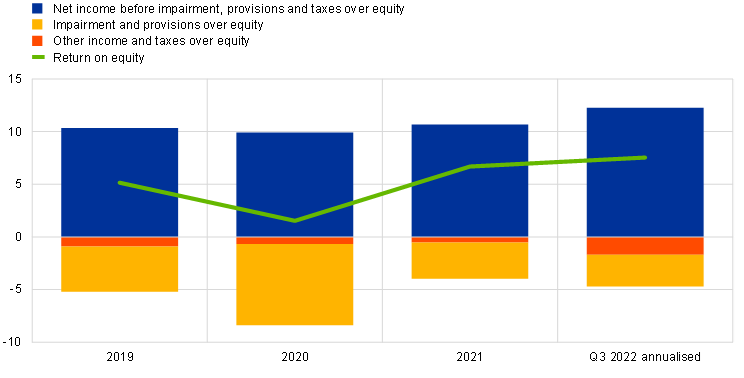
Source: ECB supervisory statistics.
Note: The sample includes all SIs at the highest level of consolidation within the SSM (varying sample).
The increase in operating income was driven mainly by rising net interest income (+9.3% year on year), which benefited from an increase in margins supported by rising interest rates and a steepening yield curve, as well as from growth in lending volumes. By contrast, the total cost of funding and, namely, the cost of deposits of non-financial corporations increased notably over 2022, although this trend was heterogenous across banks. In the first three quarters of 2022, net fee and commission income was still higher than that of previous years, albeit with modest declines being recorded owing to the adverse impact of the deteriorating business environment on asset management and investment banking fees. The strong growth in income resulted in increased cost efficiency despite rising expenses: for each euro of income, banks needed to spend 61 cents as at the third quarter of 2022, compared with 64 cents in the previous year (Chart 9).
Chart 9
Cost-to-income ratio and indexed components
(percentages)
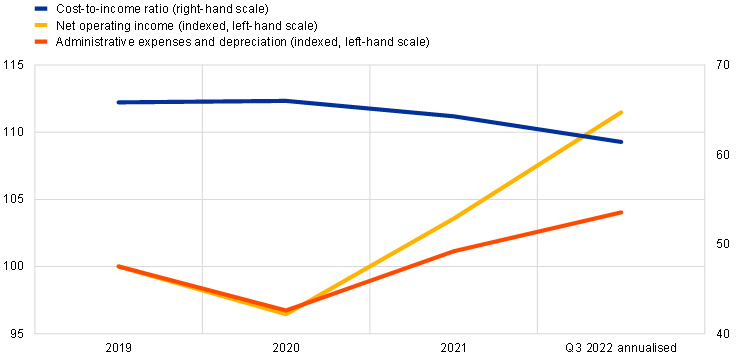
Source: ECB supervisory statistics.
Note: The sample includes all SIs at the highest level of consolidation within the SSM (varying sample).
On the cost side, administrative expenses and depreciations increased by 3%, primarily owing to increased staff expenses and IT-related costs as rising inflation percolated through the SIs’ cost structures. The increase in staff expenses was relatively modest, but as contractual wages are fixed in advance, inflation may affect this item further with some delay. Nevertheless, SIs maintained their broader strategic objectives of reducing expenses and investing in IT, even in the current environment as pandemic-related restrictions were gradually lifted.
Overall, banks’ profits were resilient to the slowing growth and benefited from rising interest rates. The pressure points on profitability included a potential increase in impairments and the need for valuation adjustments, higher operating expenses, a rise in the cost of funding, downward pressures on fee and commission income and insufficiently sustainable trading revenues. The first signs of increased pressure on profitability could be seen in SIs specialised in consumer credit.
Therefore, to consolidate and further improve the positive results achieved in 2022, banks should continue to actively steer their business models and focus their strategies on meeting sound risk-adjusted profitability targets. Supervisors continued monitoring the sustainability of banks’ business models in the light of short-term uncertainties and long-term structural challenges.
While LSIs’ profitability also improved against lower impairments in 2021, the first half of 2022 saw a reversal in some countries with negative other operating income
At first glance, the profitability of LSIs showed a different trend, with annualised return on equity decreasing to 1.3% after three quarters in 2022 (-4.3% year on year). The main driver behind this overall result was a substantial decline in net other operating income, however, this was largely attributable to developments in Germany. Here, banks experienced sizeable valuation losses as a result of rising interest rates and the impact of these on the securities portfolios under their respective accounting regime, which triggered book losses as a result of the strict lower-of-cost-or-market principle. In most countries, LSIs were actually able to improve their return compared with the previous year. The rise in interest rates had a positive impact on profitability in line with the general trend for SIs – both net interest income and net fee and commission income improved by 7.2% and 1.5% year on year respectively. Trading activities also recorded a material upsurge in net income (+89% year on year). Still, the cost-to-income ratio continued to increase and reached 85.6%, standing significantly higher by comparison with SIs, reflecting a material deterioration in net operating income. Administrative expenses and depreciations increased by 3.6% overall. At the same time, total assets increased slightly (3.2% year on year), driven by growth in corporate and retail loan business, further pushing down the return on assets to 0.12%, from 0.54% one year ago. As a result, the outlook for core income-generating capabilities temporarily improved, while higher expenses posed a risk to the LSI sector, especially in the light of continued regional discrepancies.
The deterioration in the macroeconomic environment, driven by geopolitical uncertainties and slowing growth prospects, has so far subdued banks’ efforts to further intensify M&A activity
Since the global financial crisis, the number of banks engaging in mergers and acquisitions (M&A) has been subdued. In line with developments globally, the value of M&A transactions, proxied by the total assets of M&A targets, fell by around two-thirds between the pre-crisis decade and the period since 2008, while the decline in the total number of transactions had been less steep.
More recently, over the course of 2020 and 2021, M&A activity appeared to gain some momentum, with banks more actively engaged in targeted consolidations at the level of business lines, such as leasing, factoring, wealth management, custody or securities services. Several of these business line acquisitions also included cross-border elements. For 2022, the deterioration in the macroeconomic environment, driven by geopolitical uncertainties and slowing growth prospects, has so far subdued banks’ efforts to further intensify M&A activity.
As in the past, fully fledged bank M&As are still predominantly domestic and involve smaller targets. However, some of the more targeted transactions featured a cross-border dimension and thus also contributed to financial integration within the EU. Another avenue to pursue cross-border integration would be for banks to review their cross-border organisational structures.
Chart 10
Total assets of target banks and number of M&As in the euro area
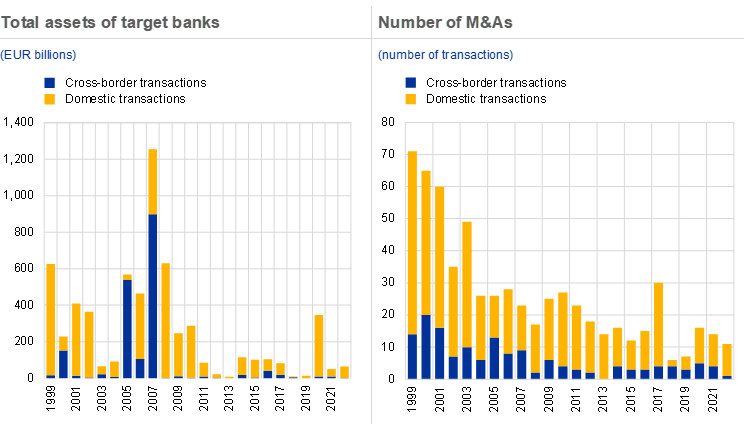
Source: ECB calculations based on Dealogic and Orbis BankFocus.
Notes: The sample includes M&A transactions involving SIs and LSIs in the euro area, excluding some private transactions and transactions between small banks not reported in Dealogic. Transactions associated with the resolution of banks or distressed mergers were removed from the sample. Transactions are reported on the basis of the year in which they were announced.
1.2 Supervisory priorities for 2022
1.2.1 Supervisory priorities for 2022: introduction
In 2022, while initially focused on vulnerabilities stemming from the pandemic, as well as other emerging risks, ECB Banking Supervision also broadened its scope of priorities to include risks posed by the rapidly changing macroeconomic environment
In 2022 ECB Banking Supervision focused its supervisory efforts on three different areas of priority to ensure that, first, banks emerge healthy from the pandemic (Priority 1); second, that they seize the opportunity to address structural weaknesses via effective digitalisation strategies and enhanced governance (Priority 2); and third, that they tackle emerging risks, including climate-related and environmental risks, exposures to counterparty credit risk, and IT outsourcing and cyber risks (Priority 3). Several supervisory activities designed to address these challenges were carried out in 2022, covering a wide range of banks and following a risk-based approach. ECB Banking Supervision also demonstrated flexibility by adjusting the scope, timing and intensity of its planned activities so as to tackle the emerging risks stemming from the Russian war in Ukraine, including high inflation and the subsequent monetary policy response.
1.2.1.1 Credit risk management frameworks and exposures to vulnerable sectors, including real estate
Effective credit risk management frameworks can help banks identify distressed borrowers and sectors at an early stage
On a positive note, the quality of banks’ assets continued to improve through a sustained reduction in the volumes of NPLs in the first half of 2022, with only minor increases in the SME and consumer portfolios up to end of the third quarter. These positive asset quality trends are highly welcome as the benefits of concrete bank action continue to be reaped following several targeted supervisory actions taken to combat credit risk over the past number of years. Positive credit quality developments, such as the continuing reduction in NPLs, contributed to marginal improvements in the average credit risk scores of banks for the 2022 Supervisory Review and Evaluation Process (SREP) cycle. While there are clear signs of efforts by banks to remedy identified deficiencies in the area of credit risk frameworks and controls, demonstrated by a decrease in the volume of related credit risk measures in the 2022 SREP, the pace of progress is still slow. As a result, the credit risk control scores remained low for the 2022 SREP.
Despite these positive trends, the changing credit risk environment, with its tighter financing conditions and an increasing risk of recession across Europe, is naturally holding back progress. This has had an impact on households, corporates and sovereigns to varying degrees, depending on factors such as their levels of indebtedness or sensitivities to the macro-financial environment. Therefore, the supervisory activities conducted to date and the supervisory expectations communicated since the outbreak of the pandemic with a view to tackling structural deficiencies in banks’ credit risk management frameworks remain relevant for addressing further challenges that may arise.
This is particularly relevant in the areas of loan origination and monitoring, forbearance flagging, the classification of distressed borrowers as NPLs and their provisioning frameworks, as well as in the area of vulnerable sectors. While most SIs developed concrete remedial action plans to address the gaps identified as part of the “Dear CEO” initiative[2] launched in December 2020, many of these gaps remain open. The expectation was that these deficiencies would be addressed by way of the credit risk work programme in 2023 and beyond. Furthermore, a horizontal analysis of credit risk patterns and trends carried out in 2022 found consistent evidence of this for the LSI sector.
Following a sharp price correction at the onset of the pandemic, conditions in commercial real estate markets continued to be of concern. This was particularly evident in the office and retail sub-sectors of the commercial real estate sector across Europe, which was challenged by rising interest rates and the surge in construction costs. Despite persistent signs of overvaluation in the euro area, residential house prices increased in the first half of 2022, further widening the gap with respect to rental prices. Coupled with the increase in the cost of living and the associated decline in real wages, this raised concerns of a sudden surge of NPLs, especially for those banks significantly exposed to residential mortgage loans with floating interest rates.
To shed light on banks’ preparedness to deal with a deteriorating commercial real estate market, and in line with the Recommendation of the European Systemic Risk Board on vulnerabilities in the commercial real estate sector in the European Economic Area, ECB Banking Supervision conducted a targeted review of the commercial real estate sector, focusing on the office and retail sub-sectors. Ad hoc data were collected to analyse the risk profile and materiality of these sub-sectors during an initial data gathering phase, which included 32 banks, with the sample size being narrowed down to 15 banks in the subsequent deeper qualitative phase. The key concerns identified through this exercise related to the effectiveness of banks’ credit risk management frameworks. In this respect, deficiencies were identified in most banks in terms of their assessments of borrowers’ repayment capacity at loan origination, particularly in the context of a more challenging environment characterised by increasing financing costs and stagnant rental income. Furthermore, the ability to identify emerging risks was also seen to be an area for improvement, chiefly because some banks’ frameworks did not sufficiently capture the forward-looking risk, and in some cases, also relied excessively on manual processes. As for the incorporation of climate risk into credit risk management, banks still lacked the necessary data to assess risk sufficiently, and there was heavy reliance on proxies to estimate missing “real” data. Detailed findings and requests for remedial action plans were subsequently issued to all banks included in this exercise, and the Joint Supervisory Teams (JSTs) were consistently engaged in this topic.[3]
A similar exercise was launched in the second quarter of 2022 on the residential real estate (RRE) sector. This focused on assessing potential risks embedded in existing exposures, addressing bank-specific gaps in the risk management of domestic RRE new lending business and, ultimately, on identifying credit risk management deficiencies and developing remedial action plans. The RRE sector is considered to be a material asset class on the balance sheets of significant banks. The sample for this exercise includes 29 banks, accounting for around 40% of SIs’ RRE exposures. The outcomes of the exercise are expected in the second quarter of 2023 and will be incorporated into the 2023 SREP exercise.
1.2.1.2 Exposures to leveraged finance
Over the past four years, the holdings of leveraged loans by SIs[4] under European banking supervision have increased, on an aggregated basis, by 80%, alongside an increase in the share of highly leveraged transactions[5] originated by SIs. This trend held until mid-2022, at which point SIs continued underwriting new syndicated loans. The exposure amounts of the SIs in the second quarter of 2022 were close to the record values posted in the fourth quarter of 2021. Since then, the primary market has shut down to a considerable extent. Substantial write-downs on corporate loan books held for sale were recorded by the largest players across Europe and globally.
Chart 11
Developments in leveraged transactions
Breakdown of underwritten volumes by leverage level
(share of total SI notional)
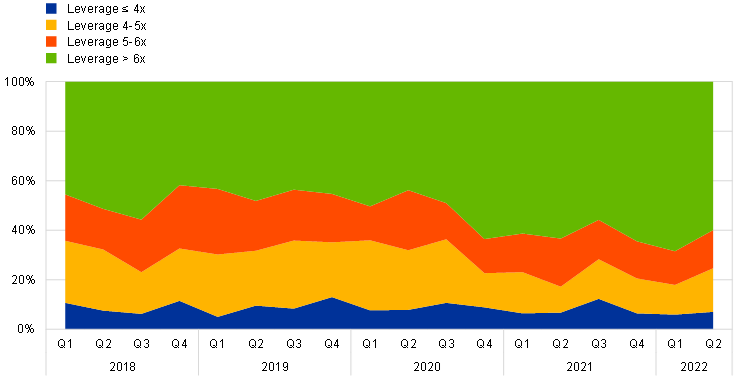
Exposure of euro area banks and share relative to CET1 capital, aggregate levels for supervised banks
(left-hand scale: EUR billions; right-hand scale: percentage of CET1 capital)
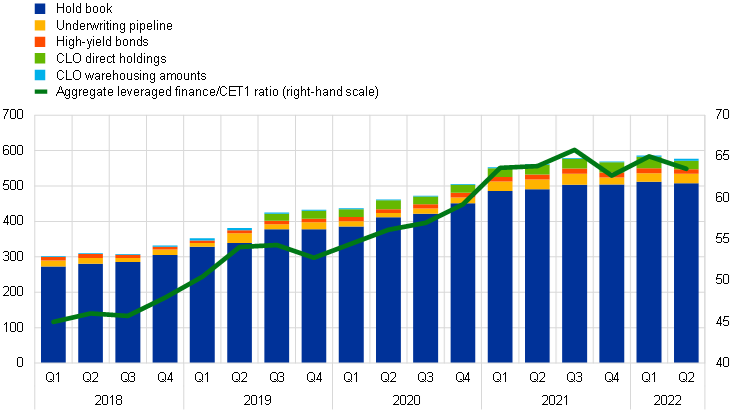
Sources: ECB Banking Supervision and ECB Leveraged Finance Dashboard.
Notes: Data are limited to a sample of SSM banks with the largest leveraged finance portfolios. CLO stands for collateralised loan obligations.
Since there were also concerns about increasing risk-taking in the leveraged finance segment during the pandemic, in March 2022 the ECB decided to send a “Dear CEO” letter on leveraged transactions to SIs. The aim of the letter was to further clarify the ECB’s expectations concerning the risk appetite framework for leveraged transactions and, in effect, to operationalise the ECB’s guidance on leveraged transactions that was published in 2017.
The responses to the letter confirmed that there were significant deficiencies in both the robustness of banks’ overall risk appetite frameworks and their management of market risk. The JSTs are currently working closely with individual banks to discuss how they can effectively close the gaps identified and meet the expectations.
The ECB has already started to apply capital charges to a few banks where the risks associated with leveraged lending activities were perceived to be excessively high – either because of the level of very high-risk exposures, weaknesses in risk management practices, or both. The ECB will continue to apply any necessary capital charges through the SREP exercise in the course of 2023. These charges reflect insufficient progress made by banks in meeting the expectations set out in the aforementioned guidance and will only apply as long as the identified deficiencies persist.
1.2.1.3 Counterparty credit risk
With market, economic and geopolitical uncertainties on the rise, ECB Banking Supervision sharpened its focus on banks’ counterparty risk management capabilities
The “low for long” interest rate environment which prevailed until 2022 fostered search-for-yield strategies by many types of investors. As a result, some banks increased the volume of the capital market services they provided to more risky and less transparent counterparties, often non-bank financial institutions, including through significant leverage.
Coupled with an increase in volatility across several markets (e.g. energy and interest rates) and a normalisation of monetary and financial conditions over the course of 2022, the material impact that counterparty bankruptcies (e.g. hedge funds and family offices) previously had on some banks in 2021 drew attention to risks stemming from weak governance or inadequate risk management practices by third parties.
With this in mind, and in line with its supervisory priorities, ECB Banking Supervision took a range of measures to fend off potential risks in this area. First, the ECB published an article in its Supervision Newsletter in August 2022 outlining its supervisory expectations for prime brokerage services. Second, from April to October 2022 the ECB conducted a targeted horizontal review focused on governance and risk management of counterparty credit risk across a wider sample of banks active in derivatives and securities financing transactions, including both non-bank financial institutions and non-financial counterparties. Third, on-site inspections were conducted for selected institutions.
Overall, although banks have made progress in terms of identifying, measuring and controlling counterparty credit risk, there are still several material shortcomings in key areas such as due diligence, definition of risk appetite, stress testing, risk mitigation and default management, both in the light of supervisory expectations and good practices observed in the industry. Looking ahead, the JSTs will continue to engage with banks in the course of 2023 to remedy deficiencies in those areas which have been identified as more material.
1.2.1.4 Sensitivity to interest rate and credit spread risks
Most banks profited from increasing interest rates, but improvements in risk management are necessary
In 2022 the ECB carried out a review of interest rate and credit spread risk management practices among a sample of SIs particularly exposed to those risks. For most banks, an upward 200-basis point interest rate shock (Chart 12) would have a positive impact on profitability, even under a baseline scenario of an economic slowdown such as the one included in the ECB staff macroeconomic projections. As for potential increases in provisions reflecting the difficulties faced by borrowers, the ECB’s most recent analyses show that negative impacts on capital adequacy would remain, on average, fairly muted even with shocks of up to 300 basis points.
Irrespective of the applicable prudential and accounting regimes, banks should be mindful of the typically negative impact of rising rates on their economic value of equity. They should adopt sound and prudent asset and liability management modelling practices in order to capture shifts in consumer preferences and behaviour when interest rate regimes change. They should also carefully monitor risks arising from hedging derivatives.
Credit spread risk should be appropriately measured and managed, including for sovereign debt securities and other instruments accounted for at amortised cost. In particular, the calibration of internal stress tests should reflect the severity of historical stress episodes.
Interest rate and credit spread risks can have a material impact on LSIs as well
The considerations above also apply to LSIs, for which exposure to interest rate and credit spread risk can be very relevant. The concrete impact of the sudden shift in interest rates depended not only on the open risk position, but also on the applicable national accounting framework. Some banks were affected by significant valuation adjustments to their securities portfolios that needed to be reflected in the profit and loss statements, thus reducing regulatory capital. Over the medium term, the impact on profitability and capital will depend on the decision to sell the securities or hold them until maturity and, of course, on future developments in interest rates.
Chart 12
Impact of a 200-basis point increase in interest rates on significant institutions
Theoretical impact of profitability and economic value of equity on CET1 ratio
(basis points)
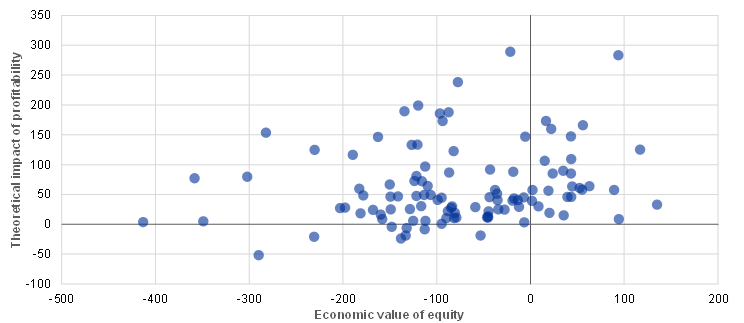
Sources: ECB calculations and short-term exercise data as at 30 June 2022.
Box 2
Follow-up on Brexit: outcome of the desk-mapping review
Integrating Brexit banks into European banking supervision
The key overarching objective of this project was to ensure that all significant institutions have prudent and sound risk management frameworks in place, as well as a local presence which enables effective supervision commensurate with the risks that they take.
On 1 January 2021, the United Kingdom left the single European market. From the EU’s perspective, the United Kingdom is now a third country. UK-based banks wishing to provide services within the EU can no longer do so via passporting, i.e. the right of a bank to serve customers across the EU from one of its Member States, either through the free provision of services or by establishing local branches under preferential terms.
The desk-mapping review, in other words, the review of booking and risk management practices across trading desks active in market-making activities, treasury and derivative valuation adjustments, is aimed at ensuring that third-country subsidiaries have adequate governance and risk management arrangements in place and do not operate as empty shells. The desk-mapping review was initiated because ECB Banking Supervision found that (i) banks had not made sufficient progress in ensuring adequate local trading presence and risk management capabilities in their newly established entities in the euro area; and (ii) banks needed clearer instructions in order to appropriately implement the target operating models previously agreed with their Joint Supervisory Teams. In this respect, ECB Banking Supervision closely collaborated with other supervisory authorities, particularly those in the United Kingdom, to make sure that the rationale behind its supervisory policies was properly understood by all parties involved.
As the supervisor for the euro area, it is the ECB’s duty to protect its depositors and other creditors of local legal entities, prevent the disruption of banking services and safeguard broader financial stability in its area of jurisdiction. In this context, empty shell structures – legal entities located in the euro area that book exposures remotely with their parent entity or book them locally, but rely fully on risk management hubs and financial infrastructures located in third countries, often by means of back-to-back mirror transactions and hedges transferring the risk to their parent entity – are a very real concern.
First, these structures are exposed to heightened operational and counterparty risk vis-à-vis their parent affiliate. In the event of financial stress or default at the level of the parent entity, the local entity can be left with large unhedged positions and little to no access to the staff and infrastructure needed to wind them down smoothly. This, in turn, undermines both the local entity’s recovery capacity during severe stress and, where applicable, its resolvability. This is particularly relevant under a third-country framework where, during episodes of financial stress, the diverging interests of the numerous entities and stakeholders involved may lead to retrenchment and ring-fencing. Second, even during normal times, having risk management resources and infrastructure located offshore can hinder a bank’s ability to identify, measure and monitor risk and can make governance and decision-making less transparent. Third, reallocating risk and revenue to third-country affiliates can worsen the incentive structure for local bank management.
The first phase of the desk-mapping review, which was launched across seven institutions and affiliated investment firms, found that incoming banks did not yet retain full control over their balance sheets, as required under the ECB’s 2018 supervisory expectations. Some 70% of the trading desks assessed still implemented a back-to-back booking model and around 20% were organised as split desks, whereby a duplicate version of the primary trading desk located offshore was established within the euro area legal entity to manage the part of the risk originated there.
The supervisory scrutiny applied by the ECB in response to these findings was purely risk-based and took a proportionate approach based on materiality. 56 trading desks warranting supervisory action were identified based on a common set of risk indicators. Following this materiality assessment and its engagement with supervised entities in the course of 2022, the ECB will issue/issued individual binding decisions which may require incoming banks to (i) appoint a head of desk within the euro area legal entity with clearly defined reporting lines and a compensation structure linked to the performance of that entity; (ii) ensure the desk has the adequate infrastructure and number and seniority of traders to manage risk locally; (iii) establish a solid governance and internal control framework of remote booking practices with parent affiliates; and (iv) ensure limited reliance on intragroup hedging.
The review of trading desks and their associated risks does not mark the end of the supervisory scrutiny of incoming banks’ post-Brexit operating models. Investigations into credit risk-shifting techniques, the reliance on parent entities for liquidity and funding, and internal model approvals are still ongoing.
1.2.2 Business model sustainability and governance
1.2.2.1 Banks’ digital transformation strategies
One of the supervisory priorities for 2022-24 was to address the challenges posed to banks by digital transformation.
Banks’ management bodies are chiefly responsible for setting strategic objectives for digital transformation and using innovative technologies. The focus of ECB Banking Supervision was to assess banks’ capabilities to develop and implement digital strategies that are adequate to strengthen their business model sustainability and prudently address related risks. Enhancing supervisory understanding of market developments and keeping pace with the impact of a fast-evolving technological landscape also remained a priority.
A survey on digitalisation collected information which was previously not available in a consistent manner across SIs; the results will benefit various supervisory activities
This is why ECB Banking Supervision took major steps to address these topics in 2022. Following a high-level dialogue with some of the leading market counterparts (as part of a market intelligence initiative) to understand market trends, all SIs were requested to respond to a survey on digital transformation and the use of fintech. This survey collected information which was previously not available in a consistent manner across SIs, and some of the national competent authorities (NCAs) also used the survey for some of their LSIs.
A system-wide overview of the main takeaways from the survey is featured in the February 2023 Supervision Newsletter, together with a link to the aggregated findings. In general, the survey findings confirmed that banks are increasingly digitalising and using innovative technologies, thereby transforming the way financial services and products are being delivered. Banks consider these to be essential elements for maintaining market shares and boosting their profitability. To achieve their digital transformation strategy objectives, banks tend to rely on outsourcing and external partnerships in an environment marked by competition to attract, retain and develop IT and digital expertise. However, as banks open up their IT infrastructures, they face heightened risks in terms of third-party dependency and cybersecurity. These risks require further monitoring and must be taken into account in banks’ governance and risk appetite frameworks.
Having said that, the responses are heterogenous, as there seems to be no common understanding of what digital transformation really means – it remains a very general concept relating to business models, processes and cultural change that is enabled by technologies. Therefore, further investigations and inspections are to be conducted in this area over the coming years.
The overall outcome of the survey will be instrumental for (i) developing guidance for supervisors to assess banks’ risks and best practices; (ii) identifying risks in specific supervised entities or technology use cases that require further targeted scrutiny; and (iii) potentially establishing further supervisory expectations. It will also be relevant for shaping the SREP methodology for the business models and governance underlying the use of new technologies.
ECB Banking Supervision also continued its efforts to actively shape digitalisation for the future European and international regulatory framework by further engaging with European Supervisory Authorities and international standard-setting bodies on the regulation of various aspects related to digitalisation and innovation in the financial sector. Moreover, ECB Banking Supervision continued to participate in discussions on the regulatory scope and legislative proposals made in the context of the digital finance strategy for the EU, such as the Markets in Crypto-assets Regulation[6], the Digital Operational Resilience Act[7] and the Artificial Intelligence Act[8].
1.2.2.2 Deficiencies in management bodies’ steering capabilities
Sound governance arrangements, robust internal controls and reliable data are essential for fostering adequate decision-making and mitigating excessive risk-taking both during normal times and in times of crisis. Despite the progress achieved by banks over the past few years in this area, supervisors continue to see a high number of structural deficiencies in internal control functions, management bodies’ functioning, and risk data aggregation and reporting capabilities.
This is why ECB Banking Supervision has been involved in several activities dedicated to achieving progress in this area, in particular with a view to strengthening internal governance and strategic steering capabilities. Over the period 2022-24, these activities will include targeted reviews of banks with deficiencies in the composition and functioning of their management bodies, on-site inspections, targeted risk-based fit and proper (re)assessments, the development of an approach to reflect diversity in fit and proper assessments, and the update of the 2016 supervisory statement[9], as well as data collections.
In 2022 ECB Banking Supervision finalised a data collection on banks’ management body composition and functioning. The exercise revealed that the level of formal independence within banks’ management boards was increasing but could be further improved in a number of cases. Furthermore, this exercise revealed that diversity in terms of both gender and expertise (especially in areas such as IT), which has long been recognised as crucial for effective governance, could still be improved. The need to have better succession planning policies for management boards was another area for further development. ECB Banking Supervision followed up on these findings in the context of the 2022 SREP by requesting banks which still had no diversity policy or diversity targets to put such frameworks in place. In this regard, the supervisory expectations communicated to banks made it clear that targeted policies should incorporate ratios for the underrepresented gender at banks’ management body level and include several dimensions such as age, gender, geographical origin, as well as educational and professional background, respectively. The JSTs are following up on banks’ implementation of such frameworks as part of their ongoing supervisory activities.
Governance arrangements are important for all banks regardless of their size. For this reason, ECB Banking Supervision also conducted a thematic review of the governance arrangements in place for LSIs[10] in 2021-22, using data from a sample of more than 200 LSIs across 21 participating countries. The results revealed several weaknesses in LSIs and underlined the importance of continuous improvement, facilitated by an ongoing dialogue between supervisors at all levels. ECB Banking Supervision and national supervisors will continue to promote greater alignment of European supervisory expectations and standards for internal governance, addressing any identified weaknesses along the way.
1.2.3 Emerging risks
1.2.3.1 IT and cyber risk
IT and cyber risk continued to be a key risk driver for the banking sector in 2022
Despite the Russian war in Ukraine, the number of cyber incidents reported to the ECB remained relatively stable in the first three quarters of 2022 by comparison with the same period of 2021.
ECB Banking Supervision conducted a number of off-site and on-site supervisory activities around IT and cyber risk in 2022 with the following takeaways: first, banks still showed room for improvement in terms of implementing basic cybersecurity measures, with around half of the severe findings being identified during IT risk on-site inspections conducted in 2022 and concentrated in the area of IT security and cybersecurity risk. Second, after some years of a steady increase, the reliance on end-of-life systems stabilised, albeit at a very high level. Third, data quality management remained the least refined risk control area and some of the key controls were not yet fully implemented in several banks. Fourth, the number of critical projects with an impact on the IT landscape increased very considerably, pointing to the clear relevance of having appropriate management procedures in place for IT developments and IT projects.
Furthermore, for the first time, ECB Banking Supervision was able to collect all of the outsourcing registers from SIs in 2022. A preliminary analysis of this information confirmed the high relevance of this topic: banks reported around 60,000 active outsourcing contracts, half of which covered their critical functions. While around 40% of all such contracts are related to ICT services, banks use outsourcing arrangements for all kinds of critical functions such as internal controls, customer and administrative services, payment services or cash management, among others.
The information collected on third-party dependencies also helped to identify certain emerging risks and challenges that needed to be properly managed, including the existence of several critical service providers difficult to substitute, the significant operational dependency of banks on companies from and services provided by non-EU countries, as well as a significant number of contracts that were still not fully aligned with either the European Banking Authority (EBA) Guidelines or the ECB’s supervisory expectations in this respect.
In 2022 ECB Banking Supervision also contributed to the activities of international working groups on IT and cyber risk, including those led by the EBA, the Basel Committee on Banking Supervision and the Financial Stability Board, and to the work around new regulatory proposals, such as the Digital Operational Resilience Act[11].
Overall, these developments underline the need for banks to continue improving their operational resilience framework to ensure appropriate business continuity, including that of their critical services, in an increasingly complex environment, as well as to adjust to the new and forthcoming regulatory requirements.
1.2.3.2 Climate-related and environmental risks
Following the publication of the ECB Guide on climate-related and environmental risks in November 2020, the ECB launched a range of supervisory exercises to assess banks’ capabilities to manage climate-related and environmental (C&E) risks and align their practices with supervisory expectations. Following the review of banks’ self-assessments and implementation plans in 2021, the ECB followed up with a thematic review in 2022. In the 2022 thematic review, the ECB evaluated the soundness and comprehensiveness of institutions’ key policies and procedures, as well as their ability to effectively steer their C&E risk strategies and risk profiles.
The review was conducted in tandem with the first supervisory stress test on climate-related risk (see Box 3) and complemented by a targeted review on commercial real estate and dedicated on-site inspections. The thematic review was conducted by the ECB and 21 NCAs and covered 107 SIs and 79 LSIs.
For over half of the banks significant concerns were expressed about their ability to effectively implement their strategies and process
The thematic review demonstrated[12] first that most institutions have now devised an institutional architecture to address C&E risks, having clearly built up capacity over the last year (Chart 13). Moreover, there was growing acknowledgement of the materiality of these risks and a broad set of good practices were being used in a variety of institutions. The ECB published a collection of good practices in a dedicated compendium[13] in order to respond to a request from the banking sector for further insight into good practices and to demonstrate that swift progress is possible. Notwithstanding this, virtually all institutions needed to make far-reaching and enduring efforts to align their practices with supervisory expectations. Generally, the approaches taken still lacked methodological sophistication, the use of granular information on C&E risk and/or active management of the portfolio and risk profile accordingly. Notably, blind spots in identifying C&E risks were revealed in 96% of institutions and for over half of the institutions significant concerns were expressed about their ability to effectively implement their strategies and processes.
Furthermore, in March 2022 the ECB published an updated assessment of the progress banks had made in disclosing C&E risks, as set out in the ECB’s November 2020 Guide. Although improvements had been made since the ECB’s first assessment in late 2020, no bank fully met the supervisory expectations. Compared with 2020, more banks were now able to disclose meaningful information on C&E risks. However, the overall level of transparency was still insufficient. Roughly 75% of the banks did not disclose whether C&E risks had a material impact on their risk profile, even though around half of the banks that failed to do so indicated to the ECB that they viewed themselves as exposed to such risks. And almost 60% of the banks in the sample did not describe how transition risk or physical risk could affect their strategy. The ECB sent individual feedback letters to banks explaining their main shortcomings and expecting them to take decisive action. This was also done to help banks prepare for new regulatory requirements such as the binding standards on Pillar 3 disclosures of environmental, social and governance risks. The ECB began reviewing banks’ C&E disclosures again at the end of 2022, with the results planned for publication in the course of 2023.
Following up on the various supervisory exercises, the ECB sent individual feedback letters to all SIs, setting institution-specific deadlines to gradually meet all supervisory expectations by the end of 2024.[14] The deadlines will be closely monitored and, if necessary, enforcement action will be taken. The ECB had already included bank-specific C&E findings in the SREP, whereby it imposed binding qualitative requirements on more than 30 banks, leading, for a small number of banks, to an impact on their SREP scores and, hence, an indirect impact on Pillar 2 capital requirements.
Chart 13
Results of the 2021 and 2022 supervisory assessments
Level of maturity of practices across areas of supervisory expectations (bank-by-bank)
(percentages of areas of supervisory expectations)
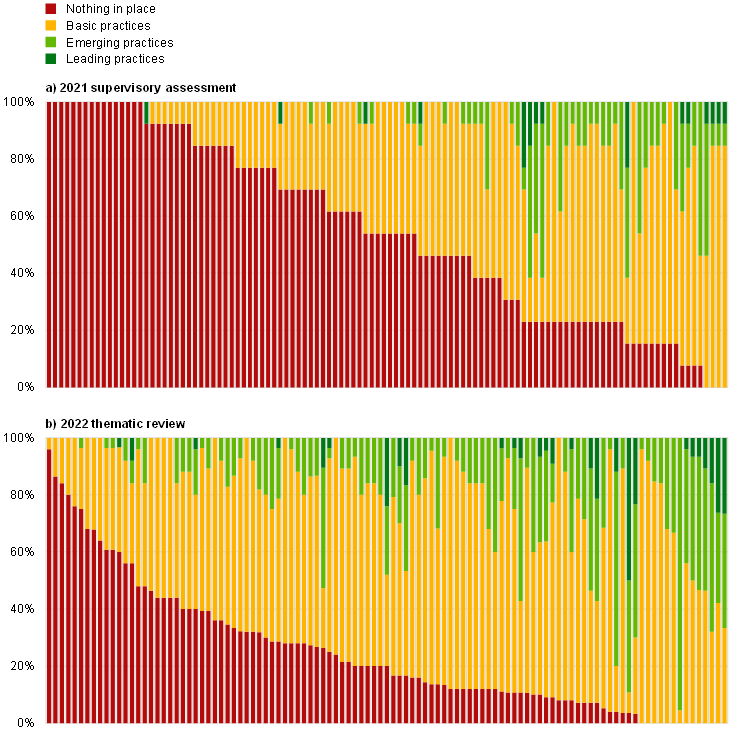
Source: “Walking the talk – banks gearing up to manage risks from climate change and environmental degradation”, ECB, November 2022.
Notes: The 2021 supervisory assessment scores are taken as a proxy to indicate the level of maturity of institutions’ practices in 2021. Owing to the updated assessment methodology used in the 2022 thematic review, direct comparison with the results from 2021 is indicative only.
Box 3
ECB climate risk stress test
In 2022 the ECB conducted a climate risk stress test (CST) as part of its annual supervisory stress test. Given the novelty of the exercise and the need for specific data and models to analyse climate-related risks, the 2022 CST should be seen as a learning exercise for both banks and supervisors and as a tool to enhance climate stress-testing capabilities in the industry. Hence, no direct capital implications were derived, although qualitative findings from the exercise were used as input for the Supervisory Review and Evaluation Process (SREP).
Structure of the exercise and scenarios
The CST consisted of three modules. Module 1 was a qualitative questionnaire aimed at collecting information on banks’ internal CST frameworks, covering both technical aspects and governance and process-related questions. Module 2 assessed the sustainability of banks’ income and their exposures to carbon-intensive companies. Banks were asked to report their income from the 22 most polluting industrial sectors and the emission intensities of their most relevant counterparties, as well as the respective exposures. In Module 3, banks were requested to submit bottom-up loss projections under six different scenarios, which, with some extensions, were based on those published by the Network of Central Banks and Supervisors for Greening the Financial System. These scenarios were very different from adverse scenarios employed in traditional solvency stress tests, since they included only climate-related risks, with different time horizons and features. They comprised two one-year physical risk scenarios (flood scenario and drought and heat scenario, respectively), one short-term (three years) disorderly transition risk scenario and three long-term (30 years) transition risk scenarios. 104 significant institutions participated in the 2022 CST, but only 41 were asked to submit bottom-up loss projections.
Results[15]
Banks were seen to have made considerable progress and started to integrate climate risk into their stress-testing frameworks, but many of them were still at a very early stage in terms of developing their data and modelling capabilities. Module 1 revealed that at the cut-off date (31 December 2021), 59% of participating institutions did not have a climate risk stress-testing framework in place. Moreover, most banks had only envisaged a medium to long-term time frame for incorporating climate risks into their internal stress-testing frameworks.
Module 2 showed that the interest income generated from the most emission-intensive sectors was not negligible, amounting to around 65% of total non-financial corporate interest income. This was not necessarily a problem from a transition risk perspective, but it highlighted the importance for banks to engage with their customers and to gain insight into their transition plans.
Banks projecting their losses under Module 3 reported €70 billion of aggregate losses under the three short-term exercises, of which €53 billion occurred under the disorderly transition scenario and €17 billion under the physical risk scenario. The ECB acknowledged that these estimates significantly understated the actual risk, because of the exclusion of economic downturns from the scenarios, data and modelling challenges faced by banks in capturing climate-related factors, the absence of supervisory overlays and limited coverage of the exposure within the scope, which only accounted for around one-third of banks’ total exposures.
The exercise identified significant challenges in terms of data availability and disclosure requirements for greenhouse gas emissions and energy performance certificates. These challenges had led to the extensive use of proxies of varying quality and would require further guidance and engagement with counterparties.
Integration of the climate risk stress test into supervisory activities and the next steps
The results of the CST, coupled with those from the 2022 thematic review, served as qualitative input for the annual SREP, which was to include climate-related risk elements in its assessment of banks’ business models, internal governance and risk management. On the basis of the insight gained in the 2022 CST, the ECB also published guidance on good practices[16] on how to improve banks’ climate risk stress-testing capabilities. The ECB will continue monitoring banks’ progress, in the expectation that supervised institutions will further develop their climate risk stress-testing frameworks and reduce data gaps by the end of 2024.
1.3 Direct supervision of significant institutions
1.3.1 Off-site supervision
ECB Banking Supervision strives to supervise SIs in a proportionate and risk-based manner that is both demanding and consistent. To that end, it defines a set of core ongoing supervisory activities for each year. These activities draw on the existing regulatory requirements, the SSM Supervisory Manual and the supervisory priorities, and are included in the Supervisory Examination Programme (SEP) for each SI. In addition to those activities addressing system-wide risks, other supervisory activities that are tailored to banks’ specificities can be included in the SEP, leaving room for the JSTs to analyse and tackle idiosyncratic risks. The off-site SEP activities include (i) risk-related activities (e.g. the SREP), (ii) other activities related to organisational, administrative or legal requirements (e.g. the annual assessment of significance), and (iii) additional activities planned by JSTs to further tailor the SEP to the specific characteristics of the supervised group or entity (e.g. analyses of the bank’s business model or governance structure).
1.3.1.1 Being proportionate
As in previous years, planned supervisory activities in 2022 followed the principle of proportionality, tailoring the intensity of supervision to the systemic importance and risk profile of the supervised bank
The SEP follows the principle of proportionality, i.e. the intensity of the supervision depends on the size, systemic importance, risk and complexity of each institution.
As in previous years, the average number of planned supervisory activities per SI included in the SEP reflects this principle of proportionality, i.e. JSTs supervising bigger and riskier SIs, on average, plan a higher number of SEP activities (Chart 14).
Chart 14
Average number of planned tasks per significant institution in 2022

Source: ECB.
Note: Data extracted as at 22 December 2022.
The number of activities carried out in 2022 was marginally lower than what was originally planned at the beginning of the year (Chart 15). This is mostly due to a small number of administrative tasks being cancelled throughout the year, which is in line with previous years.
Chart 15
Average number of tasks per significant institution in 2022
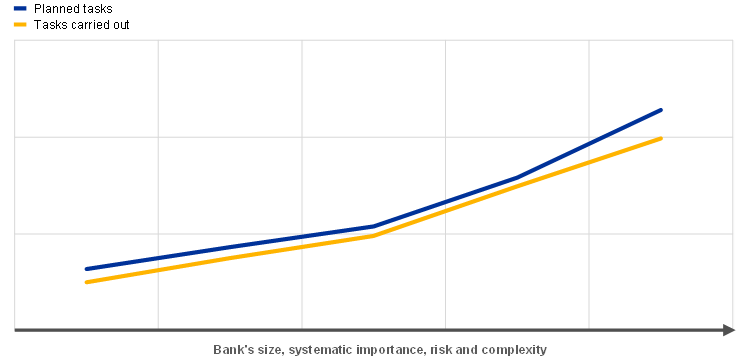
Source: ECB.
Note: Data extracted as at 22 December 2022.
1.3.1.2 Taking a risk-based approach
The SEP follows a risk-based approach, focusing on the most relevant systemic and institution-specific risks for each SI. For example, for high-NPL banks, JSTs conducted more activities related to credit risk than for the average bank. Similarly, the percentage of activities carried out by JSTs relating to market risk is higher for banks with large exposures to market and trading activities than it is for the average bank (Chart 16).
Chart 16
SEP activities in 2021 and 2022: credit and market risk activities as a share of all activities
Credit risk
(percentages)
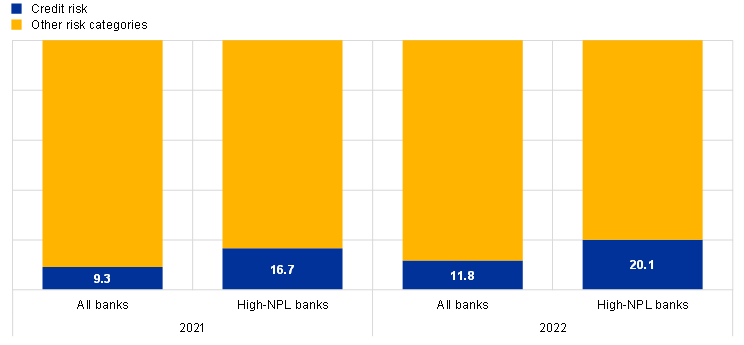
Market risk
(percentages)
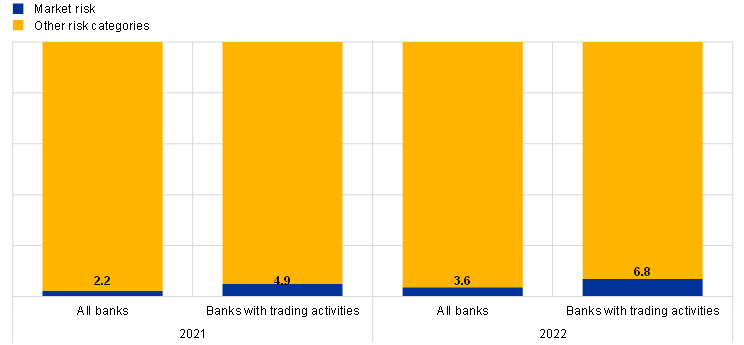
Source: ECB.
Note: Data extracted as at 22 December 2022.
1.3.1.3 Highlights of off-site supervision in 2022
The SREP is the key supervisory tool for summarising all the information collected for an individual institution in a given year to produce the annual risk assessment for that institution (see also Section 1.3.1.5 on the 2022 SREP horizontal analysis).
Notable examples of off-site activities that JSTs carried out in 2022 in the context of the 2022 SREP and the overall SREP assessment include the 2022 climate risk stress test (see Box 3) and a targeted review of commercial real estate (CRE).
The targeted review of CRE demanded considerable resources. Announced in December 2021, this review focused on credit risk management of emerging risks in banks’ domestic CRE portfolios, and used peer benchmarking as a basis for assessing critical elements of credit risk management.
The ECB also carried out a climate risk stress test among supervised SIs as its annual stress test. The main findings of this climate risk stress test were published in July 2022.
1.3.1.4 Supervisory findings
Supervisory findings are one of the main outcomes of the regular supervisory activities and reflect shortcomings that need to be remedied by banks. The JSTs are responsible for monitoring how banks follow up on these findings. In 2022 the overall number of registered findings decreased in comparison with 2021, reverting to a level similar to that seen before the pandemic. This was mainly caused by a reduction in the number of internal model investigation-related findings compared with the previous year. The majority of findings originated from internal model investigations, on-site inspections and activities related to authorisations. The largest number of findings were reported in the area of credit risk (Chart 17).
Chart 17
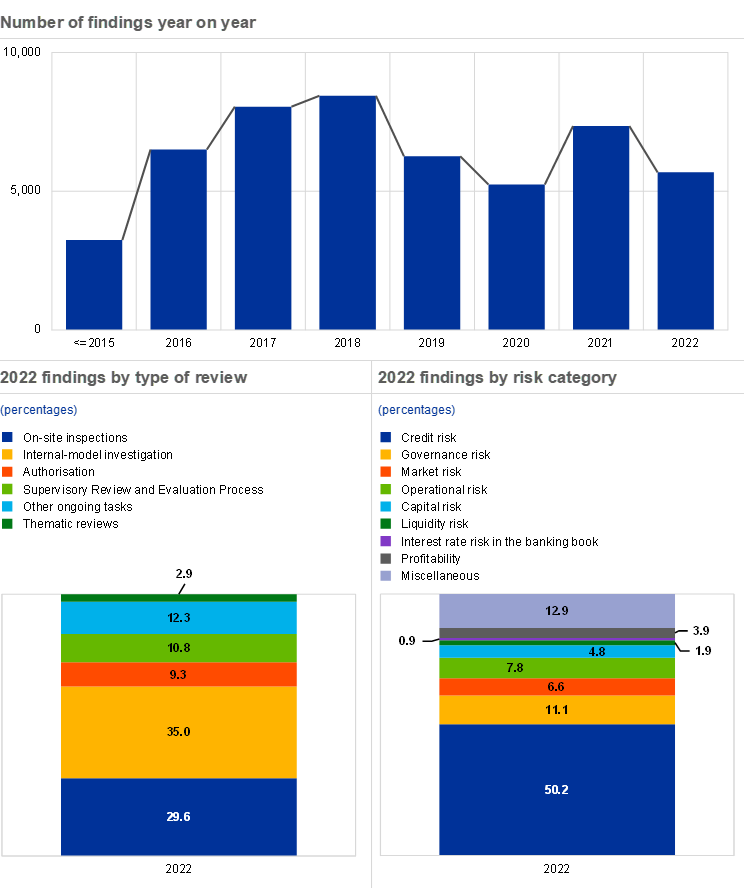
Source: ECB.
Notes: The sample includes findings from all JSTs working in ECB Banking Supervision (varying sample). Data extracted as at 16 December 2022.
1.3.1.5 SREP horizontal analysis
In 2021 the SREP reverted to a full SREP assessment, which resumed in the 2022 SREP cycle. As in previous SREP cycles, SREP scores remained the same overall and although there was a recovery after the COVID-19 pandemic, supervisors remained cautious amid the exogenous shocks resulting from the lingering effects of the pandemic and the Russian war in Ukraine.
Consistent with previous SREP cycles and the 2022 supervisory priorities, most qualitative measures addressed deficiencies in credit risk management and internal governance, but for the first time, a significant number of measures were also taken to address climate risk.
Credit risk was a key area of focus for the SREP assessment. Notwithstanding improvements in risk levels and positive developments in credit quality (e.g. the reduction in NPL exposures), average scores only marginally improved. This was due to continuing uncertainties about macroeconomic and financial market developments and remaining structural weaknesses in credit risk controls. As a result of Russia’s ongoing war in Ukraine and the related impact on energy and commodity prices, as well as the fast-paced exit from a low interest rate environment, looming signs of latent risk became increasingly visible. Forbearance and stage 2 ratios have now risen above pre-pandemic levels, meaning there are pockets of risk in the areas of leveraged finance and exposures related to vulnerabilities in specific sectors, as well as counterparty risk resulting from the adverse implications of the war in Ukraine.
One-third of the measures taken to address credit risk related to strategic and operational plans or coverage of non-performing exposures (NPEs). In addition, in line with the supervisory priorities for credit risk, 10% of all measures were taken for shortcomings relevant to the focus areas of the “Dear CEO” letter of 4 December 2020 and to the EBA Guidelines on loan origination and monitoring.
Internal governance remains an area of concern. Deficiencies in the effectiveness of management bodies, risk appetite, lack of attention to compliance and internal audit functions, as well as persisting fragmented and non-harmonised IT landscapes, are all affecting the risk data aggregation capabilities of banks.
One-third of qualitative measures relating to internal governance focused on the need to improve the effectiveness of management bodies. Sub-optimal compositions of management bodies and the allocation of their responsibilities, as well as inadequate succession planning for board members, are at the forefront of concerns addressed by these measures. Over the course of 2022, progress was made in those institutions that did not previously have diversity policies or internal targets for gender diversity at board level in place. However, most supervised banks revealed weaknesses in terms of diversity other than that of gender, such as age and geographical origin.
As for climate risk, more than 30 SIs were instructed to take 40 qualitative measures as part of their SREP assessment. Most qualitative measures centred around topics relating to strategic and operational planning, indicating that this area was seen by supervisors as a key enabler for managing C&E risks better. The findings covered a wide variety of topics to ensure that C&E risks were integrated into strategy setting and risk management frameworks in a sound and substantiated manner. They related to improvements in the materiality assessments across relevant risks, the fine-tuning of internal stress tests and scenario analyses, establishing and monitoring adequate key risk indicators, refinements in the management reporting scope and frequency, as well as further incorporation of climate risk into the risk appetite framework.
Despite the difficult economic environment, capital adequacy remained broadly stable, with average Pillar 2 requirements and Pillar 2 guidance in line with previous years. Specific Pillar 2 requirement add-ons were introduced once again for inadequate coverage of NPEs. For the first time, ECB Banking Supervision assessed the risk of excessive leverage as part of its 2022 SREP exercise in order to identify those banks for which qualitative measures or Pillar 2 requirements might be necessary specifically for the leverage ratio. Following the outcome of the assessment, qualitative measures were identified for four institutions. The risk of excessive leverage was related to exposures to contingent leverage or signs of window dressing.
The average Pillar 2 guidance remained largely unchanged given that no system-wide capital stress test was performed in 2022.
For further information, see the aggregated results of SREP 2022.
1.3.1.6 The ECB appoints external experts to review the SREP
The SREP has always been a core element of the ECB’s supervisory activities and is the primary tool for ensuring consistently high-quality supervision within a heterogeneous banking sector.
The SREP has undergone substantial changes, incorporating amendments by new or updated regulations, as well as practical adaptations to a changing environment. Eight years after the launch of European banking supervision, the ECB decided to reflect on the extent to which the current SREP fully addresses the existing needs and priorities and whether it was possible to streamline the current process. In September 2022, the ECB gave a group of high-level international experts a mandate to issue recommendations with a view to improving the efficiency and effectiveness of European banking supervision based on their review of the SREP.
In the initial stage of its work, this high-level group of wise persons participated in a series of kick-off meetings to become acquainted with the key concepts and processes behind the SREP, enabling them to collect information considered vital for their review and to establish contact with the relevant ECB Banking Supervision areas. These meetings also covered how the SREP links the various other supervisory activities to the existing legal framework.
In the next stage of the project, this group of experts interviewed major relevant stakeholders from the NCAs, the EBA, other international supervisory authorities and industry representatives. The purpose of those meetings was to learn about best practices and consider forward-looking perspectives for the trajectory of banking supervision, as well as to help the group to decide on any potential recommendations that might need to be issued.
In the final stage of the project, from January to March 2023, these high-level experts intend to focus on formulating recommendations for simplifying the SREP process, as well as improving its overall effectiveness.
1.3.2 On-site supervision
In 2022 most OSIs and IMIs were performed using hybrid working modalities
In 2022 most on-site inspections (OSIs) and internal model investigations (IMIs) were performed using the hybrid approach of successfully combining traditional on-site presence at the premises of the supervised entity[17] with remote working arrangements, with an increased presence on-site once the COVID-19 pandemic situation allowed for it.
158 OSIs and 100 IMIs were launched in 2022 for SIs, indicating an increasing trend since the outbreak of the pandemic, with it being slightly higher than the pre-pandemic levels in the case of OSIs (Chart 18).
With regard to OSIs, the campaign approach used in previous years continued to be applied[18] to a number of risk areas, complementing the bank-specific OSIs requested by the JSTs. In line with the supervisory priorities for 2022, most key campaigns continued on from the previous year, including (i) the commercial real estate[19] campaign; (ii) the large SME/corporate campaign; (iii) the IFRS 9 granular portfolio campaign; (iv) the leveraged finance campaign; (v) the internal capital adequacy assessment process campaign; (vi) the business model and profitability campaign; and (vii) the risk data aggregation and reporting campaign, which was a new campaign to assess whether the risk data aggregation capabilities and risk reporting practices supported the broad management of risks and allowed banks’ management bodies to take informed decisions. Emerging risks were tackled by means of OSIs on C&E risks, counterparty credit risk as well as IT outsourcing and cyber resilience. A series of targeted OSIs on banks’ digital transformation strategies was also launched to address structural weaknesses by enhancing effective digitalisation strategies and governance.
As in 2021, the main topics of the IMIs in 2022 concerned the implementation of new EBA standards and guidelines, the temporary tolerance of models in the context of Brexit, and follow-ups to the targeted review of internal models.
Chart 18
On-site inspections and internal model investigations launched in 2020, 2021 and 2022
(number of investigations)
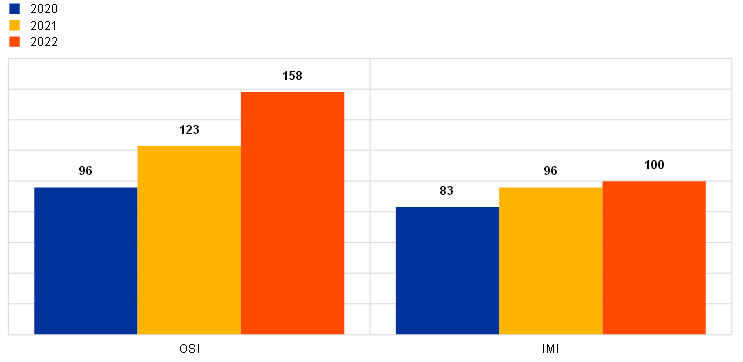
Source: ECB Banking Supervision.
1.3.2.1 Key findings from on-site inspections
The following analysis provides an overview of the most critical findings identified in OSIs.[20]
Credit risk
Marking a shift from the previous year, the credit risk OSIs conducted in 2022 focused more heavily on the quantitative approach, relying, more specifically, on credit file reviews and the IFRS 9 provisioning framework assessment (this was also supported by newly implemented challenger methodologies for retail and granular portfolios). These reviews led to additional NPE reclassifications of exposures amounting to €4.2 billion, as well as additional provisions of €2.3 billion.
The findings that emerged from the 2022 credit risk OSIs highlighted the following important weaknesses, in descending order of occurrence and severity.
- Accounting risk classification and staging: shortcomings in the assessment of financial difficulties of borrowers causing inspection teams to reclassify exposures as unlikely to pay or as forborne and to identify additional exposures under IFRS 9, with stage 2 status.
- Individual and collective provisioning calculation: shortcomings in the probability of default and loss given default (LGD) parameters of the collective provisioning models, weaknesses in the significant increase of credit risk, insufficient integration of forward-looking information, lack of or optimistic cash flow analysis when estimating individual provisioning, overvaluation or improper consideration of collateral values, foreclosed assets and guarantees.
- Granting and monitoring process: deficiencies in the credit decision-making process, improper measure of debt servicing capacity, insufficient consideration of refinancing risk for bullet loans, incomplete underwriting criteria.
- Data quality: poor data quality of the loan data tapes provided by the inspected institutions, internal IT systems that do not support the appropriate detection, monitoring and classification of credit risk.
Internal governance
Similar to the previous year, OSIs conducted in 2022 covered various governance topics, with a particular focus on the supervisory priorities. The most critical findings[21] revealed deficiencies in the following governance areas.
- Internal control functions (including compliance, risk management and internal audit): severe shortcomings in the status, resources, and scope of activity of all internal control functions.
- Risk data aggregation and risk reporting: insufficient governance arrangements, weaknesses in data quality management raising concerns about the ability to generate accurate and reliable risk data, and inaccuracy and inadequacy of risk management reporting.
- Outsourcing: inadequate risk assessments for decision-making on outsourcing and flaws in the delivery and monitoring of outsourced services, especially in relation to IT services.
- Corporate structure and organisation: weak institution-wide risk culture, deficiencies in internal control frameworks and inadequate human and technical resources.
IT risk
In line with the 2022-24 supervisory priorities, in 2022 the number of IT risk OSIs that focused on IT and cybersecurity risk management increased and findings in this area represented around half of the most severe findings identified in the IT risk OSIs in 2022.
Of the remaining findings, the highest proportion related to deficiencies in IT project management (i.e. 12% of all severe IT risk findings in 2022). On the one hand, this corroborated the observation that the main root cause for downtimes of critical services was software changes, as was reported by banks in the IT Risk Questionnaire.[22] On the other hand, the number of findings in this area was concerning given the higher expectations of agility with respect to software changes made to support digital transformation (another focus area of the supervisory priorities).
For further information about IT and cyber risk, see Section 1.2.3.1.
Regulatory capital and the internal capital adequacy assessment process
The internal capital adequacy assessment process (ICAAP) campaign launched in 2020 was further deployed in 2021 and 2022 to address structural weaknesses in risk quantification and capital projections in order to strengthen capital planning.
The main findings on regulatory capital (Pillar 1) were related to (i) lack of adequate formalisation of the process to calculate regulatory capital requirements; (ii) insufficient control framework for the capital requirements and own funds calculation process; and (iii) incorrect allocation of exposures to exposure classes or inadequate assignment of risk weights to exposures.
The most severe issues identified in the ICAAP inspections concerned (i) weak internal quantification methodologies (e.g. for credit risk, market risk or interest rate risk); (ii) lack of robustness of the multi-year capital planning process; (iii) inadequate methodology to identify material risks as part of the risk identification process; and (iv) absent or inconsistent links between the ICAAP and the business strategy, the risk strategy and the risk appetite framework.
Business model and profitability
Based on the business model OSI campaign launched in 2021, in 2022 OSIs in this area were again conducted with a focus on the key aspects of the campaign (e.g. the strategy review, profitability analysis, loan pricing and financial projections).
The most critical findings were the overly optimistic and poorly structured financial projections developed by some financial institutions. Additionally, the following deficiencies were identified.
- Feeble strategy process, characterised by insufficient monitoring, leading to a failure to achieve the strategic objectives.
- Inadequate profitability analysis with deficient steering owing to inappropriate strategic key performance indicator assessment processes and the failure to implement these indicators in practice.
- Ineffective pricing framework, jeopardising actual profitability and strategic objectives.
Market risk
The market risk OSIs conducted in 2022 focused on the valuation risk of Brexit banks, which were assessed as part of the interest rate risk in the banking book campaign, and on counterparty credit risk.
The main weaknesses identified in 2022 related to fair value measurement and additional value adjustments (insufficient market data source reliability and independent price verification coverage, inadequate methodologies for the fair value hierarchy and additional value adjustments, concerns about the day-one profit amortisation schemes). Shortcomings were also identified in the model risk management framework (notably relating to the model validation process and corrections of risk parameters) and counterparty risk management (mainly relating to counterparty risk management stress test frameworks, identification, measurement and limit setting, as well as collateral management).
Liquidity risk
There was no change to the scope for the liquidity risk OSIs. Most of the high-severity findings were related to weaknesses in risk measurement and monitoring (deficiencies in robustness of parameters and assumption choices), regulatory reporting (misclassification of LCR sub-components), and the stress-testing framework (deficiencies in scenario design).
Interest rate risk in the banking book
The majority of critical findings concerned weaknesses in the stress test scenario framework (deficiencies in scenario design and in the application of the supervisory outlier test), as well as in the measurement and monitoring of interest rate risk in the banking book. In particular, this concerned the inadequacy of the quantification models used for behavioural modelling assumptions, deficiencies in model validation and back-testing.
1.3.2.2 Key findings from internal model investigations
In 2022 the IMI approach focused on the following aspects.
The EBA’s internal ratings-based repair programme: a large number of internal model-related requests were received from banks which aimed to implement changes to their models in order to meet the new requirements set out by the EBA as part of the regulatory review of the internal ratings-based (IRB) approach (commonly referred to as the IRB repair programme). The deadline for complying with most of these requirements was end-2021. Therefore, a very high number of requests from those banks were assessed in the course of 2022.
The most critical findings related to data quality processes. With regard to the modelling framework on probability of default estimation, the most critical findings concerned the long-run average calculation and the margins of conservatism, whereas for the LGD estimation, there were a high number of severe findings for the calculation of realised LGD and the LGD downturn estimation.
TRIM follow-up: the 200 on-site investigations conducted within the targeted review of internal models (TRIM) revealed that banks needed to do more to improve the way they implemented and used internal models. Continuous supervisory scrutiny is considered important to ensure that banks effectively address the deficiencies identified. In general, for the IRB model, the TRIM follow-up was bundled with IMIs dedicated to the aforementioned EBA IRB repair programme.
New institutions under direct ECB Banking Supervision: as a result of the United Kingdom exiting the EU and the relocation of institutions within the banking union, some institutions required the ECB’s approval to continue using their internal models that had been approved outside of the scope of European banking supervision. A significant number of IMIs in 2022 sought to review such models, in particular, the internal model approach for market risk and counterparty credit risk.
As a result of the market risk IMIs, governance and outsourcing deficiencies were among most of the findings at Brexit banks owing to their heavy reliance for risk management, model development and monitoring on group functions or other entities within the group outside of the scope of European banking supervision. Furthermore, these banks were found to be lagging behind other institutions in terms of compliance with regulatory standards and the ECB’s understanding of such regulatory requirements, for instance in areas such as the implementation of a risk-not-in-the-model-engine[23] framework and the back-testing of not-yet-mature market risk portfolios. For some market risk categories, the market risk models did not cover a significant share of positions, which is, however, a prerequisite for the use of internal models.
As a result of the counterparty credit risk IMIs, Brexit-specific findings also related to governance and outsourcing, revealing that Brexit institutions relied heavily on the group for risk management, model development and monitoring, similar to the case for market risk. Findings also included internal model aspects that were atypical for Brexit institutions, for example, validation (especially for back-testing coverage), data quality, stress calibration and modelling of trade-related cash flows during the margin period of risk[24].
Finally, the ECB received and assessed applications related to reverting to less sophisticated approaches, especially in the context of the initiatives launched by banks to simplify their model landscapes in line with the ECB’s supervisory expectations. Particular attention was paid to preventing any cherry-picking of these reversions.
1.4 Indirect supervision of less significant institutions
1.4.1 Structure of the less significant institution sector
The LSI sector remains rather fragmented overall. However, 83% of all European LSIs are located in Germany, Austria and Italy. Therefore, these countries have also been the drivers of consolidation in the LSI sector.
The number of LSIs declined further to 2,032 in 2022, confirming the ongoing trend towards consolidation within the LSI sector
This ongoing consolidation trend in the LSI banking sector continued over the course of 2022, with the overall number of LSIs declining further from 2,089 at the end of 2021 to 2,032 in the third quarter of 2022 (Table 1), and Germany accounted for the bulk of this decline. In the first ten months of 2022, a total of 39 entities were either acquired or merged, of which 33 were German LSIs and five Austrian. Compared with the previous year, the number of institutions whose licence was withdrawn decreased significantly, from ten LSIs across all SSM countries in 2021 to only one LSI in 2022. Also, there was only one case of a licence lapsing. This was only partially offset by four new licences being granted in four different jurisdictions and another three entities (branches or financial holding companies) setting up operations under European banking supervision.
Table 1
Number of less significant institutions per country
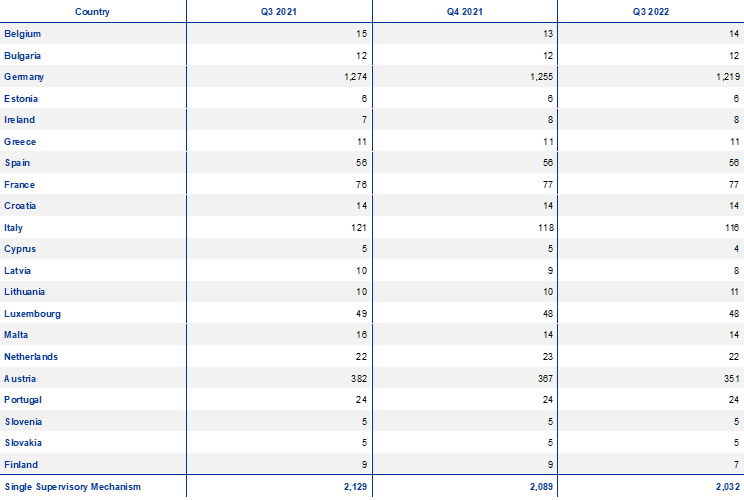
Source: ECB.
Note: Data reflect the highest level of consolidation, excluding financial market infrastructures.
Despite the declining number of LSIs, this sector continues to represent a relevant share of the wider European banking sector, holding roughly 15% of total banking assets excluding financial market infrastructures, and 18% including financial market infrastructures. The share of LSI assets in the respective country’s total banking assets explains the importance of the LSI sector in some Member States. It is also a good indication of the heterogeneity in terms of the composition of the various domestic banking systems across the 21 countries under European banking supervision. In Luxembourg, Germany, and Austria, LSIs accounted for more than one-third of the total assets held in the domestic banking sector. By contrast, in countries where the banking sector is more concentrated, the LSI sector is relatively small. For instance, in France, Greece and Belgium, it represented only 2.6%, 3.5% and 5.5% respectively of total banking assets.
Chart 19
Market shares of significant institutions and less significant institutions
(as a percentage of total banking assets)
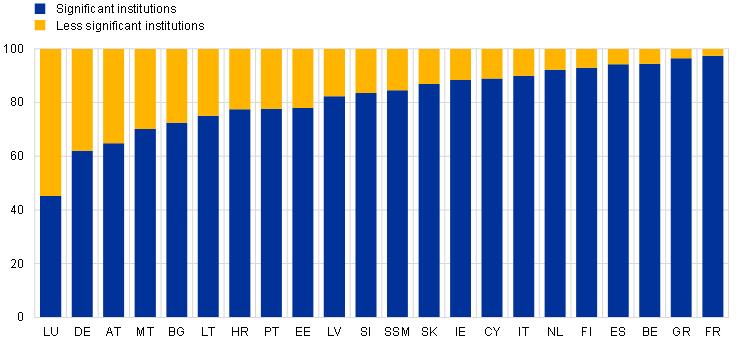
Source: ECB calculations based on FINREP F 01.01, F 01.01_DP.
Note: The chart displays the market share calculated at the highest level of consolidation. This means that branches and entities that are subsidiaries of SSM parent entities are included in the total assets of their parent entities and are not considered in the respective market share of the local banking sector. For Bulgaria, Croatia and Slovakia, exceptions to this general methodology are made and the market shares of SIs in these countries include the total assets of entities that are local subsidiaries of cross-border SSM parent entities. The market share percentages for Bulgaria, Croatia and Slovakia therefore follow a different methodology and are not directly comparable with those of the other countries in the chart.
The LSI sector is composed of a variety of dynamic market segments, from consumer credit and real estate lending to private banking and asset management. LSI activities tended to be more geographically concentrated than those of SIs, with retail lending being the predominant business model. Therefore, the LSI sector tended to be dominated by a high number of regional savings and/or cooperative banks, with most of the banks in Germany and Austria also being members of institutional protection schemes – more than two-thirds of all LSIs in Austria and around 90% in Germany.
Chart 20
Business model classification of less significant institutions
(percentages in relation to number of national less significant institutions)
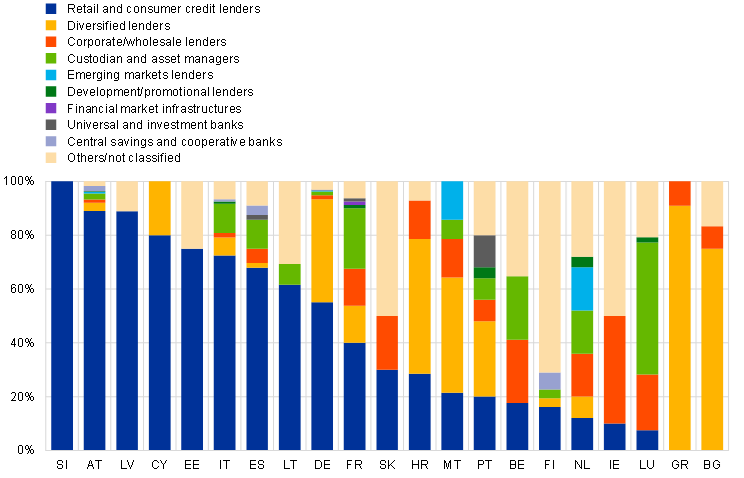
Source: ECB calculations based on FINREP F 01.01, F 01.01_DP.
Note: The chart displays the market share calculated at the highest level of consolidation. This means that branches and entities that are subsidiaries of SSM parent entities are included in the total assets of their parent entities and are not considered in the respective market share of the local banking sector. For Bulgaria, Croatia and Slovakia, exceptions to this general methodology are made and the market shares of SIs in these countries include the total assets of entities that are local subsidiaries of cross-border SSM parent entities. The market share percentages for Bulgaria, Croatia and Slovakia therefore follow a different methodology and are not directly comparable to those of the other countries in the chart.
1.4.2 Selected oversight activities
Credit risk remains a key area of supervisory focus for LSIs, despite a continued decrease in the NPL ratio in 2022
Despite the steady downward trend in NPL levels over recent years, credit risk remains a key source of concern for LSIs given the current macroeconomic and geopolitical uncertainty. The aggregated NPL ratio (excluding central bank funding) in September 2022 stood at 2.1%, down from 2.3% in September 2021. Similarly, the number of high-NPL LSIs[25] continued to decline, from 208 to 183 year on year.
Following numerous supervisory activities on credit risk over recent years, a joint framework for the regular, structured monitoring of credit risk trends for LSIs was developed and rolled out in 2022. This provided more granular benchmarks for the NCAs, allowing core indicators to be compared on a regular basis on aspects such as banks’ identification of forborne and unlikely-to-pay exposures, as well as provisioning practices across the LSI sector.
The thematic review of LSIs’ internal governance was finalised in 2022
Internal governance remained a key priority for European supervisors. ECB Banking Supervision conducted a thematic review of the governance arrangements of LSIs in 2021/22 in cooperation with national supervisory authorities, using data from a sample of almost 300 LSIs across the 21 participating countries. The review covered a broad range of aspects related to internal governance, including the functioning of LSI management boards, complemented by a survey on relevant national supervisory practices. ECB Banking Supervision and national supervisors will continue to promote greater alignment of supervisory expectations and standards for internal governance, addressing any weaknesses identified along the way.
Weak profitability was the topic of numerous supervisory activities
At the same time, profitability also remained a matter of concern for large parts of the LSI sector (see Section 1.1.2). Therefore, European supervisors carried out numerous activities in this regard, including activities relating to digitalisation in areas such as the use of deposit platforms by LSIs or the close monitoring of LSIs using fintech business models. Furthermore, supervisors also conducted dedicated sectoral analyses on areas such as credit unions and building societies or the monitoring of savings banks and institutional protection scheme networks, as well as on Brexit, with the focus being on business models and profitability.
In 2022 ECB Banking Supervision ran a pilot exercise on the supervisory effectiveness of LSIs
In addition, in 2022 a pilot exercise intended to support the overall objective of improving the consistency of supervisory outcomes for LSIs under European banking supervision was launched. The exercise was designed to measure the effectiveness of the supervision and oversight of LSIs under European banking supervision based on both quantitative and qualitative information. The focus areas included supervisory resources, supervisory activities (e.g. on-site inspections), the intensity of supervisory dialogue with LSIs and compliance with EBA guidelines.
Numerous further supervisory and oversight initiatives were taken in line with the overall supervisory priorities and core risks identified for the LSI sector
Further LSI oversight initiatives included thematic work on climate risk, crisis management, and a review of NCA stress-testing practices. Additional details on those and further initiatives are provided in the LSI supervision report 2022.
1.4.3 Stocktake of national practices for stress testing of LSIs
ECB Banking Supervision continued to foster overall convergence in the area of the supervisory stress testing of LSIs by conducting a stocktake of national stress-testing practices across LSIs. Benchmarking the current approaches at the national level provided the basis for further progress towards promoting consistency, as appropriate – for instance, facilitating the use of common scenarios. The exchange of good practices among NCAs will also contribute towards the harmonisation of stress-testing practices across LSIs to the extent warranted by the specificities of the national LSIs, while fully respecting the proportionality principle.
1.5 The ECB’s macroprudential tasks
The ECB continued to engage actively with the national authorities in 2022, in accordance with the macroprudential tasks conferred on it under Article 5 of the SSM Regulation[26]. In this context, as in past years, the ECB received and assessed macroprudential policy notifications from the relevant national authorities. These notifications concerned decisions on setting countercyclical capital buffers (CCyB), decisions on the identification and capital treatment of global systemically important institutions (G-SIIs) or other systemically important institutions (O-SIIs), as well as decisions on other macroprudential measures, for example on the setting of systemic risk buffers and measures under Article 458 of the Capital Requirements Regulation.
During the COVID-19 pandemic, several national authorities decided to release capital buffers to support lending during this time. However, in 2021, some national authorities started reimposing positive CCyB requirements to address growing cyclical risk. This development continued into 2022, with several national authorities increasing cyclical and structural capital buffers amid rising macro-financial vulnerabilities. National authorities also identified 129 O-SIIs and set capital buffer rates for those banks. These buffer rates were in line with the floor methodology for setting the O-SII buffers, which the ECB has followed since 2016. On 21 December 2022 the ECB announced that as from 1 January 2024, the ECB would be using a revised floor methodology to assess O-SII buffers.[27] The revised floor methodology is designed to strengthen the capacity of O-SIIs to absorb losses, further reduce the risk of heterogeneity in O-SII buffers and lead to a more consistent treatment of O‑SIIs across those countries that fall under European banking supervision.
In March 2022, the ECB published its response to the European Commission’s call for advice on the review of the EU macroprudential framework.[28] This call for advice had also been addressed to the EBA and the European Systemic Risk Board (ESRB), which published their responses in parallel.[29]
Progress in the development of the European banking union was recognised in a revised assessment methodology for G-SIIs
In May 2022 the Basel Committee on Banking Supervision made a change to its G-SIB methodology in order to recognise progress made in the development of the European banking union. The revised methodology allows supervisors the discretion to reduce the weight given to intra-banking union assets and liabilities in the assessment of banks’ systemic importance.[30] As a follow-up, the ECB released a statement on 27 June 2022 on the treatment of the European banking union in its assessment methodology for global systemically important banks.[31] In line with the G-SIB methodology, the ECB and national authorities identified eight G-SIIs under European banking supervision in 2022 that would be required to hold additional capital buffers ranging from 1.0% to 1.5% in 2024.[32]
On 2 November 2022 the Governing Council issued a statement in which it noted that some national authorities and the ECB were exploring whether an increase in macroprudential capital buffers in some countries was warranted to preserve resilience and to ensure that banks were able to withstand systemic risks, should they materialise at a later point in time.[33] The statement also acknowledged and endorsed the warning on vulnerabilities in the financial system issued by the ESRB on 22 September 2022, for which the ECB was one of the addressees.[34]
ECB Banking Supervision also participated actively in several areas of the work of the ESRB. This included the ESRB’s work on commercial and residential real estate[35], cyber risks and climate-related risks, crypto-assets and decentralised finance. It also included the adverse scenario for the EBA’s 2023 EU-wide stress test exercise and the Summary Compliance Report in the context of the ESRB’s recommendations on the restriction of distributions during the COVID-19 pandemic.[36]
1.6 Risks and supervisory priorities for 2023-25
ECB Banking Supervision develops and updates flexibly its supervisory priorities following a thorough assessment of the main risks and vulnerabilities to the European banking sector
ECB Banking Supervision continuously assesses and monitors the risks and vulnerabilities faced by institutions under its direct supervision. The outcome of this assessment, which also reflects insights from the SREP, supports the development and update of its medium-term strategy and corresponding supervisory priorities. These supervisory priorities promote effectiveness and consistency in the supervisory planning of the JSTs, thereby fostering a more efficient allocation of resources. They also help NCAs to set their own priorities for the supervision of less significant institutions in a proportionate manner (see Section 1.4).
ECB Banking Supervision updated its supervisory priorities for 2023-25 to address immediate risks from the current environment, as well as more structural challenges
The geopolitical shock caused by Russia’s invasion of Ukraine in February 2022 and its immediate macro-financial consequences in the form of higher energy and commodity prices, and therefore rising inflation, increased uncertainties about developments in the economy and financial markets, in turn elevating risks to the banking sector. In this challenging environment, ECB Banking Supervision, in close collaboration with the NCAs, updated its strategic priorities for 2023-25. Supervised institutions will be required to first strengthen their resilience to the immediate consequences of macro-financial and geopolitical shocks (Priority 1); second, address digitalisation challenges and strengthen management bodies’ steering capabilities (Priority 2); and third, step up their efforts in addressing climate change (Priority 3) (Figure 1).
Figure 1
Supervisory priorities for 2023-25 – addressing identified vulnerabilities in banks
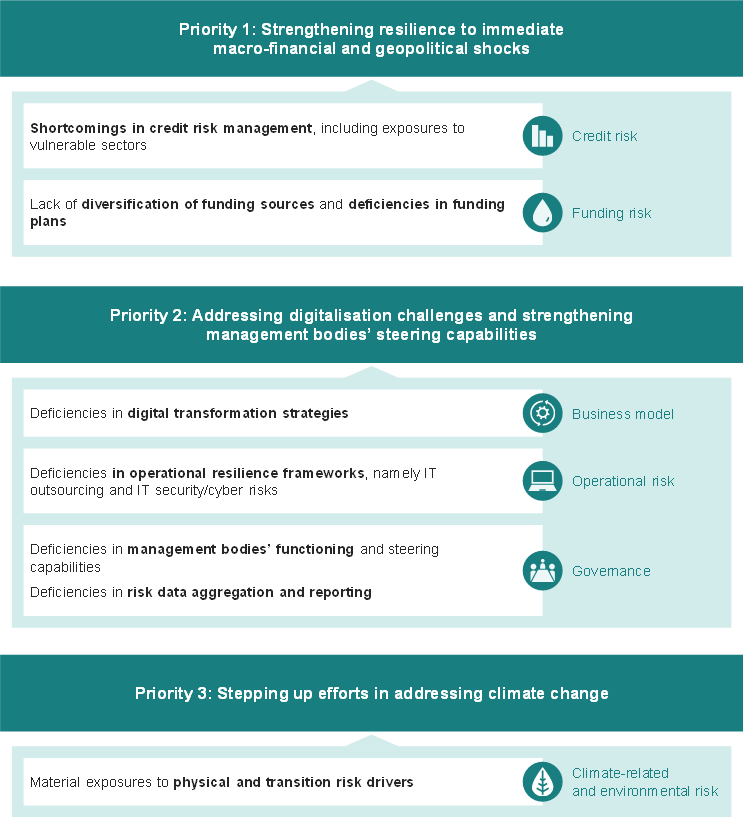
Source: ECB.
Notes: The figure shows the three supervisory priorities and the corresponding vulnerabilities banks are expected to address over the coming years. ECB Banking Supervision will carry out targeted activities to assess, monitor and follow up on the identified vulnerabilities. Each vulnerability is associated with its overarching risk category. Vulnerable sectors are the sectors more sensitive to the current macroeconomic environment.
1.6.1 Priority 1: Strengthening resilience to immediate macro-financial and geopolitical shocks
Banks performed well in the first half of 2022, but uncertainties and risks have since increased significantly
During the first half of 2022, supervised institutions performed well overall, supported by the economic rebound following the gradual easing of restrictions related to the coronavirus (COVID-19) pandemic and the stepwise normalisation of interest rates. Banks reported sound capital ratios and ample liquidity buffers throughout the period, reflecting the strong overall resilience of the sector. While the direct impact of the Russian war in Ukraine has remained contained so far for most supervised institutions, the macroeconomic shock, which exacerbated pre-existing inflationary pressures and lingering supply chain bottlenecks, spread more widely, particularly across Europe. As a consequence, financial and non-financial risks increased for the European financial sector. Against this background, ECB Banking Supervision’s primary objective in the near term is to ensure that banks under its direct supervision strengthen their resilience to immediate macro-financial and geopolitical shocks. The 2023 EU-wide stress test exercise, coordinated by the EBA, will support this effort and feed into the outcome of the next SREP cycle, contributing to the supervisory priorities for 2023.
Banks should address shortcomings in credit risk management, including exposures to vulnerable sectors
The combination of lower growth, persistently high inflation and increasing interest rates is likely to affect the debt servicing capacity of corporates and households, particularly those with higher levels of indebtedness. Rising interest rates are also adding pressure to the real estate sector where vulnerabilities have been accumulating, as illustrated by the persistent signs of overvaluation in house prices, rising construction costs and the shift towards remote working, which is weighing on the commercial sector most of all. Against this background, banks should be in a position to swiftly identify and mitigate any build-up of risks in their credit exposures to sectors that are more sensitive to the current macroeconomic environment. While banks have achieved some progress over recent years, the 2022 SREP exercise confirmed that shortcomings persist in their risk controls, especially in relation to loan origination and monitoring, classification of distressed borrowers and provisioning frameworks. ECB Banking Supervision will therefore strengthen and intensify its efforts in this area, and while most of the activities planned for the years ahead are a continuation of last year’s priority work programme, the focus will be adjusted to also cover the sectors most affected by the consequences of the Russian invasion of Ukraine (e.g. energy-intensive sectors) and by the macroeconomic environment.
Banks should address the lack of diversification in funding sources and deficiencies in funding plans
The exceptional monetary policy measures introduced during the pandemic provided banks with abundant liquidity at reduced costs. During this period, banks increased their reliance on central bank funding at the expense of the share of market funding, relatively speaking. The sharp increase in inflation observed since the start of the Russian war in Ukraine, and the subsequent tightening of monetary policies in advanced economies, marked the end of the “lower-for-longer” era. The direct consequence for banks was an increase in central bank funding costs and spreads in wholesale markets. Looking ahead, banks may therefore face funding challenges if they turn towards more wholesale funding sources precisely at a time when it is becoming more costly to do so and when investors’ risk appetite is decreasing. This may have an impact on banks’ profitability and their ability to maintain their current liquidity and funding ratios. Risks stemming from banks’ high reliance on TLTRO III funds and their related exit strategies require continued supervisory scrutiny, as highlighted by some JSTs in this year’s SREP. In this context, ECB Banking Supervision will strengthen its engagement with a targeted number of banks with more vulnerable funding structures and/or weaker liquidity and funding risk management practices. Supervised institutions will be asked to develop, execute and adjust as needed a sound and reliable liquidity and funding plan, covering exit strategies and mitigation of rollover risks and concentrations in funding structures
1.6.2 Priority 2: Addressing digitalisation challenges and strengthening management bodies’ steering capabilities
Banks need to also address structural challenges and risks associated with operating in an increasingly digital environment with a view to ensuring the resilience and the sustainability of their business models.
Banks need to develop and implement sound digitalisation strategies
Digitalisation is not only a key driver of efficiency gains, but it is also crucial for banks to remain competitive. In this regard, banks need to adapt their digital transformation strategies both to address continuously evolving consumer preferences and to withstand the intensification of competition with digital champions in the banking sector and non-bank digital natives offering banking services. In the coming years, ECB Banking Supervision intends to update and publish its supervisory expectations on digital transformation strategies, assessing banks’ current strategies in the form of both targeted OSIs and targeted reviews. Furthermore, supervisors will follow up on any outlier institutions to complement the overall strategy and induce banks to address identified structural deficiencies.
Digitalisation can also pose a substantial threat to banks in terms of their operational resilience. In particular, banks need to address risks stemming from the high reliance on third parties for critical IT services and deficiencies in IT outsourcing arrangements, which could result in increasing losses owing to the unavailability or poor quality of outsourced services. They also need to proactively tackle cyber risks linked to IT security, the probability of which have increased in the context of heighted geopolitical tensions and the Russian war in Ukraine. Against this background, ECB Banking Supervision will continue to review banks’ outsourcing arrangements and cybersecurity measures and will conduct target reviews and OSIs to follow up on any identified deficiencies.
Banks need well-functioning and diverse management bodies with strong strategic steering capabilities
Sound internal governance arrangements and effective strategic steering are crucial to ensuring the sustainability of banks’ business models. Banks have made progress in improving the collective suitability of their management bodies and adapting their diversity policies, but some areas still require attention, such as compliance with gender representation targets or skills diversity. Shortcomings are also observed in the succession planning process and the capacity of management bodies to provide oversight and challenge management functions, as well as in the formal independence of the management bodies in some of these banks. ECB Banking Supervision will continue to strive to achieve progress in these areas through targeted reviews, OSIs and targeted risk-based fit and proper assessments. Supervisors will also update and publish supervisory expectations on governance and risk management.
Persistent deficiencies in the area of risk data aggregation and reporting need to be addressed
Access to timely and accurate data and reports is not only a prerequisite for effective strategic steering, but also for risk management and sound decision-making. Yet, material deficiencies in the area of risk data aggregation and reporting have repeatedly been identified during the annual SREP exercises. Banks have shown slow and insufficient progress in closing gaps with respect to supervisory expectations and compliance with the relevant Basel Committee on Banking Supervision principles. ECB Banking Supervision will accordingly strengthen its efforts to ensure that supervised institutions deliver substantial progress in remedying the identified structural shortcomings, including by way of targeted engagement with banks and through OSIs.
1.6.3 Priority 3: Stepping up efforts in addressing climate change
Climate change can no longer be considered a long-term or emerging risk, since its impact is already visible and is expected to grow materially in the years to come. Addressing the challenges and capturing the opportunities posed by the climate transition is therefore becoming an urgent need for banks.
Risks associated with climate change need to be tackled as a matter of priority
The intensification of extreme weather events across Europe is increasing the likelihood and severity of physical risk losses. At the same time, the energy market disruption caused by the Russian war in Ukraine has further underlined the need for Europe to maintain momentum in the transition to renewable energy sources. Banks therefore need to adequately incorporate C&E risks within their business strategy, governance and risk management frameworks in order to mitigate and disclose these risks, aligning their practices with current regulatory requirements and supervisory expectations. To this end, ECB Banking Supervision will follow up on the deficiencies identified in the 2022 climate risk stress test[37] and thematic review[38], monitoring banks’ progress and taking enforcement actions, if necessary, to ensure full alignment with its expectations by the end of 2024.
2 Authorisations, enforcement and sanction procedures
2.1 Authorisations
2.1.1 Significance assessments, comprehensive assessments and identification of high-impact less significant institutions
2.1.1.1 Significance assessments
The ECB has been directly supervising 113 banks since 1 January 2023, following the annual review of significance and ad hoc assessments
In line with the SSM Framework Regulation[39], the annual assessment of whether a bank or banking group fulfils any of the significance criteria[40] was concluded in November 2022. It was supplemented by ad hoc significance assessments (leading to 60 significance decisions) which were carried out following changes to group structures.
As a result, 113 institutions[41] were classified as significant as of 30 November 2022, down from 115 in the previous annual assessment of significance.
Following the 2022 annual assessment, AS LHV Group was classified as significant because it met the economic importance criterion on 31 December 2021. The ECB assumed direct supervision of AS LHV Group on 1 January 2023.
Furthermore, as a result of four Class 1 investment firms being licensed as significant credit institutions, two new individual significant institutions (SIs) were added to the list of supervised entities: Citigroup Global Markets Europe AG as of 15 October 2022 and BofA Securities Europe SA as of 8 December 2022. Two other significant credit institutions were added to existing significant groups: Morgan Stanley Europe SE to Morgan Stanley Europe Holding SE, with effect from 2 September 2022, and Portzamparc to BPCE S.A., with effect from 3 November 2022.
Meanwhile, four institutions were removed from the list of significant entities.
- J.P. Morgan Bank Luxembourg S.A. was removed following its merger by absorption into J.P. Morgan AG with effect from 22 January 2022.
- Banque Degroof Petercam SA ; Bank Degroof Petercam NV and its subsidiaries were reclassified as less significant institutions (LSIs). The ECB’s direct supervision of these entities ended on 25 February 2022.
- Sberbank Europe AG in Abwicklung’s licence lapsed with effect from 15 December 2022.
- RCB Bank LTD’s licence was withdrawn by the ECB with effect from 23 December 2022.
In addition, the following changes to group structures took place, affecting the number of significant supervised entities.
- Swedbank Baltics AS was classified as significant, based on size, following the acquisition of Swedbank AS, “Swedbank” AS and „Swedbank”, AB, which became subsidiaries of Swedbank Baltics AS. It has been directly supervised by the ECB since 4 January 2022.
- Banca Carige S.p.A. – Cassa di Risparmio di Genova e Imperia and its subsidiaries were acquired by BPER Banca S.p.A., becoming part of the significant supervised group headed by BPER Banca S.p.A. with effect from 3 June 2022.
Finally, the following changes to group structures took place, without affecting the number of significant supervised entities.
- CrelanCo SC ; CrelanCo CV was classified as significant, based on size, following the acquisition of more than 50% of the capital and voting rights in AXA Bank Belgium SA, which became a subsidiary of CrelanCo SC ; CrelanCo CV. The ECB assumed direct supervision of CrelanCo SC ; CrelanCo CV on 1 February 2022.
- Quintet Private Bank (Europe) S.A. became the top entity of its significant supervised group following the transfer of Precision Capital S.A.’s statutory seat, registered office and central administration from Luxembourg to Qatar and the merger by absorption of Banque Puilaetco Dewaay Luxembourg S.A. into Quintet Private Bank (Europe) S.A., with effect from 25 February 2022.
The list of supervised entities is frequently updated. The most recent version of the list can be found on the ECB’s banking supervision website.
Table 2
Significant banking groups or stand-alone banks under European banking supervision following the 2022 annual assessment

Source: ECB.
Notes: “Total assets” refers to the total assets of entities included in the list of supervised entities as published in December 2022 (with a reference date of 30 November 2022 for the significance decisions notified to the supervised institutions resulting from the annual significance assessment, and of 1 November 2022 for other changes and developments in group structures). The reference date for total assets is 31 December 2021 (or the latest available, as used for the latest significance assessment). The number of entities considers all developments in significant group structures up to and including 1 November 2022 and all developments in significance decisions up to and including 30 November 2022.
2.1.1.2 Comprehensive assessments and asset quality reviews
In the first half of 2022 the ECB concluded three comprehensive assessments launched in 2021. The three banks assessed each fulfilled a criterion to be directly supervised by the ECB: Addiko Bank AG in Austria (significant cross-border activities), Agri Europe Cyprus Limited in Slovenia (among the three largest credit institutions in the Member State) and Barclays Bank Ireland PLC in Ireland (size).
The asset quality review (AQR) and the supervisory stress test were decoupled in 2022, meaning they are now treated as two separate and independent supervisory exercises.
In 2022 the ECB launched AQR exercises for four banks. The AQRs of AS “Citadele banka” in Latvia (among the three largest credit institutions in the Member State) and the Belgian bank Crelan SA (size) were launched in May 2022 and those of Goldman Sachs Bank Europe SE (size) and Morgan Stanley Europe SE (size) were launched in September 2022. The AQR exercises are expected to be completed by the end of March 2023.
2.1.1.3 High-impact less significant institutions
Owing to the large number of LSIs, as well as their differences in terms of size, complexity and risk profile, European banking supervision classifies these institutions based on their impact on the financial system and their risk profile. Since 2022 impact criteria and risk criteria have been assessed separately. High-impact LSIs are determined once a year for each of the countries participating in European banking supervision.
An LSI is designated as high-impact if it meets any one of the following criteria.
- Size
The institution’s total assets are greater than €15 billion. - Importance for the economy
The institution’s total assets are greater than 15% of the country’s GDP,
or it is an “other systemically important institution” within the meaning of the Capital Requirements Directive (CRD)[42]. - Potentially significant institution
The LSI is a “large institution” within the meaning of the revised Capital Requirements Regulation (CRR II)[43] (an institution that meets one of the significance criteria but is not classified as significant). - Cross-border activities
The LSI owns one or more credit institutions in one or more other participating countries. - Business model
The LSI is a financial market infrastructure with a banking licence, a central savings or central cooperative bank or the central institution of an institutional protection scheme. - Minimum coverage rule
If fewer than three high-impact LSIs are identified in a jurisdiction using the above criteria, the minimum coverage rule applies. The minimum coverage rule requires that additional LSIs are selected by size until three high-impact LSIs are identified.
If an LSI no longer meets the criteria – except in cases where the grounds for high-impact status were cross-border activities, business model or the minimum coverage rule – it retains its high-impact status for the following two years, under what is known as the stability rule.
An LSI that is considered a small and non-complex institution within the meaning of CRR II cannot be designated as a high-impact LSI unless it is the largest LSI in a jurisdiction where all LSIs are small and non-complex institutions.
2.1.1.4 Implications of high-impact LSI designation
The designation of an LSI as high-impact is a factor that national competent authorities (NCAs) take into account when determining the frequency and level of detail of their supervisory activities, such as the Supervisory Review and Evaluation Process and on-site inspections. In addition, NCAs are obliged to notify the ECB of any material supervisory procedures or decisions they intend to implement in respect of these institutions, in line with Articles 97 and 98 of the SSM Framework Regulation.
The following table lists the high-impact LSIs for 2023, as adopted by the Supervisory Board of the ECB. The grounds for the high-impact LSI status for each institution are provided to ensure the transparency of the classification.
Table 3
List of high-impact less significant supervised entities for 2023

Bulgaria

Germany
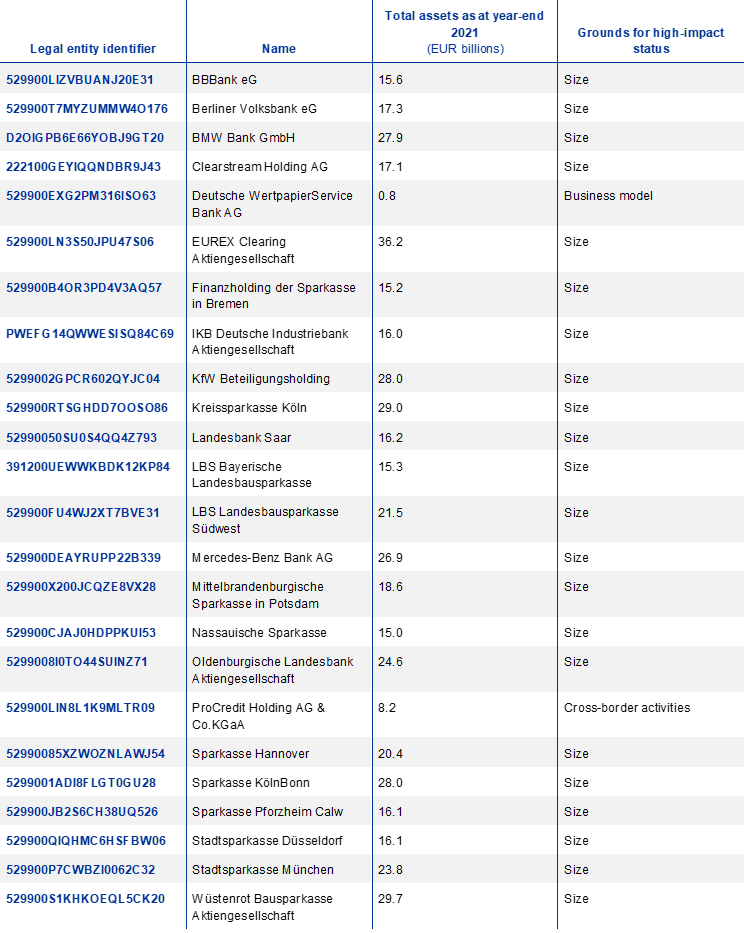
Estonia

Ireland

Greece

Spain

France
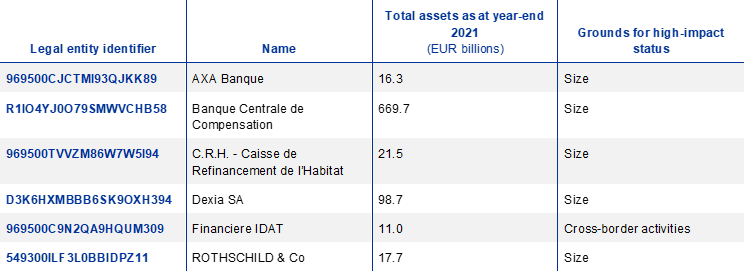
Croatia

Italy
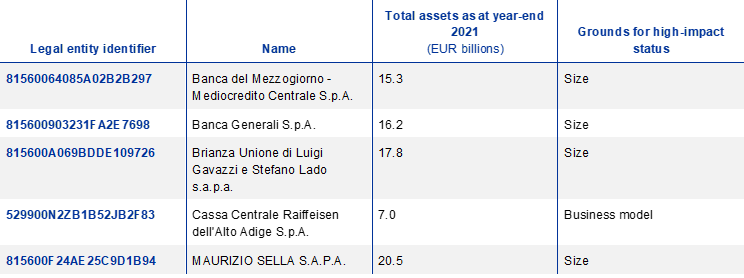
Cyprus

Latvia

Lithuania

Luxembourg

Malta

Netherlands
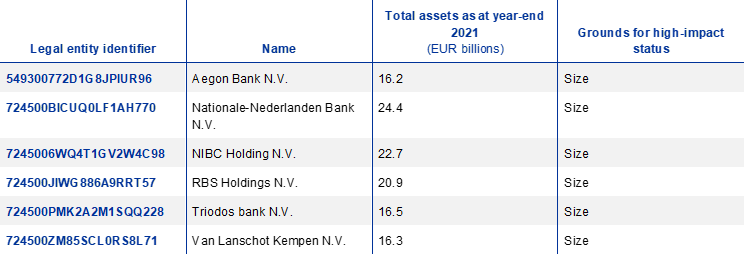
Austria
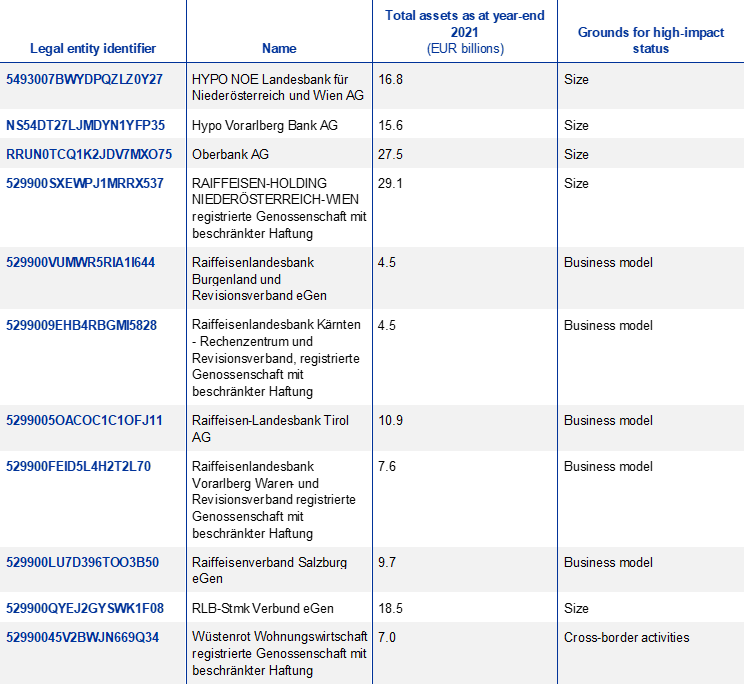
Portugal

Slovenia

Slovakia

Finland

2.1.2 Authorisation procedures
In 2022 ECB Banking Supervision was notified of a total of 759 authorisation procedures
In 2022 ECB Banking Supervision was notified of a total of 759 authorisation procedures (Table 4). These notifications comprised 30 licence applications, 22 licence withdrawals, 64 lapsings of authorisations, 87 acquisitions or increases of qualifying holdings, 549 passporting procedures and seven authorisations of financial holding companies. The NCAs and the ECB were also involved in authorising investment firms as credit institutions following the entry into force of the new framework for the supervision of investment firms in June 2021.
Table 4
Notifications of authorisation procedures submitted to the ECB by significant and less significant institutions

Source: ECB.
In 2022 244 authorisation procedure decisions[44] were finalised. Of these, the Supervisory Board submitted 108 draft decisions which were then approved by the Governing Council. The remaining 136 were approved by senior management within the framework for delegation.[45] These numbers include 98 operations (such as the lapsing of authorisations and passporting procedures) that were implicitly approved by the ECB[46] by not objecting within the legal deadlines.
The 244 authorisation procedure decisions account for 9% of all ECB individual supervisory decisions in 2022.
One authorisation procedure led to a negative decision. Furthermore, 14 licence applications and seven notifications of acquisitions or increases of qualifying holdings were withdrawn prior to a decision being finalised owing to a negative assessment. In one case, a supervisory measure was taken in accordance with Article 21a(6) of the revised Capital Requirements Directive (CRD V)[47] in relation to a financial holding company.
Compared with 2021, the number of notified authorisation procedures in 2022 remained largely unchanged.
2.1.2.1 Developments in common procedures
The number of notifications of common procedures submitted to the ECB remained similar to the previous year
Overall, in 2022 the number of notifications of common procedures for licensing, qualifying holdings and withdrawals submitted to the ECB remained similar to the previous year.
A high number of qualifying holdings were assessed by ECB Banking Supervision. In a few procedures, following concerns raised by supervisors during the initial assessment or the issuance of a negative decision by the ECB, applicants decided to withdraw their notifications or to exercise their right to be heard. In other cases, applicants decided to withdraw their applications owing to the prolonged uncertain macroeconomic environment or for case-specific reasons. Several qualifying holdings procedures stemmed from internal reorganisations that were subject to the simplified qualifying holdings assessment approach. As in previous years and despite emerging transformation and active consolidation dynamics, only limited cross-border consolidation was observed.
In 2022 most licensing procedures were associated with the establishment of new LSIs. The few licensing procedures concerning significant institutions resulted primarily from the need to extend licences for additional regulated activities planned by banks. In addition, several authorisations were granted under the new EU regulatory framework for investment firms, introduced with the application of the Investment Firms Regulation and Directive as of 26 June 2021.
As in previous years, one important driver of new licence applications was the increased use of digital innovations to provide services to EU clients (e.g. fintech business models). Most of the applications concerning business models involving crypto-asset activities and services were submitted by credit institutions based in Germany, owing to the specific licensing requirement imposed under German law. Some of these licence applications in Germany were withdrawn during the initial assessment. In addition, a licence application concerning a crypto-asset-related business model was submitted by an institution based in Luxembourg.
National frameworks governing crypto-assets vary quite significantly. Therefore, the ECB is taking steps to harmonise the assessment of licensing requests involving crypto-assets.
Box 4
Licensing of crypto-asset activities
Within the EU, the Council Presidency and European Parliament recently reached a provisional agreement on the markets in crypto-assets proposal, which will bring crypto-assets under a regulatory framework. Meanwhile, crypto-asset markets are developing apace, with banks considering whether to become involved. It is the role of the ECB to help ensure that banks choosing to engage in these activities do so safely and soundly. Like for any other licensing procedure, the ECB and the relevant NCA apply the CRD criteria when assessing licensing requests covering crypto-asset activities and services.
Crypto-assets are considered prone to risks associated with anti-money laundering and combating the financing of terrorism (AML/CFT). Here the ECB relies on input from national anti-money laundering authorities and financial intelligence units.[48]
In 2022 the ECB continued to receive a high number of licensing applications for banks with a fintech business model. The assessments showed that fintech firms tend to rely heavily on outsourced critical services owing to their limited staffing levels. Outsourcing critical services to external service providers increases operational risk, particularly in the area of IT services and cloud data storage, but also in authentication and know-your-customer procedures. Fintech firms often made use of the passporting regime which allows EU credit institutions to provide services or establish branches in any other EU country under the initial licence granted.
Several withdrawal procedures stemmed from institutions becoming directly or indirectly subject to the sanction regime implemented by the EU and the United States in response to the Russian war in Ukraine. The institutions affected had business models that had become non-viable or failed to comply with prudential requirements. Other licence withdrawals were due to institutions lacking financial soundness and having a non-viable business model or other severe prudential or AML/CFT-related shortcomings. One LSI exited the market through insolvency proceedings. Withdrawals were also triggered by voluntary terminations of business activity or by mergers and other types of restructuring.
2.1.2.2 Developments in passporting procedures and (mixed) financial holding companies
The ECB and NCAs handled 549 passporting procedures in 2022.
Approvals and exemptions for parent (mixed) financial holding companies were introduced under Article 21a of CRD V. In 2021 the ECB mainly took decisions regarding existing (mixed) financial holding companies.[49] In 2022 the ECB approved 11 financial holding companies, one of which was newly established in the supervised group. Other approvals were related to delays in the transposition of Article 21a into national law (i.e. after 29 December 2020), which had in turn delayed notifications. The ECB also took its first “joint decision” as the competent authority in a Member State where the (mixed) financial holding company was established with another competent authority as consolidating supervisor under Article 21a(8) of CRD V. Finally, a number of reorganisations took place in supervised groups which eliminated (mixed) financial holding companies from the group structure.
2.1.2.3 New ECB investment firm framework
The ECB and NCAs also continued their work on the authorisation of investment firms. In June 2021 a new framework for the supervision of investment firms entered into force, introducing criteria under which investment firms must apply for authorisation as credit institutions. Such authorisation needs to be obtained based on both qualitative (activities carried out) and quantitative (value of assets) criteria, on either a solo or a group basis. In 2021 and 2022 a legacy regime applied to investment firms qualifying for authorisation as credit institutions. Approximately 20 institutions are expected to fall under the bank licence requirement. So far, the NCAs have informed the ECB of 11 applications submitted, and in 2022 five firms were licensed, primarily in Germany, France and the Netherlands.
To foster a consistent assessment across investment firms and countries participating in European banking supervision, the ECB has developed a specific methodology that aims to strike a balance between (i) the need to assess these firms as any other institution requesting a banking licence, and (ii) the fact that these investment firms have been subject to prudential requirements imposed by national authorities before becoming credit institutions.
2.1.2.4 IMAS portal
The IMAS portal is the online platform which facilitates interactions and exchange of information between supervisors and supervised entities/third parties. The IMAS portal is part of the strategy to digitalise supervisory processes and covers the entire supervisory cycle.[50]
In 2022 the remaining authorisation procedures – namely licensing applications, voluntary withdrawals of authorisations and approvals and exemptions of financial holding companies – were added to the IMAS portal. A significant share of fit and proper procedures continue to be processed via the IMAS portal.
2.2 Fit and proper procedures
There were positive trends in fit and proper procedures in 2022
In 2022 ECB Banking Supervision was notified of a total of 2,445 individual fit and proper procedures (individual assessments of management and supervisory board members, key function holders and third-country branch managers, and approvals of additional non-executive directorships) (Table 5).
Table 5
Fit and proper procedures notified to the ECB

Source: ECB.
Notes: The sample includes all significant institutions (within the Single Supervisory Mechanism) which submitted fit and proper applications.
Around 67% of all fit and proper procedures received in 2022 concerned members of the management body in its supervisory function and 27% concerned members of the management body in its executive function. The remaining procedures involved key function holders (4%), third-country branch managers (1%) and additional non-executive directorships (1%).
Continuing a positive trend since 2019, the overall processing time of fit and proper procedures decreased to an average of 102 days. This is shorter than the maximum period of four months established in paragraph 179 of the Joint ESMA and EBA Guidelines on the assessment of the suitability of members of the management body and key function holders.
2.2.1 Developments in fit and proper assessments
The ECB identified concerns about one or more of the fit and proper criteria in 32% of the procedures in 2022. Similarly to previous years, the most common issues related to board members’ time commitment, experience and conflicts of interest. To mitigate these concerns, the ECB imposed ancillary provisions, namely 58 conditions, 225 obligations and 95 recommendations, on significant institutions. The ECB policy underlying such ancillary provisions was revised in 2022 (see Box 5).
If serious doubts are raised about the suitability of an appointee for an envisaged board or key function holder position, the fit and proper application is often withdrawn. In these cases, the supervisory dialogue with banks can pre-empt negative fit and proper decisions by the ECB. In 2022 16 applications were withdrawn in this manner.
The ECB also carried out 15 reassessments of members of the management bodies of banks. Seven of these reassessments were related to reputational issues and four to shortcomings in the area of anti-money laundering. Four board members resigned as a consequence of these reassessments.[51] Relevant AML/CFT-related information was also considered when assessing the suitability of board members in a total of 23 applications.
To promote diversity within the banks it supervises, in its fit and proper procedures the ECB also performs a collective suitability assessment that considers criteria such as diversity of gender, experience and background. In this context, fit and proper decisions make reference to relevant diversity findings, and ancillary provisions are imposed where national laws allow.
To increase the efficiency of fit and proper assessments, the ECB is continuing to develop its IT tools. By the end of 2022, all countries participating in European banking supervision were onboarded to the IMAS portal, which allows significant institutions to submit their fit and proper applications and monitor their progress until a final decision is taken. In 2022 banks’ use of the IMAS portal for fit and proper applications increased from 84% to 89%, which improved the overall processing time of these procedures. The ECB will continue to promote the full use of the IMAS portal by all significant banks.
In addition, significant progress was made in the development of the Heimdall tool, which streamlines the fit and proper process by automatically reading the questionnaires completed by banks and flagging issues based on their content. The tool makes use of optical character recognition, automatic translation and data analytics to reduce the manual workload and the possibility of human error.
Box 5
Revising the ECB’s ancillary provisions framework
To enhance the effectiveness of its fit and proper decisions, the ECB has revised its policy for fit and proper ancillary provisions. As explained in the November 2022 Supervision Newsletter, from 1 January 2023 ancillary provisions – which can be conditions, obligations or recommendations – attached to ECB fit and proper decisions will entail specific requirements and deadlines that address corrective needs to ensure that board members are suitable. This will further clarify ancillary provisions, making it easier for banks and supervisors to follow them up and, in turn, increasing the effectiveness of fit and proper decisions. In addition, under the revised policy the ECB will no longer impose obligations without deadlines, or obligations merely recalling the legal obligations with which banks have to comply in any case. This means that the total number of ancillary provisions will decrease, and those that will be imposed will provide banks and supervisors with a sharper focus, making these provisions a more effective supervisory tool. The revised policy on the use of ancillary provisions is another step in the ECB’s more intrusive and streamlined approach to fit and proper assessments and its efforts to improve the governance of banks.
2.3 Whistleblowing, enforcement and sanctioning
2.3.1 Enforcement and sanctioning measures
Under the SSM Regulation and the SSM Framework Regulation, the allocation of enforcement and sanctioning powers between the ECB and the NCAs depends on the nature of the alleged breach, the person responsible and the measure to be adopted (see ECB Annual Report on supervisory activities 2014). In accordance with the applicable legal framework, the penalties imposed by the ECB within the remit of its supervisory tasks are published on the ECB’s banking supervision website. The penalties imposed by the NCAs at the request of the ECB are published on the same website.
In 2022 the ECB handled ten sanctioning proceedings, which led to eight ECB decisions (Table 6).
In 2022 the ECB imposed six pecuniary penalties amounting to €12,240,000
Of the ten proceedings handled in 2022, eight were related to suspected breaches of directly applicable EU law (ECB decisions and regulations included) committed by significant institutions. Six of these proceedings were finalised in 2022 with ECB decisions imposing penalties amounting to €12,240,000. Three of these decisions confirmed sanction decisions initially issued in 2018 but then partially annulled by the Court of Justice of the European Union in 2020. Two proceedings were still ongoing at the end of 2022.
The two remaining proceedings handled in 2022 related to suspected breaches of national law implementing the CRD and concerned acquisitions of qualifying holdings in two LSIs. The proceedings were finalised with ECB requests addressed to the relevant NCAs to open proceedings.
A complete breakdown by area of infringement of the suspected breaches subject to the enforcement and sanctioning proceedings handled by the ECB in 2022 is shown in Chart 21.
Following previous ECB requests to open proceedings and having assessed the cases in accordance with its national law, one NCA imposed three pecuniary penalties amounting to €6,000 in 2022
Following previous requests from the ECB to open proceedings and having assessed the cases in accordance with their national law, one NCA imposed three pecuniary penalties amounting to a total of €6,000 in 2022.
In addition, if the ECB has reason to suspect that a criminal offence may have been committed, it asks the relevant NCA to refer the matter to the appropriate authorities for investigation and possible criminal prosecution, in accordance with national law. One such request was submitted to the relevant NCA in 2022.
More detailed information, including comprehensive statistics on the sanctioning activities related to breaches of prudential requirements carried out in 2022 by the ECB and NCAs in the context of European banking supervision, will be presented in the Annual Report on Sanctioning Activities in the SSM in 2022. The report will be published on the ECB’s banking supervision website in the second quarter of 2023.
2.3.2 Whistleblowing
The ECB received 204 whistleblowing reports in 2022, a 34% increase from the previous year
Under Article 23 of the SSM Regulation, the ECB is required to ensure that effective mechanisms are put in place to enable any person to report breaches of relevant EU law, a process commonly referred to as whistleblowing. Accordingly, the ECB operates a whistleblowing mechanism which includes a pre-structured web platform that is accessible via the ECB’s banking supervision website.
The ECB ensures full confidentiality of the whistleblowing reports received through the web platform or other channels (e.g. email or post) and takes into account all available information when carrying out its supervisory tasks.
The ECB received 204 whistleblowing reports in 2022, an increase of 34% compared with the previous year. Of these reports, 86 referred to alleged breaches of relevant EU law, 78 of which were considered to be within the ECB’s supervisory remit and eight within that of the NCAs. The remainder referred mainly to alleged breaches of non-prudential requirements (e.g. consumer protection) and therefore fell outside the scope of the whistleblowing mechanism.
Among the most common alleged breaches reported within the supervisory remit of the ECB were governance issues (90%) and the inadequate calculation of own funds and capital requirements (5%). The complete breakdown is shown in Chart 22. Governance-related issues mainly concerned risk management and internal controls, management body functions, fit and proper requirements, and organisational structure.[52]
The relevant Joint Supervisory Teams were made aware of the information reported via the whistleblowing mechanism. The information was given appropriate consideration and followed up on by the ECB as part of its supervisory tasks.
The main investigatory actions taken in 2022 in relation to whistleblowing reports on breaches of relevant EU law received in the course of the year, or previously, included:
- request for documents or explanations from the supervised entity (52%);
- internal assessment based on existing documentation (36%);
- request for an internal audit or on-site inspection (7%);
- interview of the accused person(s) (5%).
3 Contributing to crisis management
3.1 The impact of the Russian war in Ukraine on supervised banks – crisis cases in 2022
The geopolitical situation in Russia and Ukraine affected both significant institutions and less significant institutions. Some banks were subject to measures under the crisis management framework, which proved to be effective.
3.1.1 The case of Sberbank Europe AG
The ECB determined that Sberbank Europe AG and its subsidiaries in Croatia and Slovenia were failing or likely to fail
Under the EU crisis management framework, the ECB can, after consulting the Single Resolution Board (SRB), determine that a supervised entity is failing or likely to fail (FOLTF). On 28 February 2022 the ECB determined that the Austrian significant institution Sberbank Europe AG and its two subsidiaries in the banking union, Sberbank d.d. in Croatia and Sberbank banka d.d. in Slovenia, were FOLTF in accordance with Article 18(1)(a) and 18(4)(c) of the Single Resolution Mechanism Regulation[53] owing to an irreversible deterioration of their liquidity situation.[54]
3.1.1.1 Lead-up to the failing or likely to fail assessment
The banks experienced significant deposit outflows as a result of the reputational impact of the geopolitical tensions that culminated in Russia’s invasion of Ukraine on 24 February 2022. This led to a rapid and material deterioration of their liquidity position. There were no available measures with a realistic chance of restoring the liquidity position at group level and in each of Sberbank Europe AG’s subsidiaries within the banking union. On 28 February 2022 the ECB concluded that the entities were likely to be unable to pay their debts or other liabilities as they fell due.
3.1.1.2 Cooperation and information exchange with the Single Resolution Board and other authorities
The ECB intensified its interactions with the SRB following the escalation of the geopolitical tensions and took initial preparatory measures. The ECB and SRB teams directly responsible for Sberbank Europe AG cooperated closely, and the liquidity situation of the bank was discussed in detail with SRB representatives at crisis management meetings held by the ECB. The SRB was also invited to participate as an observer in the relevant meetings of the ECB’s Supervisory Board. An ECB representative participated as an observer in all of the SRB executive sessions related to the case, including the meeting at which the SRB decided on resolution actions. The ECB and the SRB acknowledged the close and effective cooperation during the crisis situation.
Owing to Sberbank Europe AG’s presence in different jurisdictions, the ECB also collaborated with a number of EU and non-EU national competent authorities (NCAs). The existence of a joint crisis management framework – the Bank Recovery and Resolution Directive – supported this cooperation. However, the fragmented nature of national legal provisions brought additional complexity to the process.
3.1.1.3 Actions following the failing or likely to fail assessment
After a two-day moratorium, on 1 March 2022, the SRB adopted resolution decisions for the Croatian and Slovenian subsidiaries and decided that no resolution action was required for the parent company in Austria[55]. Then, on the same day, the ECB instructed the Austrian Financial Market Authority to appoint a government commissioner and to prohibit Sberbank Europe AG from continuing business operations. All shares of the Croatian subsidiary Sberbank d.d. were transferred to Hrvatska Poštanska Banka d.d. (Croatian Postbank) and all shares of the Slovenian subsidiary Sberbank banka d.d. were transferred to Nova ljubljanska banka d.d. (NLB d.d.). The former Sberbank Europe AG subsidiaries re-opened on 2 March 2022 as normal, with no disruption to depositors or clients. The Austrian parent company avoided insolvency proceedings and set out to pursue a voluntary wind-down in accordance with national law. On 21 April 2022, Sberbank Europe AG’s General Assembly approved the liquidation plan, the dissolution and liquidation of the bank and the appointment of four members of the Management Board as liquidators and empowered them to return the banking licence at the end of the wind-down procedures. By autumn 2022 Sberbank Europe AG had mostly executed its liquidation plan, sold the large majority of its assets and repaid almost all depositors, allowing it to return its banking licence in December 2022.
3.1.2 The case of RCB Bank LTD
RCB Bank LTD is a Cypriot bank in which the Russia-based bank VTB was, until recently, a significant shareholder.
In March 2022, following the imposition of sanctions as a result of the Russian invasion of Ukraine, the ECB took several decisions in relation to RCB Bank’s operations. Specifically, the ECB (i) approved the sale of part of the loan portfolio of RCB Bank to Hellenic Bank Public Company Ltd; (ii) restricted RCB Bank’s business by preventing it from accepting new deposits, granting new loans or making new investments; and (iii) appointed a temporary administrator to work with the management and closely monitor its liquidity and capital.
The changed geopolitical situation drove RCB Bank to review its overall business strategy and to decide on a voluntary wind-down of its banking business, with a view to fully repaying all depositors and surrendering its banking licence at the end of the process.[56] By autumn 2022, RCB Bank had repaid, transferred or transformed all of its deposits and requested the withdrawal of its banking licence, which the ECB approved in its decision of 22 December 2022[57].
3.2 Interaction with the Single Resolution Board
Close cooperation between ECB Banking Supervision and the SRB continued in 2022
ECB Banking Supervision and the SRB continued to cooperate closely at all levels in 2022. The Chair of the SRB was invited by the ECB’s Supervisory Board to participate as an observer in its meetings for items relevant to the responsibilities of the SRB. Similarly, an ECB representative participated as an observer in all of the SRB’s Executive and Plenary Sessions. Moreover, there were regular exchanges between the Chairs as well as senior and middle management of the ECB and SRB on topics of common interest, such as the update of the Memorandum of Understanding between the SRB and the ECB, recovery and resolution planning, and policy work related to crisis management. Finally, in line with the Memorandum of Understanding, both organisations shared a broad set of relevant data and information already at their disposal with each other. This relieved banks of a significant double reporting burden.
In 2022 ECB Banking Supervision and the SRB began their second review of the bilateral Memorandum of Understanding. The review seeks to draw on the experience gained in recent years and to consider new legislation and areas of cooperation. The review will further enhance cooperation and information exchange between ECB Banking Supervision and the SRB. Furthermore, as in the past, the ECB participated in the SRB dry-run crisis simulation exercise and the Trilateral Principal Level Exercise, involving resolution authorities, supervisory authorities, central banks and finance ministries of the United States, the United Kingdom and the banking union. The aim of these series of regular exercises and exchanges is to enhance understanding of the resolution regimes implemented in each jurisdiction and strengthen coordination on cross-border resolution planning and procedures.
Moreover, regular interaction between the ECB’s Joint Supervisory Teams and the SRB’s Internal Resolution Teams continued to be a key part of the cooperation between the two organisations. Cooperation was particularly close for banks under the ECB crisis management framework, i.e. those with deteriorating financial conditions, to ensure full alignment of supervisors and resolution authorities in a crisis situation (see Section 3.1).
In line with the regulatory framework, the SRB was consulted on the recovery plans submitted to ECB Banking Supervision by significant institutions. The SRB’s observations were taken into account when assessing these plans and preparing feedback for the supervised entities. Those observations related to, among other things, the calibration of the thresholds of recovery indicators related to the minimum requirement for own funds and eligible liabilities (MREL) as well as the impact of recovery options on resolvability.
Finally, the SRB consulted ECB Banking Supervision on draft resolution plans in accordance with the SRM Regulation. As in the past, this consultation covered, among other things, the determination of the MREL, including the application of internal MREL waivers, and resolvability assessments. Furthermore, the ECB was also consulted on requests made by national resolution authorities in accordance with Article 12d(5) of the SRM Regulation. As in previous years, the SRB also consulted ECB Banking Supervision on the calculation of the proposed ex ante contributions to be paid to the Single Resolution Fund by significant institutions, with the ECB’s assessment focusing on observations from a supervisory and going-concern perspective.
3.3 Crisis management involving less significant institutions
Crisis management involving less significant institutions (LSIs) requires close cooperation between the relevant NCA and the ECB. Although the NCA is directly responsible for supervisory actions aimed at LSIs, the need for intensified cooperation and information sharing arises when an LSI approaches the point of non-viability. At this stage, the ECB, as the competent authority for common procedures, liaises with the NCA on a potential licence withdrawal.
In 2022 the ECB and the NCAs cooperated closely and exchanged information on several LSIs identified as facing financial deterioration or being in crisis. NCAs notified the ECB of eight new cases concerning the financial deterioration of LSIs. The ECB and the NCAs also continued to collaborate closely and exchange information on 20 cases of financial deterioration, with nine cases requiring dedicated crisis management contact groups to be set up. As in previous years, these groups – composed of representatives from both the ECB and the relevant NCAs – ensured that crises were monitored closely and that supervisory actions and decisions were taken in a timely and coordinated manner. In 2022, as part of the 2022/23 LSI workplan, a joint ECB-NCA working group was set up to review and further improve cooperation on LSI crisis cases.
In 2022 NCAs also notified the ECB of three cases related to withdrawals of authorisation for LSIs. The ECB adopted a decision on licence withdrawal in all three cases.
Non-viable business models, continuously low profitability leading to solvency issues and deficient governance systems (including inadequate frameworks against money laundering) were the main causes of financial deterioration of LSIs in 2022.
Box 6
Review of the crisis management and deposit insurance framework
In its statement of 16 June 2022, the Eurogroup invited the European Commission to consider bringing forward legislative proposals for a reformed crisis management and deposit insurance (CMDI) framework. The Eurogroup agreed that a strengthened CMDI framework should include a clarified and harmonised public interest assessment, broadened application of resolution tools in crisis management at European and national level, further harmonisation of the use of national deposit guarantee funds in crisis management and harmonisation of targeted features of national bank insolvency laws.
A well-functioning European CMDI framework is essential to prevent and address the failure of banks of all sizes within and across EU Member States. ECB Banking Supervision’s priorities and preliminary recommendations for the review of the CMDI framework were laid out in its contribution to the European Commission’s targeted consultation.
As regards potential improvements to the crisis management framework, it is particularly important to clarify the existing early intervention framework in order to make its practical implementation easier. Also, the residual risk of “limbo” situations needs to be addressed: an institution which is declared failing or likely to fail but not subject to resolution should enter a procedure involving the realisation of its assets, leading to a timely exit from the banking market.
A broader application of the resolution framework would enhance the level playing field and access to best-practice resolution tools. At the same time, there is also a need to revisit and further harmonise the liquidation framework. A broader use of deposit guarantee scheme (DGS) resources could facilitate the use of transfer tools both in resolution and in liquidation. To this end, the “least-cost” test would need to be adjusted and harmonised. Moreover, removing the DGS super-preference could be considered, as this would allow the DGS to contribute more funding in both resolution and liquidation, thereby facilitating the market exit of failing banks in a manner that preserves the value of their assets.
ECB Banking Supervision looks forward to contributing, within its field of competence, to the upcoming legislative process for the review of the CMDI framework.
4 Interinstitutional cooperation
4.1 European and international cooperation
A major achievement in 2022 was the adoption of simpler approval rules concerning the transmission of supervisory information to authorities outside the Single Supervisory Mechanism (SSM). The corresponding legal act[58] makes the transmission clearance rules simpler and more transparent, in line with the applicable law.
4.1.1 Cooperation with other EU supervisory authorities and authorities from non-EU countries
4.1.1.1 The ECB and colleges of supervisors
Good cooperation between supervisory authorities at both the EU and global levels is key to the effective supervision of cross-border banking groups. The ECB acts as the consolidating supervisor for significant banking groups headquartered in countries participating in European banking supervision. For significant banking groups that operate on a cross-border basis within the banking union, the ECB is the single supervisor responsible for the parent and any cross-border subsidiaries or branches.
For significant banking groups with operations outside of the banking union, the ECB participates in colleges of supervisors – permanent but flexible structures for collaboration, coordination and information sharing among the authorities responsible for and involved in the supervision of cross-border banking groups. Colleges of supervisors allow the ECB to develop coordinated supervisory approaches and decisions and to ensure common work programmes with other supervisory authorities involved in the supervision of the same cross-border banking group. The ECB organises colleges in cases where, as home supervisor, the ECB is the authority responsible for the supervision of a banking group on a consolidated basis. If the ECB is host supervisor and oversees specific entities within a banking group, it participates in colleges of supervisors where invited by the home supervisor.
As a host authority, the ECB participates in colleges of banking groups whose parent entity is established outside the banking union
In 2022 a college of supervisors was in place for 43 of the banks under ECB’s direct supervision. The ECB was the home supervisor of the college in 25 cases; 18 of these involved colleges composed exclusively of EU supervisors. As a host authority, the ECB participated in seven additional EU colleges as well as 11 colleges set up by third-country authorities. Furthermore, 29 written cooperation and coordination agreements – cooperation frameworks agreed between a supervisor and other college members to coordinate the input and exchange of confidential information – were in place. The ECB expects around eight new colleges of supervisors to be established in 2023, ensuring compliance with the applicable regulation.
A transversal team composed of representatives from the three directorates responsible for the direct off-site supervision of individual banks provides ongoing support to the Joint Supervisory Teams in fulfilling their cooperation-related obligations in accordance with European regulation and directives (e.g. mapping of group entities, exchange of key financial indicators between competent authorities, and the supervisory examination programme for colleges). The transversal team also fosters harmonisation and promotes best supervisory practices related to international cooperation.
4.1.1.2 Strengthening cooperation with non-SSM EU authorities
In 2022 ECB Banking Supervision concluded MoUs with the supervisory authorities of EU Member States not participating in the SSM
The ECB aims to further enhance supervisory cooperation at the European level by fostering a common supervisory culture and seeking to align supervisory practices and methodologies. To that end, in 2022 the ECB concluded a multilateral Memorandum of Understanding (MoU) with the national competent authorities of the six EU non-participating Member States (Czech Republic, Denmark, Hungary, Poland, Romania and Sweden) in accordance with Article 3(6) of the SSM Regulation. This MoU provides for enhanced cooperation between the ECB and these authorities for the purpose of performing their respective supervisory tasks in relation to supervised institutions and their cross-border establishments. This will help to ensure greater information sharing, for instance on cyber incidents, as well as enhanced cooperation to reduce risks of fragmentation in European banking markets in times of stress.[59] ECB supervisory MoUs are published on the ECB’s banking supervision website.
4.1.1.3 Cooperation with other sectoral supervisors in the EU and third-country prudential supervisors
Financial conglomerates are financial groups or subgroups that provide services and products in different sectors of the financial markets, such as banking, insurance and/or investment. Some of these conglomerates are among the biggest financial groups active in financial markets and provide services on a global scale.
The Financial Conglomerates Directive requires the coordinator authority and the other relevant competent authorities for the supplementary supervision of financial conglomerates to put coordination arrangements in place to facilitate cooperation between them. For groups headed by entities for which the ECB is the consolidating supervisor, the ECB is responsible for establishing these coordination arrangements. In 2022 the Supervisory Board and the Governing Council approved the coordination arrangements for the supplementary supervision of the financial conglomerates headed by 16 significant institutions.
In 2022 the ECB also continued to strengthen cooperation with EU national market authorities. In this context, the ECB and the Italian Commissione Nazionale per le Società e la Borsa updated their bilateral MoU.
In 2022 ECB Banking Supervision concluded MoUs with the supervisory authorities of Canada and Japan
Lastly, two supervisory MoUs were concluded with prudential supervisory authorities of third countries, one with the Office of the Superintendent of Financial Institutions of Canada and another with the Japanese Financial Services Agency.
4.1.2 IMF Financial Sector Assessment Programs
The Financial Sector Assessment Programs (FSAPs) of the International Monetary Fund (IMF) are comprehensive in-depth assessments of a country’s financial sector.
ECB Banking Supervision has implemented many of the recommendations of the IMF FSAP for the euro area
The 2018 IMF FSAP for the euro area examined the banking supervision and resolution architecture in the euro area. ECB Banking Supervision has implemented many of the IMF’s recommendations in its supervisory practices; in parallel, EU co-legislators have been and are currently addressing the recommendations that require modifications to EU law. The next IMF FSAP for the euro area is expected to be launched in 2024.
National FSAPs do not include assessments of European banking supervision
In 2022 the IMF concluded national FSAPs for Germany, Ireland and Finland and launched an exercise for Belgium. These national FSAPs assess non-banking topics, such as domestic insurance and macroprudential frameworks, and entail a holistic assessment of banking issues, especially those that fall under the remit of national authorities supervising less significant institutions or aspects related to anti-money laundering and combating the financing of terrorism.
The ECB is involved in national IMF Article IV consultations
The ECB’s involvement in national IMF Article IV consultations for countries participating in European banking supervision relates to microprudential and macroprudential issues, in line with the ECB’s responsibilities in these areas.
Box 7
Implementing Basel III in the EU and keeping the framework fit for purpose: ECB opinions on the 2021 banking package (Capital Requirements Regulation III/Capital Requirements Directive VI)
The proposal
In October 2021 the European Commission published a comprehensive package amending the EU banking rules laid out in the Capital Requirements Regulation and the Capital Requirements Directive. The amendments focused on implementing the final Basel III reforms in the EU, strengthening the banking sector’s resilience to environmental, social and governance risks and further harmonising supervisory rules and powers. At the request of the European Parliament and the Council, the ECB issued three opinions outlining its policy stances on the package and providing its advice to the co-legislators on these amendments.[60]
The ECB’s policy stances on the proposed reform package
The ECB generally welcomed the Commission’s proposals, which implement the outstanding Basel III reforms in the EU, reinforce the EU single rulebook and enhance the prudential framework for credit institutions in various areas. The ECB considered that these reforms addressed key shortcomings present in the framework and were therefore essential to ensure the soundness of the European banking sector.
In two of the opinions, the ECB assessed and supported, among other elements, the introduction of the output floor in the EU – an important component of the Basel III reforms. The ECB also welcomed the enhancement of the frameworks for environmental, social and governance risks and fit and proper assessments, as well as the harmonisation of the sanctioning regime, of rules governing third-country branches and national powers related to the acquisition of material holdings, transfers of assets or liabilities, mergers and divisions.[61]
At the same time, the ECB also raised some concerns and suggested changes to the Commission’s proposal. As regards the implementation of the Basel III reforms, the ECB noted that the proposal included several deviations from the Basel III standards that were not justified from a prudential or financial stability perspective and would leave pockets of risk unaddressed.
Therefore, in its opinions the ECB called on the EU co-legislators to implement Basel III in a timely, full and faithful manner. This key message was echoed in a joint ECB-EBA blogpost in November 2022[62].
Finally, in the third opinion the ECB also welcomed proposed technical adjustments in the Commission’s “Daisy Chain” proposal which would ensure better alignment between the Capital Requirements Regulation and the Bank Recovery and Resolution Directive.
4.2 Contribution to developing the European and international regulatory framework
4.2.1 Contributing to the work of the Financial Stability Board
In 2022 ECB Banking Supervision supported the FSB’s efforts in priority areas such as the G-SIB framework, climate-related risks and disclosures, and crypto-asset activities
In 2022 the Financial Stability Board (FSB) focused on coordinating financial policy responses in the aftermath of the COVID-19 pandemic and the Russian invasion of Ukraine, strengthening the resilience of non-bank financial intermediation, responding to the challenges of technological innovation and tackling financial risks from climate change. In the light of the changing macroeconomic and financial environment, the FSB intensified its monitoring of vulnerabilities and carried out work to strengthen the resilience of the financial system.
As a member of the FSB, ECB Banking Supervision was actively involved in various workstreams, such as (i) the annual identification of global systemically important banks (G-SIBs), which reflected the Basel Committee on Banking Supervision’s review of the treatment of cross-border exposures within the European banking union; ii) the work on supervisory and regulatory approaches to climate-related risks, climate-related disclosures and climate scenario analysis by jurisdictions; iii) the policy package on crypto-asset activities published for consultation; and (iv) the consultative document on achieving greater convergence in cyber incident reporting.
ECB Banking Supervision participated throughout the year in the meetings of the FSB Plenary, the Standing Committee on Standards Implementation and the Standing Committee on Supervisory and Regulatory Cooperation. It also participated in the Resolution Steering Group and the FSB’s Regional Consultative Group for Europe.
ECB Banking Supervision will continue to contribute to the FSB’s work programme, in particular for the areas mentioned above. In addition, it will cooperate with the FSB on third-party risks and outsourcing issues, a global stress test for banks to be run in cooperation with the Basel Committee on Banking Supervision and a new exercise to evaluate the effects of G20 securitisation reforms.
4.2.2 Contributing to the Basel process
ECB Banking Supervision cooperated internationally on and provided input to policy measures on climate-related financial risks, crypto-assets and the treatment of European cross-border exposures, among other topics
In 2022 the ECB continued to contribute significantly to the work of the Basel Committee on Banking Supervision (BCBS). It actively participated in several workstreams, providing expertise in BCBS groups and cooperating with BCBS members within the EU and across the globe.
Key milestones of this work included: (i) completion of the targeted review of the treatment of cross-border exposures within the banking union in the assessment methodology for global systemically important banks (G-SIBs), which represents a clear recognition of the progress made in the development of the banking union;[63] (ii) publication of the principles for the effective management and supervision of climate-related financial risk, which seek to promote a principles-based approach to improving both banks’ risk management and supervisors’ practices related to climate-related financial risks; (iii) publication of the global prudential standard for banks’ exposures to crypto-assets; and (iv) publication of the second evaluation report assessing the impact and effectiveness of implemented Basel reforms in relation to buffer usability and cyclicality.
In addition, the ECB participated in the BCBS Task Force on the review of the Basel Core Principles, which aims to assess whether, and if so which, changes are needed to the preconditions for effective banking supervision, the core principles and the assessment methodology.
Moreover, the ECB took part in a series of ad hoc BCBS meetings to discuss risks and vulnerabilities in the global banking system and the impact of the Russian war in Ukraine.
Finally, the ECB continued to co-chair the BCBS Task Force on Climate-related Financial Risks and the BCBS Policy and Standards Group, which is responsible for developing and implementing common prudential standards. In October 2022 the ECB hosted in Frankfurt am Main the first in-person meeting of the Policy and Standards Group since the outbreak of the pandemic.
4.2.3 Contributing to the work of the European Banking Authority
In 2022 ECB Banking Supervision continued to work closely with the European Banking Authority (EBA) to promote consistent supervision across the European banking sector and to foster the safety and soundness of credit institutions and the stability of the financial system. Strong cooperation with the EBA on the EU-wide stress tests continued in 2022, with the ECB contributing to the 2023 EU-wide stress test package. The ECB was also involved in the EBA’s regulatory work, providing input and support to a number of projects, including the development of the EBA guidelines on interest rate risks for banking book positions and credit spread risk arising from non-trading book activities. The ECB has also actively participated in the EBA’s work in response to the Russian invasion of Ukraine, monitoring risks, energy market volatility and the effects of sanctions and the war on the economy. It also continued to contribute to the EBA’s work on suptech and the Markets in Crypto-assets and Digital Operational Resilience Act proposals.
In addition, the ECB contributed to the conclusion of the EBA’s 2022 EU-wide transparency exercise by ensuring the timely provision of accurate supervisory data for 98 significant institutions under its direct supervision. The exercise provided detailed information on banks participating in European banking supervision.
The ECB continued to participate as an observer in the EBA’s Standing Committee on anti-money laundering and countering terrorist financing and took part in several workstreams, contributing from a supervisory perspective to the development of regulatory products such as guidelines on cooperation and information exchange between prudential supervisors, AML/CFT supervisors and financial intelligence units and the revised SREP guidelines, which provide guidance for prudential supervisors on how to integrate money laundering and terrorist financing risks into the SREP. After the guidelines were finalised, the ECB implemented the changes stemming from the legal framework and, where necessary, set up new internal processes to comply with the provisions (see Box 8).
The ECB worked with the EBA and other stakeholders to develop a proposal for the establishment of a joint advisory and coordination committee – as foreseen in the EBA’s feasibility study – to facilitate the preparations for an integrated reporting system which seeks to reduce the reporting burden for banks. Two workshops were held for national authorities on 18 November and 1 December 2022, with industry participants joining on 1 December. All workshop participants expressed strong support for the initiative and expect the Joint Bank Reporting Committee to be set up with a mandate and work plan in 2023.
Regarding the EBA’s comply-or-explain procedure, in 2022 ECB Banking Supervision notified the EBA of its compliance status with respect to 15 guidelines, as documented on the ECB’s banking supervision website. ECB Banking Supervision is committed to complying with all applicable guidelines issued by the EBA or the Joint Committee of the European Supervisory Authorities.
Box 8
The ECB and anti-money laundering: latest developments
Further enhancing how the ECB reflects anti-money laundering and combating the financing of terrorism aspects in its prudential supervisory tasks
Combating money laundering and terrorist financing (ML/TF) is essential for maintaining the stability and integrity of the financial system, as these criminal activities pose a considerable risk to banks’ viability. Responsibility for the supervision of credit and financial institutions in the area of anti-money laundering and combating the financing of terrorism (AML/CFT) lies at the national level, and the ECB’s tasks explicitly exclude AML/CFT supervision, in line with the applicable regulatory framework.[64] Nevertheless, the ECB should consistently factor the prudential implications of ML/TF risk into its relevant supervisory activities. Specifically, the ECB should ensure that institutions’ internal controls and governance frameworks are adequate and, to this end, it takes into account how credit institutions manage ML/TF risks. To do so, the ECB needs to consider input from the institutions’ AML/CFT supervisors. In the same vein, the ECB is also required to share relevant information gathered or created in the course of its supervisory activities with AML/CFT authorities.[65]
In 2022 the ECB continued to enhance how it reflects ML/TF risk in its prudential supervision.
- The ECB simplified its procedures for exchanging information under the multilateral agreement signed by the ECB and the national AML/CFT supervisors of credit and financial institutions pursuant to the AML Directive[66] and within the AML/CFT colleges. In this respect, the ECB formalised its participation as an observer in these colleges on the basis of terms of participation signed by the ECB and all the relevant AML/CFT lead supervisors. In addition, the ECB has enhanced its framework for the exchange of AML/CFT-related information in order to comply with the EBA guidelines on cooperation under Directive 2013/36/EU[67] and has also developed a process to operationalise reporting to the EBA’s European reporting system for material CFT/AML weaknesses (EuReCA).
- Following the publication of the EBA’s revised SREP guidelines, the ECB updated its SREP methodology for significant institutions to include revised operational guidance on how to reflect ML/TF risk in the various elements of the SREP. An updated SREP methodology for less significant institutions is expected be developed in early 2023. In addition, in its revised Guide to fit and proper assessments, the ECB clarified how AML/CFT-relevant facts are considered in suitability reassessments and also developed a new approach to address the individual accountability of bank board members in the light of severe supervisory findings, which includes findings in the area of AML/CFT. The ECB also developed a policy stance for the assessment of licensing procedures for institutions involved in crypto-asset activities that may be exposed to a higher than usual ML/TF risk. Furthermore, internal authorisation policies are being updated to reflect new cooperation tools, namely the EBA guidelines on cooperation under Directive 2013/36/EU and the EBA’s AML/CFT database.
These actions also enabled the ECB to complete its work to address the recommendations issued by the European Court of Auditors in 2021.
In 2021 the Commission put forward ambitious legislative proposals to strengthen the EU’s AML/CFT framework.[68] In 2022 the ECB continued to closely follow the policy and regulatory discussions in the relevant fora. In particular, the ECB (i) published two opinions on the proposed legislation in February 2022[69]; (ii) attended the Council Working Party as an observer; (iii) provided technical support to Member States, the Council Presidency and the European Commission based on its experience of establishing EU-level prudential supervision within the Single Supervisory Mechanism; and (iv) published two posts on the Supervision Blog by members of the Supervisory Board in February and May.[70]
The ECB expects the future AML/CFT supervisory system to further improve cooperation and information exchange among the authorities involved and to facilitate a consistent application of AML/CFT rules, creating a level playing field. In particular, the ECB looks forward to cooperating with the future EU AML/CFT authority.
5 Organisational set-up of ECB Banking Supervision
5.1 Discharging of accountability requirements
In 2022 ECB Banking Supervision continued to engage closely with the European Parliament and the EU Council
This Annual Report constitutes one of the main accountability channels for ECB Banking Supervision vis-à-vis the European Parliament and the Council of the European Union (EU Council), as stipulated by the SSM Regulation. The Regulation provides that the ECB’s supervisory tasks must be subject to appropriate transparency and accountability requirements. The ECB attaches great importance to maintaining and fully applying the accountability framework that is set out in further detail in the Interinstitutional Agreement between the European Parliament and the ECB and in the Memorandum of Understanding between the EU Council and the ECB.
In 2022, for the first time since the start of the pandemic, the interactions between the European Parliament’s Committee on Economic and Monetary Affairs (ECON) and the Chair of the Supervisory Board took place in-person in Brussels. The Chair spoke before the ECON Committee in a public hearing to present the ECB Annual Report on supervisory activities 2021 on 31 March 2022, as well as at two ordinary public hearings on 30 June and 1 December 2022. The discussions mostly focused on the risks to the financial sector stemming from the Russian war in Ukraine, the macroeconomic environment, high inflation, monetary policy normalisation and the energy crisis. Other issues discussed were the strengthening of the banking union, including the implementation of the Basel III reforms, ECB Banking Supervision’s programme to incorporate climate change considerations into supervision, and the supervision of crypto-asset services.
The Chair of the Supervisory Board responded to six written questions from MEPs in 2022
In 2022 the Chair of the Supervisory Board responded to six written questions from Members of the European Parliament (MEPs) on banking supervision matters. All letters of reply were published. The letters covered a variety of topics, such as the impact of the Russian war in Ukraine on the banking sector, climate-related and environmental risks and mortgage interest rates.
In line with the Interinstitutional Agreement, the ECB also made the records of proceedings of its Supervisory Board meetings and the summaries of Supervisory Board seminars available to the European Parliament.
In addition, to further foster the dialogue between the European Parliament and the ECB as part of its strong commitment to accountability, ECB Banking Supervision replied to the comments and suggestions provided by the European Parliament in its Resolution on Banking Union – Annual Report 2021. In its response[71], the ECB commented on the general state of the European banking system, the impact of the digital euro, gender balance in financial institutions, climate-related and environmental risks, lending rates for mortgage holders and small and medium-sized enterprises, anti-money laundering, transparency and the completion of the banking union.
Regarding the interaction with the EU Council in 2022, the Chair of the Supervisory Board participated in-person in two exchanges of views with the Eurogroup, on 4 April and 7 November. The ECB published an overview of relevant ECB supervisory activities in advance of the discussions with the Eurogroup.[72] The general state of the European banking system in the exceptional macroeconomic and geopolitical environment of 2022 and the supervisory priorities were among the main topics discussed.
In 2022 the ECB cooperated with the ECA on its audit of the ECB’s operational efficiency in supervising banks’ management of non-performing loans
In 2022 the ECB also cooperated with the European Court of Auditors (ECA) on audits related to banking supervision, namely the ECA audit of the ECB’s operational efficiency in supervising banks’ management of non-performing loans, which is expected to be finalised in 2023.
Furthermore, the Memorandum of Understanding signed by the ECB and the ECA in 2019 facilitated practical information-sharing arrangements between the two institutions in the context of the follow-up to ECA audits on ECB Banking Supervision. The implementation status of ECA recommendations addressed to the ECB is followed up on by the ECB, and the ECA also conducts follow-up exercises on the implementation of previously issued recommendations. In this context, in 2022 the ECA continued its review of the actions taken by the ECB to address the findings and recommendations contained in the first ECA report on the functioning of the Single Supervisory Mechanism (SSM) and the second ECA report on crisis management.[73] The results of the follow-up on the ECA report on crisis management were included in the ECA report on the performance of the EU budget, which was published in November 2022.[74]
5.2 Transparency and communication
ECB Banking Supervision relies heavily on digital channels and platforms to disseminate information in a timely, transparent and effective way. To connect better with the wider public, the ECB continued its use of visual forms of communication and clear and accessible texts. It used a variety of formats, such as social media swipe posts, videos, podcasts and blog posts, to explain supervision and banking to audiences with varied educational and professional backgrounds.
These communication tools also helped to amplify key messages disseminated through traditional means such as speeches and interviews. In 2022 the Chair and Vice-Chair gave 26 speeches and the ECB representatives to the Supervisory Board gave 13 speeches. Together, they gave 29 media interviews and posted nine blog posts and opinion pieces. The Chair of the Supervisory Board also held a press conference on the results of the 2021 Supervisory Review and Evaluation Process (SREP). ECB Banking Supervision released three podcast episodes and published 23 press releases and other items, including letters to MEPs, guidance to banks and supervisory statistics. The quarterly Supervision Newsletter, a digital publication with more than 9,000 subscribers, provided information and updates on ongoing supervisory projects and findings.
In 2022 ECB Banking Supervision published the aggregate results of the first climate risk stress test and launched one public consultation on a draft guide to qualifying holding procedures. It also responded swiftly to crisis situations, including by providing transparent communication on Sberbank Europe AG’s failing or likely to fail decision. As in previous years, ECB Banking Supervision also shared information on several sanctions cases. Moreover, the ECB and the Single Resolution Board hosted their first joint conference, which featured speeches and expert level discussions on a decade of banking union, operational resilience, crisis management and the future of banking.
To foster dialogue between ECB Banking Supervision and industry-wide market professionals involved in issues related to the banking sector, the ECB held two meetings of the Banking Supervision Market Contact Group. The group discussed the risk outlook for the European banking sector, among other topics.
In 2022 the ECB responded to 1,007 public enquiries on banking supervision topics, such as general supervisory information, complaints about banks or alleged breaches of European law, authorisations, the climate risk stress test and the response to the Russian war in Ukraine. Through the Visitor Centre, the ECB hosted six in-person and five virtual lectures on banking supervision, attended by 182 and 187 participants respectively, and welcomed 963 visitors (617 on-site and 346 virtually), who were introduced to the key tasks of the ECB and the basics of European banking supervision.
5.3 ECB Banking Supervision staffing
5.3.1 Hiring
ECB Banking Supervision generally advertises vacant positions internally first, except for entry-level positions, which are advertised on the external market. In 2022 Banking Supervision hired 24 external candidates for longer-term positions.
Chart 23
Number of appointments per staff group in 2022
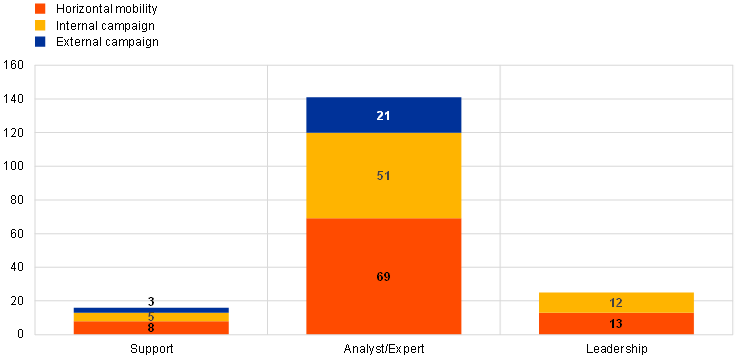
Source: ECB.
For entry-level positions at analyst level, ECB Banking Supervision often hires candidates with experience gained through traineeships. Former trainees with initial experience in banking supervision continued to be a source of talent for these positions in 2022.
ECB Banking Supervision hired 131 trainees in 2022. Included in this intake were trainees hired via two new types of traineeship campaign. In the first campaign, six Ukrainian trainees were hired to work on banking supervision topics related to the Russian invasion of Ukraine. In the second campaign, ECB Banking Supervision hired four trainees on the autism spectrum, as part of the ECB’s diversity strategy.
As part of the annual rotation exercise, 45 staff members moved to a new Joint Supervisory Team to avoid supervisory capture and to further their personal and professional development. For the first time, the Directorate General Horizontal Line Supervision was included in the exercise to further strengthen the cooperation between horizontal and vertical supervision.
5.3.2 Swap programmes
In addition to the SSM staff swap programme (see Section 5.4), banking supervision business areas joined the Schuman Programme, which enables staff from across the European System of Central Banks and European banking supervision to work in different institutions on common projects. ECB Banking Supervision proposed two projects and supported three staff members interested in joining other projects.
5.3.3 Capability building
In 2022 ECB Banking Supervision carried out an organisational readiness assessment and identified three areas for development: IT and cyber risk, climate risk and digital transformation.
This gap analysis provided the basis for the SSM capability building plan for 2023. The plan will include measures to better identify and match talent with organisational needs, training and other learning opportunities and improve the recruitment of new talent. Against this background, 17.5 positions have been allocated to the SSM flexibility pool for 2023 to support initiatives within the three areas for development.
A swap programme between the ECB and the European Insurance and Occupational Pensions Authority was launched at the end of 2022 to foster cooperation in the supervision of financial conglomerates. Two staff members from each organisation are expected to swap positions from 1 February 2023.
5.3.4 Diversity and inclusion
ECB Banking Supervision is diverse by its nature, with staff members coming from across Europe; 9% of staff have multiple nationalities, 56% are parents and 46% are women. While ECB Banking Supervision is committed to fostering diversity and inclusion from a holistic perspective, gender balance remains a key strategic priority. The share of female employees within ECB Banking Supervision varies slightly across the levels of hierarchy. At analyst level, the share of female staff remained unchanged at 50%. At expert level, it increased by 2 percentage points to 43%. At team lead level, the share fell by 1 percentage point to 32% and at management level it increased by 2 percentage points to 34%.
5.4 SSM integration
The SSM integration project was launched in 2022 and significant progress was made on several initiatives
The SSM integration project, which was approved by the ECB’s Supervisory Board in 2021, was launched in 2022 and is open to representatives from all national competent authorities (NCAs), national central banks and ECB Banking Supervision business areas. A number of initiatives were planned with the aim of further fostering a common SSM culture and career paths, creating opportunities to work more closely throughout the supervisory cycle, enhancing planning integration, further developing SSM tools for collaboration and introducing common technologies for supervision and training.
Significant progress has been made on facilitating access to information and joint IT tools, including enhanced access rights for supervisory documents (with appropriate safeguards). This improved the sharing experience on SSMnet, the intranet platform for all staff members working on European banking supervision. Contributors from all the national supervisors and ECB Banking Supervision have continued to produce new content for SSMnet. This includes sharing the key takeaways from the first European banking supervision-wide survey on collaboration within the SSM and creating a new content area to allow staff to find mobility opportunities within European banking supervision. ECB Banking Supervision received Central Banking’s 2022 Financial Stability Initiative Award for the creation of SSMnet.
In intra-SSM staff mobility, further to the SSM swap programme piloted in 2021, four pairs of staff members from the Banco de España and the ECB took part in a one-year swap in 2022. In addition, numerous opportunities were created for supervisory staff from the NCAs to work together virtually in expert groups dedicated to key supervisory topics. On the back of this positive experience, further opportunities for short-term collaboration with national supervisors are being considered for suitable projects.
In 2022 a new form of collaboration between ECB and NCAs was launched: the SSM-Hub on securitisation became operational as planned on 1 April 2022 and is now assisting the ECB with its supervision of the requirements for risk retention, transparency and resecuritisation.[75]
Closer collaboration was also fostered within the on-site inspection community, building on the ongoing cross-border collaboration. Furthermore, in a pilot scheme, two centres of competence – one for business models and profitability and another for interest rate risk in the banking book – were established with the aim of promoting closer cooperation in these risk areas.
In the area of supervisory training, new formats were introduced together with the providers INSEAD and Coursera to explore digital transformation and innovation (see Section 5.5). Further training and knowledge-sharing opportunities are expected to be created through ECB Banking Supervision’s partnership with the European University Institute.
To pave the way for closer collaboration, the supervisory planning process was revamped and now provides for stronger links with NCAs. The revised process includes periodic touch points with the Supervisory Board and the NCAs for risk analysis and priority setting as well as early guidance on prioritised vulnerabilities for operational planning and organisational readiness.
5.5 SSM digital agenda
14 suptech tools went live in 2022, supporting the work of more than 1,100 supervisors
The banking sector has become increasingly technology and data-driven, meaning European banking supervision has to keep pace and foster the use of supervisory technologies (suptech). In 2022 European banking supervision reaped meaningful benefits from the digital transformation started in 2020. The go-live of 14 suptech tools marked a major milestone for the SSM digital agenda. By the end of 2022, more than 1,100 supervisors were actively using new suptech tools to support their day-to-day work.
As a notable example, the Virtual Lab has boosted collaboration and digital exchange within European banking supervision with its modern cloud-based platform and unified suite of collaboration and communication tools for ECB and NCA staff. The Virtual Lab also fosters innovation by offering code and model sharing environments for developing data science and artificial intelligence (AI) projects. Similarly, Athena, the textual analysis platform for unstructured data, has introduced new capabilities such as topic modelling, sentiment analysis, automatic translation, text summarisation and insight engines. This has allowed supervisors to instantly process and analyse the many documents they encounter in their work. Furthermore, Agora provides a single source for all prudential data used in European banking supervision, and Navi – the self-service platform for network analytics and advanced visualisations –produces key insights from connected data, such as the ownership structures of significant institutions. These tools serve the needs of supervisors across European banking supervision and foster integration.
Dedicated digital and innovation training programmes for staff at all levels help to foster a digital culture within European banking supervision
The digital transformation also embraced cultural and staff upskilling initiatives to enable supervisors to meet current and future digital needs. In 2022, in partnership with leading academic institutions, more than 1,000 supervisors from NCAs and the ECB enrolled on training initiatives, such as the SSM AI training programme and the data science school. Different blended formats, including live sessions and e‑learning modules, ensured a state-of-the-art training experience.
These digital efforts were widely recognised externally – for the second year running the ECB was awarded a FinTech RegTech Global Award by Central Banking, winning the Cloud Innovation Award for the Virtual Lab.
As part of the Project Olympus initiative, the ECB and national supervisors are working together to build a shared, future-proof IT landscape
In 2022 European banking supervision also embarked on an ambitious initiative called Project Olympus. This aims to build the foundations for a shared and integrated IT landscape for the ECB and the national supervisors. As part of the initiative, experts have defined concrete action points for ensuring common and connected tools, seamless access and navigation across systems, common IT standards and data-driven supervision.
Finally, European banking supervision is building a suptech function for the steady state to meet the growing need for technology and data-driven supervision. The key objective is to ensure high-quality delivery, ongoing innovation and the effective adoption and development of suptech across European banking supervision.
5.6 Decision-making
5.6.1 Meetings and decisions of the Supervisory Board and Steering Committee
The Supervisory Board met 23 times in 2022
The ECB’s Supervisory Board met 23 times in 2022. Further to a loosening of pandemic restrictions, two meetings were held in Frankfurt am Main and one in Athens. All other meetings were held via videoconference. In addition, the Supervisory Board organised five seminars to exchange preliminary views on topics of supervisory relevance. Upon invitation by the Deutsche Bundesbank, the Supervisory Board also held a strategic retreat in Berlin in October 2022, where members met with the local fintech community and exchanged views on the way forward for SSM integration and possible ways to enhance supervisory effectiveness.
The Steering Committee[76] of the Supervisory Board held seven meetings in 2022, all of which were held via videoconference.
The Steering Committee held seven regular meetings, and 12 additional meetings to discuss specific topics
The Steering Committee held 12 additional meetings with a focus on digitalisation, simplification of SSM processes and SSM integration. All of these meetings were held via videoconference and participation was open to all Supervisory Board members who expressed an interest.
In 2022 the ECB took 2,582 supervisory decisions[77] concerning specific supervised entities (Figure 2). Of these, 1,360 decisions were adopted by the ECB heads of work units in line with the general framework for delegating decision-making powers for legal instruments related to supervisory tasks. 1,222 decisions were adopted by the Governing Council under the non-objection procedure on the basis of a draft proposal of the Supervisory Board. These numbers include 213 operations[78] (such as the establishment of branches) that the ECB implicitly approved by not objecting within the legal deadlines.
The bulk of the supervisory decisions were related to fit and proper assessments (44.9%), the SREP (8.7%), national powers (9.7%), internal models (8.5%), own funds (7.7%) and ad hoc reporting (4.7%).
The Supervisory Board decided on several horizontal issues, including the supervisory response to the Russian war in Ukraine
In addition to the bank-specific final draft decisions submitted to the Governing Council for adoption, the Supervisory Board decided on several horizontal issues. Most notably, these decisions related to the supervisory measures to counter the consequences of the deteriorating geopolitical situation at the beginning of the year, the preparation and implementation of the climate risk stress test, the simplification of recovery plan assessments and the revisions to the asset quality review methodology. Some of these decisions were prepared by temporary structures mandated by the Supervisory Board. These structures comprised representatives from the ECB and the NCAs and carried out preparatory work on topics such as revisions to the SREP methodology for market risk, credit risk and Pillar 2 guidance.
Moreover, some decisions by the Supervisory Board resulted in public guides, reports and reviews, such as the revised ECB Guide on options and discretions available in Union law, the Guide on the notification of securitisation transactions and the ECB report on banks’ progress towards transparent disclosure of their climate-related and environmental risk profiles.
The Supervisory Board took the majority of its decisions by written procedure.[79]
Of the 113 banking groups directly supervised by the ECB in 2022, 32 asked to receive formal ECB decisions in an EU official language other than English (the same as in 2021).
Figure 2
Decisions by the Supervisory Board in 2022
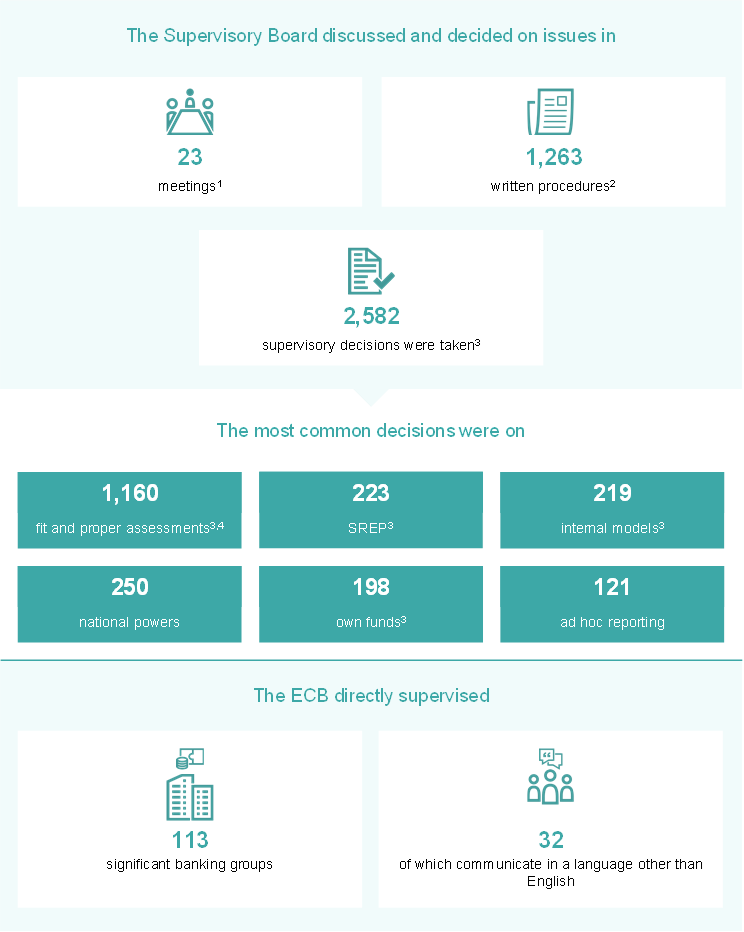
Notes:
1) In addition to its meetings, the Supervisory Board held five seminars in 2022.
2) This figure includes written procedures for individual supervisory decisions and for other issues such as common methodologies and consultations of the Supervisory Board. One written procedure may contain several supervisory decisions.
3) This is the number of individual supervisory decisions addressed to supervised entities, or their potential acquirers, and instructions to national competent authorities on significant institutions or less significant institutions. One decision may contain several supervisory approvals.
4) The 1,160 decisions on fit and proper assessments cover 2,445 individual procedures (see Section 2.2).
5.6.2 Activities of the Administrative Board of Review
The Administrative Board of Review (ABoR) is an ECB body comprising members who are individually and collectively independent from the ECB and are entrusted with the task of reviewing decisions adopted by the Governing Council on supervisory matters upon an admissible request for review.
In 2022 the ABoR received three requests for an administrative review of ECB supervisory decisions (Table 7). One of these requests was withdrawn by the applicant after the ECB clarified the matter with the applicant outside the ABoR proceedings. In the second case, the ABoR found that the request was inadmissible because the notice of review was incomplete and did not comply with the formal requirements set out in the SSM Regulation or the ABoR Decision.
In the third case, the ABoR adopted an opinion in which it proposed that the Supervisory Board should amend the contested decision, in particular to further reflect the principle of proportionality. In that case, the ABoR conducted an oral hearing on the ECB premises as part of its investigation phase, which gave the applicant and the ECB an additional opportunity to comment on the contested decision.
In December 2022, the ABoR published a document on its eight years of experience reviewing ECB supervisory decisions. The document sets out the ABoR review procedure and presents the major procedural and substantive issues and questions analysed by the ABoR and the criteria on which it based its opinions.
2022 was marked by changes in the composition of the ABoR
In 2022 the ABoR was chaired by Concetta Brescia Morra. Its other members were Pentti Hakkarainen (since 1 February 2022 and Vice-Chair), F. Javier Aríztegui Yáñez, André Camilleri and René Smits. The alternates were Christiane Campill and Damir Odak. Pentti Hakkarainen was designated Chair as of 1 January 2023. The current composition of the ABoR is available on the ECB’s banking supervision website.
5.6.3 Revised areas of interest of the ECB representatives to the Supervisory Board
The areas of interest of the ECB representatives were revised following a new appointment in 2022
Pursuant to the SSM Regulation and Decision ECB 2014/4[80], the Governing Council appoints four representatives of the ECB to the Supervisory Board, none of whom perform duties directly related to the monetary function of the ECB or duties for a NCA.
The current ECB representatives to the Supervisory Board are Kerstin af Jochnick, Edouard Fernandez-Bollo, Elizabeth McCaul and Anneli Tuominen. In their daily work, the representatives support the Chair and Vice-Chair of the Supervisory Board and represent ECB Banking Supervision internally and externally.
Following the appointment of Anneli Tuominen on 15 June 2022, the areas of interest of the ECB representatives to the Supervisory Board were revised and are allocated as shown in Table 8.
5.7 Implementing the Code of Conduct
In accordance with Article 19(3) of the SSM Regulation, the ECB has established an ethics framework for high-level ECB officials, management and staff. It comprises the single Code of Conduct for high-level ECB officials, a dedicated chapter in the ECB Staff Rules and the Guideline laying down the principles of the SSM Ethics Framework. The implementation and further development of the framework is supported by the ECB Ethics Committee, the Compliance and Governance Office (CGO) and the Ethics and Compliance Committee.
The ECB enhanced its rules on private financial transactions of high-level officials
At the proposal of the ECB’s independent Ethics Committee, in November 2022 the Governing Council adopted an enhanced Code of Conduct for high-level ECB officials, introducing additional restrictions on private financial transactions as well as enhanced transparency obligations[81]. As of 1 January 2023 high‑level officials are allowed to buy only broadly diversified instruments with a medium to long-term investment horizon and must submit lists of private financial transactions carried out during the previous calendar year.
In accordance with its mandate, the Ethics Committee carried out its yearly assessment of the Supervisory Board members’ Declarations of Interests prior to their publication on the ECB’s banking supervision website. It also responded to requests for advice submitted by high-level ECB officials involved in banking supervision and, in this context, issued 15 opinions, the majority of which concerned post-employment activities. In line with its transparency policy, the ECB continued to publish the opinions of the Ethics Committee for cases concerning conflicts of interest and post‑mandate gainful employment and, since February 2022, on envisaged private activities.[82]
The new Ethics Chatbot provides real-time ethics advice to ECB staff
In 2022 the CGO introduced an Ethics Chatbot to respond swiftly to staff with straightforward ethics queries. This automation reduced the number of requests requiring CGO staff input by almost 20%, from about 2,050 in 2021 to 1,690 in 2022. Approximately 42% of the requests for advice were submitted by ECB Banking Supervision staff.
Chart 24
Overview of requests received from ECB Banking Supervision staff in 2022
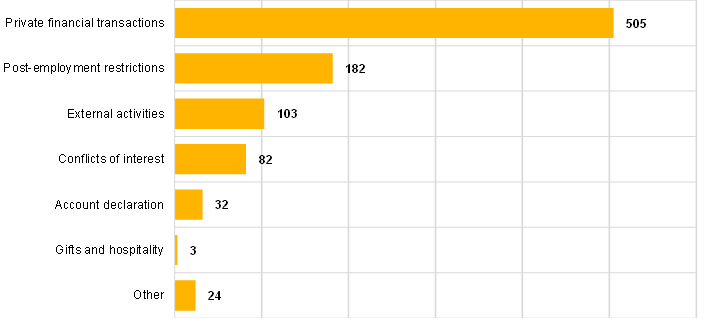
Source: ECB.
The CGO continued to provide staff with specialised training courses and e‑learning programmes and also organised information campaigns on the ethics framework, such as Ethics Awareness Week and Open Ethics Days for newcomers. The 2022 awareness campaign focused, among other topics, on the ECB’s post-employment restrictions and rules for negotiating prospective occupational activities[83]. With a view to avoiding actual or perceived “revolving door” situations, the CGO assessed possible conflicts of interest arising from staff members considering job offers from the private sector and advised on the applicable rules and mitigating measures.
Of those members of staff involved in banking supervision who resigned from their posts in 2022, three cases triggered a temporary prohibition on taking up another occupational activity in line with the ethics framework. In nine cases, additional safeguarding measures, such as reassigning tasks, transferring staff to other positions and/or cutting access rights were imposed to avoid a revolving door situation, in effect internalising the cooling-off period.
The CGO organised its regular compliance monitoring exercise on staff members’ and high-level ECB officials’ private financial transactions. As in previous years, this exercise only identified a limited number of instances of non-compliance, approximately half of which were related to ECB Banking Supervision staff. None of these instances involved intentional misconduct or other serious cases of non-compliance.
The Ethics and Compliance Committee supported a coherent implementation of the SSM ethics framework
To reflect the growing importance of ethics and compliance, the Ethics and Compliance Conference was transformed into the Ethics and Compliance Committee (ECC). Following the adoption of the enhanced SSM ethics framework in 2021, the ECC promoted a harmonised and coherent application of the new rules by the NCAs of countries participating in the SSM. To this end, the ECC supported the ongoing implementation exercise by participating in regular exchanges of views and providing advice and information on best practices.
5.8 Applying the principle of separation between monetary policy and supervisory tasks
In 2022 the principle of separation between monetary policy and supervisory tasks was mainly applied to the exchange of information between different policy areas.
In line with Decision ECB/2014/39 on the implementation of separation between the monetary policy and supervision functions of the ECB[84], this exchange of information was subject to a need-to-know requirement: each policy area had to demonstrate that the information requested was necessary to achieve its policy goals. In most cases, access to confidential information was granted directly by the ECB policy function that owned the information. This was done in line with Decision ECB/2014/39, which allows access to information pertaining to anonymised data or non-policy sensitive information to be granted by the policy functions directly. Intervention by the Executive Board to resolve possible conflicts of interest was not necessary.
Under Decision ECB/2014/39, the involvement of the Executive Board was nonetheless required in a few instances to allow for the exchange of non-anonymised information relating to individual banks or policy-sensitive assessments. Access to the data was granted on a need-to-know basis after assessing the business case, and for a limited period of time, to ensure that the need-to-know requirement was met at all times.
In 2022 an emergency provision was activated owing to the Russian invasion of Ukraine
With regard to data related to the impact of the Russian invasion of Ukraine on the banking sector, the emergency provision in Article 8 of Decision ECB/2014/39 was activated by the Executive Board in February 2022. This removed the need for the Executive Board to approve separately the sharing of related information, subject to a strict need-to-know requirement. This exemption had been applied in 2021 to several data exchanges on bank data collected in the context of the COVID-19 pandemic. As above, access to the data was granted on a need-to-know basis after assessing the business case, and for a limited period of time, to ensure that the need-to-know requirement was fulfilled at all times.
Separation at the decision-making level did not raise concerns, and no intervention by the Mediation Panel was required.
5.9 Data reporting framework
5.9.1 Developments in the data reporting framework
A new centralised submissions platform for ad hoc data collection was introduced
The ECB’s Centralised Submission Platform (CASPER) allows external organisations to securely submit structured data to the ECB via the ECB Identity Portal for central identification. The data are automatically validated, and the results can be discussed with the relevant ECB teams using the platform. CASPER had 3,100 internal and external users in 2022, thus reaching a significant use test milestone. The ECB will continue to use CASPER to collect ad hoc supervisory requests from banks, replacing less efficient processes such as email exchanges or shared folders.
In 2022 the ECB and the NCAs made significant progress in implementing measures to further harmonise common practices for the collection of supervisory data using the “sequential approach”.[85] These requirements aim to create a minimum set of common standards to harmonise the approaches taken across European banking supervision for the collection, validation and dissemination of supervisory data, and create a level playing field for supervised institutions.
The SSM-wide data collection database[86] aims to identify ways to reduce the reporting burden on banks by eliminating duplicate data requests sent by supervisors. The database was updated regularly in 2022 and was used in the thematic reviews on streamlining reporting requirements and before launching new horizontal requests to significant institutions.
The ECB improved the content and visibility of its supervisory banking statistics
In 2022 the ECB expanded the content of its quarterly supervisory banking statistics published in the supervisory data section of the banking supervision website, with new indicators on loans and advances subject to impairment review (stages) being published from April 2022. In addition, from the second quarter of 2022 the ECB started publishing the net stable funding ratio and the non-performing loans ratio excluding cash balances at central banks and other demand deposits. The visibility of the statistics was enhanced significantly with the addition of a visual banner on the homepage of the ECB’s banking supervision website, providing insights into key metrics at a glance. For the first time, the ECB also published individual entity Pillar 3 information on selected counterparty credit risk disclosure templates. The ECB carried out a reconciliation exercise between the selected Pillar 3 disclosures and regulatory reporting, which resulted in substantial improvements in data consistency.
5.9.2 Information management
The SSM Information Management System (IMAS) is an integrated suite of core IT systems used daily by European banking supervisors and the institutions they supervise. The suite comprises the process applications for supervisors to conduct their daily tasks (IMAS), a reporting and analytics service to retrieve and work with supervisory reporting (IDRA) and an internet application for supervised banks to connect digitally with supervisors by submitting applications and notifications via online forms (IMAS portal). IMAS integrates newly developed suptech tools where relevant and needed.
In 2022 IMAS continued to evolve in line with changes in the financial system and its regulatory framework and with changes to the SSM methodology and strategy. The new developments in 2022 affected core supervisory processes and included (i) new procedures added to IMAS to reflect the updated SREP methodology for 2022; (ii) enhancements to the reporting output received by SSM decision-making bodies; (iii) a new module for the significance assessment and register of institutions; (iv) a revamp of the module for tracking and monitoring supervisory findings and related supervisory measures; and (v) implementation of special elements related to fit and proper assessments. In parallel, significant technical developments in the core infrastructure of IMAS were carried out to enable its integration with other ECB systems, such as suptech applications.
In 2022 the IMAS portal was enriched with new supervisory processes, specifically the submission of applications for new licences of credit institutions and investment firms, approvals and exemptions of financial holding companies for significant supervised groups, and voluntary withdrawals of a licence, as well as notifications of non-material model changes and notifications of outsourcing arrangements. Additional developments in procedures already being processed via the IMAS portal include a unified entry form for fit and proper applications and an improved entry form for passporting applications in line with the updated European Banking Authority guidelines.
6 Reporting on budgetary consumption
6.1 Expenditure for 2022
The SSM Regulation requires the ECB to dedicate adequate resources to carrying out its supervisory tasks effectively. These resources are financed via a supervisory fee borne by the entities subject to direct and indirect supervision by the ECB.
The expenditure incurred for supervisory tasks is separately identifiable within the ECB’s budget. The expenditure incurred consists of the direct expenses of the ECB Banking Supervision function. The supervisory function also relies on shared services provided by the ECB’s existing support business areas[87].
The budgetary authority of the ECB is vested in its Governing Council. The Governing Council adopts the ECB’s annual budget, following a proposal by the Executive Board in consultation with the Chair and the Vice-Chair of the Supervisory Board for matters related to banking supervision. The Governing Council is assisted by the Budget Committee, which consists of members from all the national central banks of the Eurosystem and the ECB. The Budget Committee assists the Governing Council by providing it with evaluations of the ECB’s reports on budget planning and monitoring.
In 2022 the actual annual expenditure for ECB supervisory tasks was €593.8 million, 4.9% less than the estimate of €624.1 million communicated in March 2022.
Expenditure on supervisory tasks increased slightly in 2022, reflecting the gradual return to more normal levels of activity
Spending on supervisory tasks in 2022 increased by 2.8% compared with 2021, when it stood at €577.5 million. This reflects the ongoing gradual return to more normal levels of activity in banking supervision, particularly in relation to the direct supervision of significant institutions, where the number of on-site inspections has returned to pre-pandemic levels (see Section 1.3.2). The increase in horizontal tasks and specialised services costs can be attributed to the ongoing developments in and improvements to IT systems dedicated to banking supervision. More information on these activities can be found in Section 5.9.
Table 9
Cost of the ECB’s supervisory tasks by function (2020-22)
(EUR millions)

Source: ECB.
Note: Totals and subtotals in the table may not add up owing to rounding.
The classifications provided in Table 9 are used to identify the split of the annual costs to be recovered through annual supervisory fees from supervised entities based on their supervisory status as significant or less significant. The methodology defined in Article 8 of the Fees Regulation[88] for the split of annual supervisory fees provides that the costs associated with horizontal tasks and specialised services are allocated proportionally, based on the full cost for the supervision of significant institutions and the cost of overseeing the supervision of less significant institutions respectively. For each grouping, the costs reported include the allocation of shared services provided by the ECB’s support business areas.
Table 10 provides more granular information on the expenditure based on the activities performed, in particular:
- off-site supervision and surveillance, incorporating the costs of the ECB’s participation in Joint Supervisory Teams and the oversight activities of less significant banks or banking groups;
- the ECB’s participation in on-site inspections, including cross-border missions;
- policy, advisory and regulatory functions, including significance assessments, authorisations, cooperation with other agencies, methodology and planning, supervisory quality assurance, and enforcement and sanctioning procedures;
- crisis management;
- macroprudential tasks, including those related to stress testing and supervisory policies;
- supervisory statistics relating to the data reporting framework;
- decision-making of the Supervisory Board, its Secretariat and legal services.
Table 10
Expenditure incurred for ECB supervisory tasks
(EUR millions)
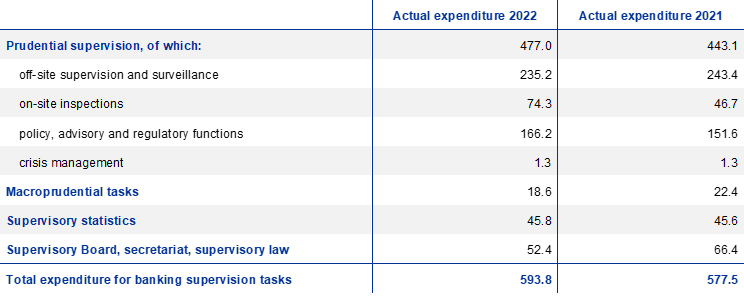
Source: ECB.
Note: Totals and subtotals in the table may not add up owing to rounding.
Expenditure on on-site inspections increased by almost 60% in 2022, reflecting a post-lockdown return to more normal on-site activities, with the number of on-site inspections returning to pre-pandemic levels. The ongoing improvements to IT systems dedicated to banking supervision increased costs within the policy, advisory and regulatory functions. Also reflected in these functions is a reallocation of costs related to supervisory technologies (suptech projects) from the Supervisory Board, secretariat and supervisory law function in 2022. Increases in expenditure within prudential supervision were partially offset by a decrease in expenditure on macroprudential tasks, as the biennial European Banking Authority stress test was not conducted in 2022.
To supplement its internal resources, the ECB engages external consultancy support services to provide either specialised expertise or integrated consultancy under qualified internal guidance to address temporary resource shortages. In 2022 the ECB spent €40.8 million on consultancy services for core supervisory tasks, an increase of €2.0 million compared with 2021. This expenditure included €13.2 million on developments in IT systems, €7.0 million on comprehensive assessments and €20.0 million for the conduct of on-site supervision tasks, including cross-border missions. More information on these activities can be found in Chapter 1. In addition, consultancy costs of €10.4 million were directly allocated to banking supervision. These costs derived from areas that support the banking supervision function and were primarily related to the running and evolutionary maintenance of IT systems.
In 2022 there was a significant increase in expenditure on business travel related to supervision activities for significant institutions and less significant institutions, with expenditure amounting to €6.8 million, up from €0.3 million in 2021. This reflects the return to more normal levels of on-site supervisory activities.
The split of costs between expenditure directly attributable to ECB Banking Supervision and expenditure on shared services was broadly similar to the previous year (Chart 25).
The directly attributable expenditure is composed of core supervisory staff costs, supervisory initiatives (including costs related to comprehensive assessments), other operating expenditure such as business travel and training, dedicated information technology such as IMAS and the Stress Test Account Reporting platform (STAR) and related projects, and suptech.
The shared services category encompasses services that are used by both the central banking function and the banking supervision function, clustered as follows: premises and facilities services, human resources services, shared information technology services, shared legal, audit and administrative services, communication and translation services, and other services. The cost of these shared services is split between each function using a cost allocation mechanism applying industry standard metrics such as full-time equivalents, office space and volume of translation requests. As the ECB is committed to rigorously pursuing efficiency improvements, it routinely refines the cost allocation metrics.
In 2022 total actual expenditure was €593.8 million. Directly attributable expenditure amounted to €351.4 million, and shared services amounted to €242.4 million, respectively 59.2% and 40.8% of the actual expenditure incurred (which is broadly similar to 2021, when they were 58.5% and 41.5% respectively).
The amortisation of IMAS and STAR contributed to increased expenditure on directly attributable information technology and related projects, amounting to €22.9 million in 2022. Directly attributable expenditure on suptech accounted for €20.8 million. The increase in other operating expenditure reflects expenses arising from the gradual return to more normal levels of on-site supervisory activities.
In 2022 expenditure on shared services increased slightly, by €2.8 million, compared with 2021. The increase can be seen across most of the cost categories, again mainly reflecting the return to more normal activity levels.
6.2 Outlook for banking supervision fees in 2023
The ECB estimates that it will spend €649.0 million on supervisory tasks in 2023
Taking into consideration past and expected consumption of the planned expenditure, the ECB has continued its conservative approach when estimating expenditure for 2023, resulting in an estimated supervisory fee for 2023 of €649.0 million. The ECB’s budget ceiling for supervisory tasks in 2023 is €705.6 million. This estimate takes into consideration the expected ongoing return to more normal levels of activity, the introduction of new IT services related to the ongoing investment in suptech projects, as well as the internalisation of consultancy costs associated with on-site and internal model investigations, which are offset by a reduction in consultancy expenditure.
In line with its commitment to cost stabilisation for the whole organisation by 2023, the ECB envisages stabilisation in planned expenditure for its current mandates. However, it will remain flexible in its response to unexpected external factors. There are measures in place to ensure that the ECB remains within the stabilisation target, also considering the impact of inflation.
Table 11
Estimated cost of ECB Banking Supervision in 2023 by function
(EUR millions)

Source: ECB.
Note: Totals and subtotals in the table may not add up owing to rounding.
The annual supervisory fee for 2023, to be levied in 2024, will only be known at the end of the fee period and will comprise the actual expenditure for the full year 2023 adjusted for amounts reimbursed to or collected from individual banks for previous fee periods, late payment interest and non-collectable fees. The ratio of the total amount to be levied to each category in 2023 is estimated to be 95.3% for significant institutions and 4.7% for less significant institutions.
Table 12
2023 estimate of expenditure for the ECB’s supervisory tasks
(EUR millions)

Source: ECB.
Note: Totals and subtotals in the table may not add up owing to rounding.
6.3 Fee framework for 2022
Together with the SSM Regulation, the Fees Regulation provides the legal framework within which the ECB levies an annual supervisory fee for the expenditure it incurs while conducting its supervisory tasks. The Fees Regulation and associated Decision[89] establish the methods for (i) determining the total amount of the annual supervisory fee; (ii) calculating the amount to be paid by each supervised institution; and (iii) collecting the annual supervisory fee.
6.3.1 Total amount to be levied for the fee period 2022
The annual supervisory fee to be levied for the fee period 2022 amounts to €593.7 million. This is almost completely composed of the actual annual cost for 2022, amounting to €593.8 million, with adjustments of €37,690 for a (net) reimbursement to individual banks for previous fee periods and €133,955 for late payment interest received, amounting to an overall adjustment of €96,265.
The annual supervisory fee can also be adjusted for amounts written off that were not collectable. Such an adjustment was not necessary in 2022.
The amount to be recovered via annual supervisory fees is split into two parts. This split is related to the status of supervised entities as either significant or less significant, reflecting the varying degrees of supervisory scrutiny they are subject to by the ECB. Expenditure is allocated to the institution categories based on a methodology that allows for ongoing enhancements and timely adjustments, ensuring that the allocation continuously improves over time.
For 2022 the total amount to be levied to significant institutions is €566.7 million; for less significant institutions it is €27.0 million, representing 95.5% and 4.5% respectively of the total cost of banking supervision.
Table 13
Total income from banking supervision tasks
(EUR millions)

Source: ECB.
Note: Totals and subtotals in the table may not add up owing to rounding.
6.3.2 Individual supervisory fees
At bank level, the fees are calculated according to a bank’s importance and risk profile using annual fee factors for the supervised banks. For most banks the reference date for the data is 31 December of the previous year. For banks that are newly supervised at the highest level of consolidation within the fee period, the ECB takes into account the total assets and total risk exposure reported by the bank at the reference date closest to 31 December. It then uses these figures to calculate a variable fee component for all months for which a supervisory fee is payable by the fee debtor.[90] The supervisory fee calculated per bank is then charged via annual payments.
Figure 3
The variable fee component is determined by a bank’s importance and risk profile
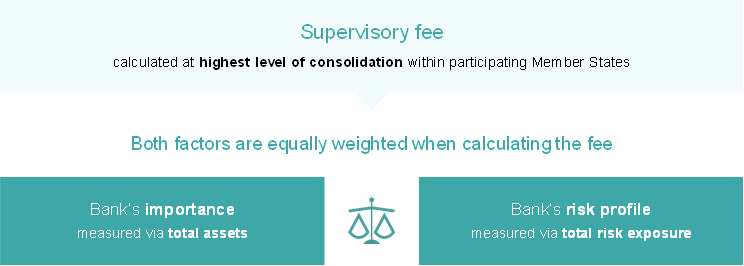
The supervisory fee is set at the highest level of consolidation within Member States participating in the Single Supervisory Mechanism. It contains a variable fee component and a minimum fee component. The latter applies equally to all banks and is based on 10% of the total amount to be recovered. For the smallest significant banks, with total assets of €10 billion or less, and the smaller less significant banks, with total assets of €1 billion or less, the minimum fee component is halved.
Article 7 of the Fees Regulation provides that the following changes in the situation of an individual bank require an amendment of the corresponding supervisory fee: (i) a change in the supervisory status of the supervised entity, i.e. the entity is reclassified from significant to less significant or vice versa; (ii) a new supervised entity is authorised; or (iii) an existing authorisation is withdrawn. The move to ex post invoicing means that the majority of changes related to Article 7 that occur within the year are included in the standard fee calculations. As a result, new supervisory fee decisions by the ECB totalled only €37,690 in 2022, and are included in the annual supervisory fees to be invoiced for the fee period 2022.
More information on supervisory fees is available on the ECB’s banking supervision website. These pages are updated regularly with useful, practical information and are published in all official EU languages.
6.4 Other income related to banking supervisory tasks
The ECB is entitled to impose administrative penalties on supervised entities for failure to comply with applicable EU banking law on prudential requirements (including ECB supervisory decisions). The related income is not taken into account in the calculation of the annual supervisory fees, nor are reimbursements of such penalties in the event that previous sanction decisions are amended or annulled. Instead, the related amounts are recorded in the ECB’s profit and loss account. In 2022 the income arising from penalties imposed on supervised entities amounted to €12.2 million.
7 Legal instruments adopted by the ECB
The legal instruments adopted by the ECB include regulations, decisions, guidelines, recommendations and instructions to NCAs (mentioned in Article 9(1), third subparagraph, of the SSM Regulation and Article 22 of the SSM Framework Regulation). This section lists the legal instruments concerning banking supervision that were adopted in 2022 by the ECB and published in the Official Journal of the European Union and on EUR-Lex. It covers legal instruments adopted pursuant to Article 4(3) of the SSM Regulation and other relevant legal instruments.
7.1 ECB regulations
ECB/2022/14
Regulation (EU) 2022/504 of the European Central Bank of 25 March 2022 amending Regulation (EU) 2016/445 on the exercise of options and discretions available in Union law (ECB/2016/4) (ECB/2022/14) (OJ L 102, 30.3.2022, p. 11)
7.2 ECB legal instruments other than regulations
ECB/2022/2
Decision (EU) 2022/134 of the European Central Bank of 19 January 2022 laying down common rules on the transmission by the European Central Bank of supervisory information to authorities and bodies for the purpose of carrying out the tasks conferred on it by Council Regulation (EU) No 1024/2013 (ECB/2022/2) (OJ L 20, 31.1.2022, p. 275)
ECB/2022/6
Decision (EU) 2022/368 of the European Central Bank of 18 February 2022 amending Decision (EU) 2015/2218 on the procedure to exclude staff members from the presumption of having a material impact on a supervised credit institution’s risk profile (ECB/2022/6) (OJ L 69, 4.3.2022, p. 117)
ECB/2022/7
Decision (EU) 2022/514 of the European Central Bank of 1 March 2022 on the total amount of annual supervisory fees for 2021 (ECB/2022/7) (OJ L 103, 31.3.2022, p. 14)
ECB/2022/12
Guideline (EU) 2022/508 of the European Central Bank of 25 March 2022 amending Guideline (EU) 2017/697 of the European Central Bank on the exercise of options and discretions available in Union law by national competent authorities in relation to less significant institutions (ECB/2017/9) (ECB/2022/12) (OJ L 102, 30.3.2022, p. 34)
ECB/2022/13
Recommendation of the European Central Bank of 25 March 2022 amending Recommendation ECB/2017/10 on common specifications for the exercise of some options and discretions available in Union law by national competent authorities in relation to less significant institutions (ECB/2022/13) (OJ C 142, 30.3.2022, p. 1)
ECB/2022/33
Decision (EU) 2022/1981 of the European Central Bank of 10 October 2022 on the use of services of the European System of Central Banks by competent authorities (ECB/2022/33) (OJ L 272, 20.10.2022, p. 22)
ECB/2022/34
Decision (EU) 2022/1982 of the European Central Bank of 10 October 2022 on the use of services of the European System of Central Banks by competent authorities and by cooperating authorities, and amending Decision ECB/2013/1 (ECB/2022/34) (OJ L 272, 20.10.2022, p. 29)
© European Central Bank, 2023
Postal address 60640 Frankfurt am Main, Germany
Telephone +49 69 1344 0
Website www.bankingsupervision.europa.eu
All rights reserved. Reproduction for educational and non-commercial purposes is permitted provided that the source is acknowledged.
For specific terminology please refer to the SSM glossary (available in English only).
PDF ISBN 978-92-899-5548-5, ISSN 2443-5805, doi:10.2866/118680, QB-BU-23-001-EN-N
HTML ISBN 978-92-899-5549-2, ISSN 2443-5805, doi:10.2866/704273, QB-BU-23-001-EN-Q
See also “Statement regarding supervisory cooperation on operational resilience”, Letter to banks, ECB Banking Supervision, December 2020.
“Identification and measurement of credit risk in the context of the coronavirus (COVID-19) pandemic”, Letter to banks, ECB Banking Supervision, 4 December 2020.
For more information on the outcomes of the commercial real estate targeted review, see “Commercial real estate: connecting the dots”, Supervision Newsletter, ECB Banking Supervision, August 2022.
The sample refers to the 29 SIs that are subject to quarterly reporting via the Leveraged Finance Dashboard.
Transactions with a leverage level – defined as the ratio of total debt to EBITDA – that is 6.0 times in excess of that at deal inception.
Opinion of the European Central Bank of 19 February 2021 on a proposal for a regulation on Markets in Crypto-assets, and amending Directive (EU) 2019/1937 (CON/2021/4) (OJ C 152, 29.4.2021, p. 1).
Proposal for a regulation of the European Parliament and of the Council on digital operational resilience for the financial sector and amending Regulations (EC) No 1060/2009, (EU) No 648/2012, (EU) No 600/2014 and (EU) No 909/2014 (COM/2020/595 final).
“Proposal for a Regulation laying down harmonised rules on artificial intelligence”, European Commission, April 2021.
“SSM supervisory statement on governance and risk appetite”, ECB Banking Supervision, June 2016.
See “Strengthening smaller banks’ governance”, Supervision Newsletter, ECB Banking Supervision, May 2022.
The Digital Operational Resilience Act establishes a new framework to improve the operational resilience of financial institutions.
“Walking the talk – banks gearing up to manage risks from climate change and environmental degradation”, ECB, November 2022.
“Good practices for climate-related and environmental risk management – observations from the 2022 thematic review”, ECB, November 2022.
“ECB sets deadlines for banks to deal with climate risks”, press release, ECB, 2 November 2022.
See “2022 climate risk stress test”, ECB Banking Supervision, July 2022.
See “ECB report on good practices for climate stress testing”, ECB Banking Supervision, December, 2022.
Where permitted by sanitary conditions and on a voluntary basis for the inspection teams, putting the health and safety of staff first.
A campaign clusters together several OSIs examining the same topic and thus provides a framework for inspection teams to coordinate and collaborate by aligning objectives and capitalising on synergies.
Further details on ECB Banking Supervision’s CRE activities can be found in the article entitled “Commercial real estate: connecting the dots”, published in the August 2022 Supervision Newsletter.
The analysis was conducted on a sample of 132 OSIs for which final reports were submitted to the inspected entities between October 2021 and September 2022.
Some of the most critical findings relating to internal governance were identified in OSIs focused primarily on other risk areas (e.g. IT risk, capital risk and business model and profitability risk).
Further details on the topic of IT and cyber risk can be found in the presentation entitled “IT and cyber risk – key observations”, ECB, 2022.
Risk-not-in-the-model-engine is a concept introduced and defined in Section 7 of the ECB guide to internal models, ECB, October 2019.
The margin period of risk means “the time period from the most recent exchange of collateral covering a netting set of transactions with a defaulting counterparty until the transactions are closed out and the resulting market risk is re-hedged”. See Article 272(9) of the Capital Requirements Regulation (Regulation (EU) No 575/2013 of the European Parliament and of the Council of 26 June 2013 on prudential requirements for credit institutions and amending Regulation (EU) No 648/2012 (OJ L 176, 27.6.2013, p. 1).
High-NPL banks are those with an NPL ratio above 5%. See “EBA Guidelines on management of non-performing and forborne exposures”, EBA, October 2018.
Council Regulation (EU) No 1024/2013 of 15 October 2013 conferring specific tasks on the European Central Bank concerning policies relating to the prudential supervision of credit institutions (OJ L 287, 29.10.2013, p. 63).
“ECB Governing Council statement on macroprudential policies”, ECB, December 2022.
“ECB response to the European Commission’s call for advice on the review of the EU macroprudential framework”, ECB, March 2022.
“EBA advice on the review of the macroprudential framework”, EBA, April 2022 and “Review of the EU Macroprudential Framework for the Banking Sector – response to the call for advice”, ESRB, March 2022.
“Basel Committee finalises principles on climate-related financial risks, progresses work on specifying cryptoassets’ prudential treatment and agrees on way forward for the G-SIB assessment methodology review”, press release, Bank for International Settlements, 31 May 2022.
“Governing Council statement on the treatment of the European banking union in the assessment methodology for global systemically important banks”, ECB, June 2022.
BNP Paribas, Deutsche Bank, Groupe BPCE, Groupe Crédit Agricole, ING Bank, Santander, Société Générale and UniCredit. Compared with the previous year, the assigned capital buffer requirement for BNP Paribas decreased from 2.0% to 1.5%. This reduced capital buffer requirement applies as of 1 January 2023.
“Governing Council statement on macroprudential policies”, ECB, November 2022.
Warning of the European Systemic Risk Board of 22 September 2022 on vulnerabilities in the Union financial system (ESRB/2022/7).
Recommendation of the European Systemic Risk Board of 1 December 2022 on vulnerabilities in the commercial real estate sector in the European Economic Area (ESRB/2022/9).
Recommendation of the European Systemic Risk Board of 27 May 2020 on restriction of distributions during the COVID-19 pandemic (ESRB/2020/7) and Recommendation of the European Systemic Risk Board of 15 December 2020 amending Recommendation ESRB/2020/07 on restriction of distributions during the COVID-19 pandemic (ESRB/2020/15).
“2022 climate risk stress test”, ECB Banking Supervision, July 2022.
“Walking the talk – banks gearing up to manage risks from climate change and environmental degradation”, ECB, November 2022.
Regulation (EU) No 468/2014 of the European Central Bank of 16 April 2014 establishing the framework for cooperation within the Single Supervisory Mechanism between the European Central Bank and national competent authorities and with national designated authorities (SSM Framework Regulation) (ECB/2014/17) (OJ L 141, 14.5.2014, p. 1).
These criteria are set out in Article 6(4) of the SSM Regulation.
The list of significant and less significant institutions published on 21 December 2022 reflects (i) the significance decisions notified to the supervised institutions before 30 November 2022, and (ii) other changes and developments in group structures effective before 1 November 2022.
Directive 2013/36/EU of the European Parliament and of the Council of 26 June 2013 on access to the activity of credit institutions and the prudential supervision of credit institutions and investment firms, amending Directive 2002/87/EC and repealing Directives 2006/48/EC and 2006/49/EC (OJ L 176, 27.6.2013, p. 338).
Regulation (EU) 2019/876 of the European Parliament and of the Council of 20 May 2019 amending Regulation (EU) No 575/2013 as regards the leverage ratio, the net stable funding ratio, requirements for own funds and eligible liabilities, counterparty credit risk, market risk, exposures to central counterparties, exposures to collective investment undertakings, large exposures, reporting and disclosure requirements, and Regulation (EU) No 648/2012 (OJ L 150, 7.6.2019, p. 1).
Some decisions cover more than one authorisation assessment (e.g. acquisitions of qualifying holdings in different subsidiaries resulting from a single transaction). Some authorisation procedures do not require a formal ECB decision, including passporting and lapsing procedures.
These are procedures which are subject to the delegation frameworks approved under Decision (EU) 2021/1438 of the European Central Bank of 3 August 2021 amending Decision (EU) 2017/935 on delegation of the power to adopt fit and proper decisions and the assessment of fit and proper requirements (ECB/2021/34) (OJ L 314, 6.9.2021, p. 3) and Decision (EU) 2021/1440 of the European Central Bank of 3 August 2021 amending Decision (EU) 2019/1376 on delegation of the power to adopt decisions on passporting, acquisition of qualifying holdings and withdrawal of authorisations of credit institutions (ECB/2021/36) (OJ L 314, 6.9.2021, p. 14).
Of these, 85 were approved by senior management within the framework for delegation.
Directive (EU) 2019/878 of the European Parliament and of the Council of 20 May 2019 amending Directive 2013/36/EU as regards exempted entities, financial holding companies, mixed financial holding companies, remuneration, supervisory measures and powers and capital conservation measures (OJ L 150, 7.6.2019, p. 253).
See “Licensing of crypto-asset activities”, Supervision Newsletter, ECB Banking Supervision, August 2022.
Of the 23 decisions taken by the ECB in 2021, only one related to a newly established (mixed) financial holding company.
In 2022 supervisors and banks also started to use the IMAS portal for other procedures such as non-material model changes, as described in Section 5.9.2.
“Reassessing the suitability of bank directors – lessons from 2021”, Supervision Newsletter, ECB Banking Supervision, February 2022.
“Risk management and internal controls” comprises the mechanisms or processes that an entity needs to have in place for the adequate identification, management and reporting of the risks it is or might be exposed to. “Management body functions” refers to the extent to which the persons who effectively direct the business of an institution – or those who are empowered to set the institution’s strategy, objectives and overall direction, and oversee and monitor management decision-making – comply with their responsibilities.
Regulation (EU) No 806/2014 of the European Parliament and of the Council of 15 July 2014 establishing uniform rules and a uniform procedure for the resolution of credit institutions and certain investment firms in the framework of a Single Resolution Mechanism and a Single Resolution Fund and amending Regulation (EU) No 1093/2010 (OJ L 225, 30.7.2014, p. 1).
See “ECB assesses that Sberbank Europe AG and its subsidiaries in Croatia and Slovenia are failing or likely to fail”, press release, ECB Banking Supervision, 28 February 2022. See also FOLTF assessment of Sberbank Europe AG, FOLTF assessment of Sberbank banka d.d. (Croatia) and FOLTF assessment of Sberbank banka d.d. (Slovenia).
“Sberbank Europe AG: Croatian and Slovenian subsidiaries resume operations after being sold while no resolution action is required for Austrian parent company”, press release, Single Resolution Board, 1 March 2022.
“ECB takes decisions related to RCB Bank phasing out its banking operations”, press release, ECB Banking Supervision, 24 March 2022. See also the letter of 6 April 2022 from Andrea Enria, Chair of the Supervisory Board, to Mr Grant, Mr Rinaldi and Mr Zanni, on banking supervision.
“ECB withdraws banking licence of RCB Bank”, press release, ECB Banking Supervision, 22 December 2022.
Decision (EU) 2022/134 of the European Central Bank of 19 January 2022 laying down common rules on the transmission by the European Central Bank of supervisory information to authorities and bodies for the purpose of carrying out the tasks conferred on it by Council Regulation (EU) No 1024/2013 (ECB/2022/2) (OJ L 20, 31.01.2022, p. 275).
“ECB boosts cooperation with the six EU Member States not part of European banking supervision”, press release, ECB Banking Supervision, 25 January 2023.
Opinion of the European Central Bank of 27 April 2022 on the Proposal for a Directive of the European Parliament and of the Council amending Directive 2013/36/EU as regards supervisory powers, sanctions, third-country branches, environmental, social and governance risk (CON/2022/16) (OJ C 248, 30.6.2022, p. 87); Opinion of the European Central Bank of 24 March 2022 on a proposal for amendments to Regulation (EU) No 575/2013 of the European Parliament and of the Council as regards requirements for credit risk, credit valuation adjustment risk, operational risk, market risk and the output floor (CON/2022/11) (OJ C 233, 16.6.2022, p. 14); and Opinion of the European Central Bank of 13 January 2022 on a proposal to amend Regulation (EU) No 575/2013 on prudential requirements for credit institutions and investment firms with respect to resolution (CON/2022/3) (OJ C 122, 17.3.2022, p. 33).
See also Elderson, F., “Mind the gap, close the gap – the ECB’s views on the banking package reforms”, The Supervision Blog, 28 April 2022.
Campa, J.M. and Enria, A., “Strong rules, strong banks: let’s stick to our commitments”, The Supervision Blog, 4 November 2022.
On 27 June 2022 the Governing Council of the ECB released a statement on the treatment of the European banking union in the assessment methodology for global systemically important banks. The annex to this statement details the methodology that will be used for exercising supervisory discretion regarding cross-border intra-European banking union exposures in the G-SIB assessment framework.
Directive 2013/36/EU of the European Parliament and of the Council of 26 June 2013 on access to the activity of credit institutions and the prudential supervision of credit institutions and investment firms, amending Directive 2002/87/EC and repealing Directives 2006/48/EC and 2006/49/EC (OJ L 176, 27.6.2013, p. 338) and EBA Guidelines on common procedures and methodologies for the supervisory review and evaluation process (SREP) and supervisory stress testing under Directive 2013/36/EU (EBA/GL/2022/03).
In particular, the ECB shares information with AML/CFT authorities under the Multilateral agreement on the practical modalities for exchange of information pursuant to Article 57a(2) of Directive (EU) 2015/849 and the EBA Guidelines on cooperation and information exchange between prudential supervisors, AML/CFT supervisors and financial intelligence units under Directive 2013/36/EU (EBA/GL/2021/15), as well as within the AML/CFT colleges established pursuant to the Joint guidelines on cooperation and information exchange for the purpose of Directive (EU) 2015/849 between competent authorities supervising credit and financial institutions (AML/CFT Colleges Guidelines) (JC 2019 81), in which the ECB participates as an observer.
Directive (EU) 2015/849 of the European Parliament and of the Council of 20 May 2015 on the prevention of the use of the financial system for the purposes of money laundering or terrorist financing, amending Regulation (EU) No 648/2012 of the European Parliament and of the Council, and repealing Directive 2005/60/EC of the European Parliament and of the Council and Commission Directive 2006/70/EC (OJ L 141, 5.6.2015, p. 73).
Guidelines on cooperation and information exchange between prudential supervisors, AML/CFT supervisors and financial intelligence units under Directive 2013/36/EU (EBA/GL/2021/15).
See “Anti-money laundering and countering the financing of terrorism legislative package”, Directorate General for Financial Stability, Financial Services and Capital Markets Union, European Commission, 20 July 2021.
Opinion of the European Central Bank of 16 February on a proposal for a regulation establishing the Authority for Anti-Money Laundering and Countering the Financing of Terrorism (CON/2022/4) (OJ C 210, 25.5.2022, p. 5); and Opinion of the European Central Bank of 16 February on a proposal for a directive and a regulation on the prevention of the use of the financial system for the purposes of money laundering or terrorist financing (CON/2022/5) (OJ C 210, 25.5.2022, p. 15).
See Fernandez-Bollo, E., “For a fully fledged European anti-money laundering authority”, The Supervision Blog, ECB Banking Supervision, 21 February 2022 and Fernandez-Bollo, E. and McCaul, E., “Enhancing cooperation in the fight against money laundering”, The Supervision Blog, ECB Banking Supervision, 24 May 2022.
See “Feedback on the input provided by the European Parliament as part of its ‘Resolution on Banking Union – Annual Report 2021’”, ECB Banking Supervision, 2022.
See Written overview ahead of the exchange of views of the Chair of the Supervisory Board of the ECB with the Eurogroup on 4 April 2022 and Written overview ahead of the exchange of views of the Chair of the Supervisory Board of the ECB with the Eurogroup on 7 November 2022.
“Single Supervisory Mechanism – Good start but further improvements needed”, ECA Special Report, No 29, European Court of Auditors, 2016, and “The operational efficiency of the ECB’s crisis management for banks”, ECA Special Report, No 2, European Court of Auditors, 2018.
See Annex 3.2 of “Report on the performance of the EU budget – Status at the end of 2021”, European Court of Auditors, November 2022.
As set out under Articles 6, 7 and 8 of the Securitisation Regulation.
The Steering Committee supports the activities of the Supervisory Board and prepares the Board’s meetings. It is composed of the Chair of the Supervisory Board, the Vice-Chair of the Supervisory Board, one ECB representative and five representatives of national supervisors. The five representatives of national supervisors are appointed by the Supervisory Board for one year based on a rotation system that ensures a fair representation of countries.
These decisions refer to decisions that were finalised or adopted in the reporting period (i.e. outgoing decisions). The number of supervisory decisions does not correspond to the number of authorisation procedures that were officially notified to the ECB in the reporting period (i.e. incoming notification procedures). One decision may contain several supervisory approvals.
Of these, 179 were approved by senior management within the framework for delegation.
Under Article 6.7 of the Supervisory Board’s Rules of Procedure, decisions may also be taken by written procedure, unless at least three members of the Supervisory Board who have a voting right object. In such cases, the item is put on the agenda of the subsequent Supervisory Board meeting. A written procedure normally requires at least five working days for consideration by the Supervisory Board.
Decision of the European Central Bank of 6 February 2014 on the appointment of representatives of the European Central Bank to the Supervisory Board (ECB/2014/4) (2014/427/EU) (OJ L 196, 3.7.2014, p. 38).
See “ECB publishes enhanced rules for private financial transactions of high-level officials”, press release, ECB, 16 December 2022.
Articles 7, 11, 12 and 17 of the single Code of Conduct for high-level ECB officials.
Article 0.2.8.1 of the ECB Staff Rules.
Decision of the European Central Bank of 17 September 2014 on the implementation of separation between the monetary policy and supervision functions of the European Central Bank (ECB/2014/39) (2014/723/EU) (OJ L 300, 18.10.2014, p. 57).
The Task Force on the Harmonisation of the Sequential Approach aims to provide a level playing field across the SSM. It identifies the best practices of each country and proposes harmonised best practices that can be adopted by all NCAs and the ECB.
The SSM-wide data collection database is an initiative to streamline the supervisory reporting requirements set by the ECB and NCAs and improve internal governance. It collects information on all of the data requests sent to directly supervised institutions, which is then used to increase the transparency of data requests sent to banks and to analyse the reporting burden.
These are broken down as premises and facilities services, human resources services, shared information technology services, shared legal, audit and administrative services, communication and translation services and other services.
Regulation (EU) No 1163/2014 of the European Central Bank of 22 October 2014 on supervisory fees (ECB/2014/41) (OJ L 311 31.10.2014, p. 23).
Decision (EU) 2019/2158 of the European Central Bank on the methodology and procedures for the determination and collection of data regarding fee factors used to calculate annual supervisory fees (ECB/2019/38) (OJ L 327, 17.12.2019, p. 99).
For entities established after 1 October, the supervisory fee charged consists of a minimum fee component for the number of full months supervised only.


